MIDO's Multifort TV Big Date is not just a watch; it's a bold statement, combining hypnotic style with infallible resistance. It's the perfect everyday watch, adding a touch of sophistication and originality to your daily routine. Let's have a closer look!
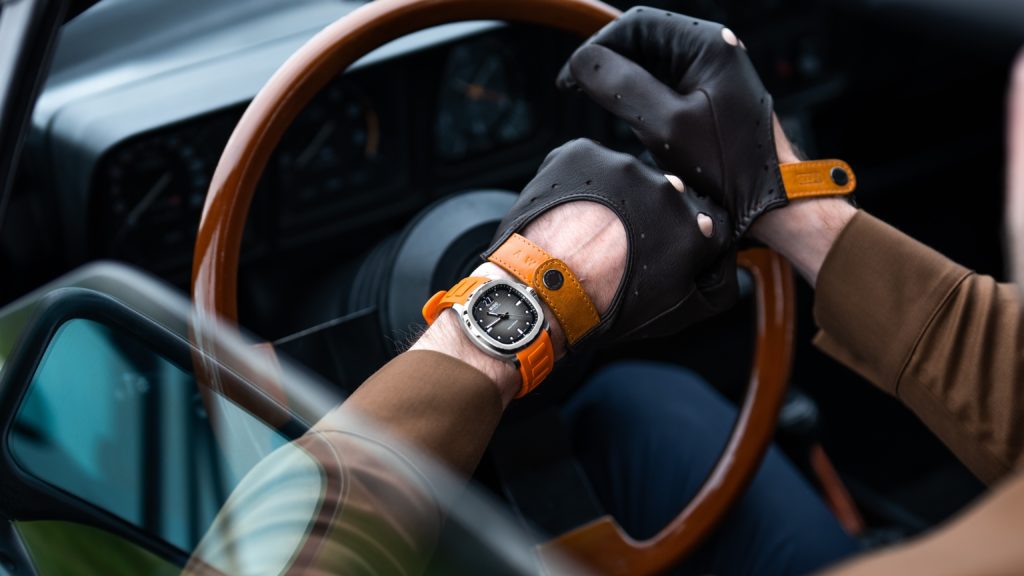
Reviving Retro: MIDO's Multifort TV Big Date
Remember the first TVs? Their screens, almost square with rounded corners, are a nostalgic nod to the past. MIDO first embraced this distinctive shape in the 1970s, 1980s, and again in 2000. Now, fifty years since its initial debut, the iconic TV-shaped case is back, seamlessly blending vintage charm with contemporary design.
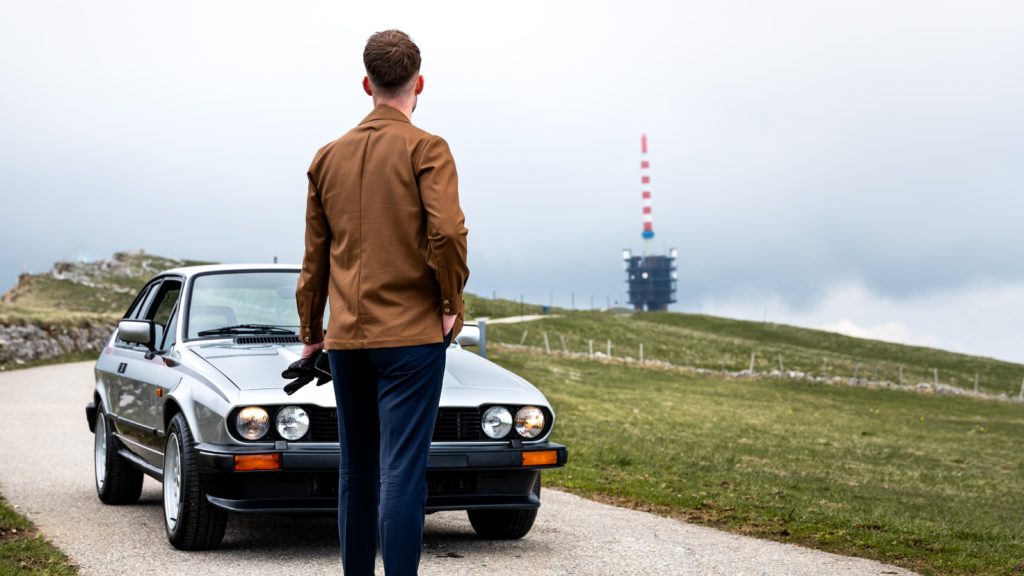
The Multifort TV Big Date showcases a flat, square satin-brushed bezel that frames a dial designed to catch the light beautifully. We think the horizontal brushed finish of the dial is striking, complemented by trapezoidal hour-markers at each quarter. The big date display on the two-level dial stands out, while a dot at 12 o'clock on the bezel harks back to the round hour-markers of past Multifort models.
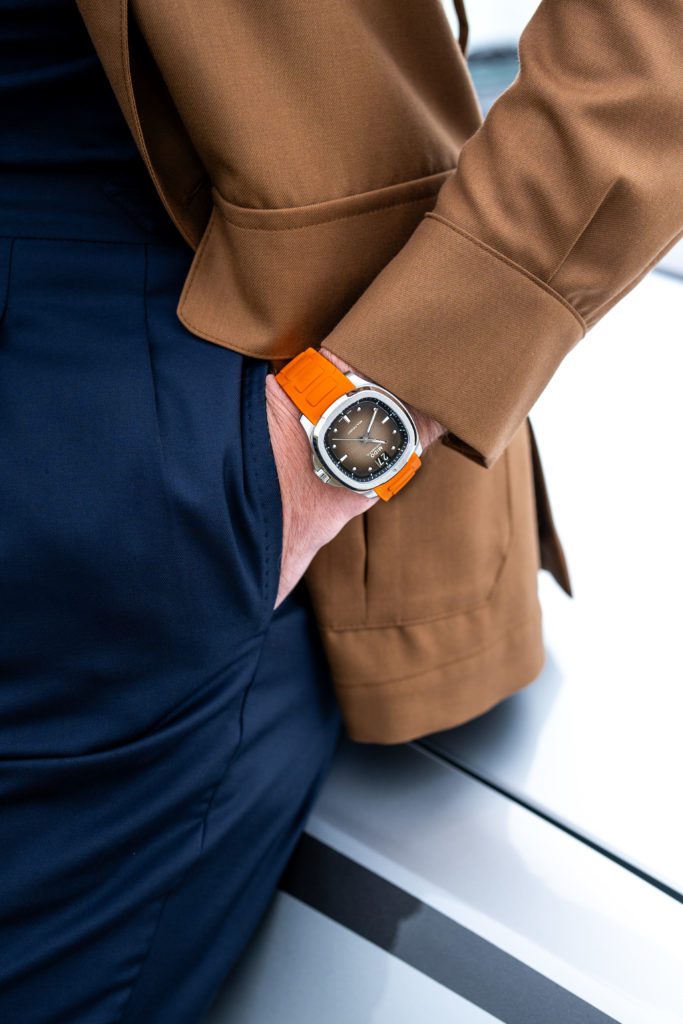

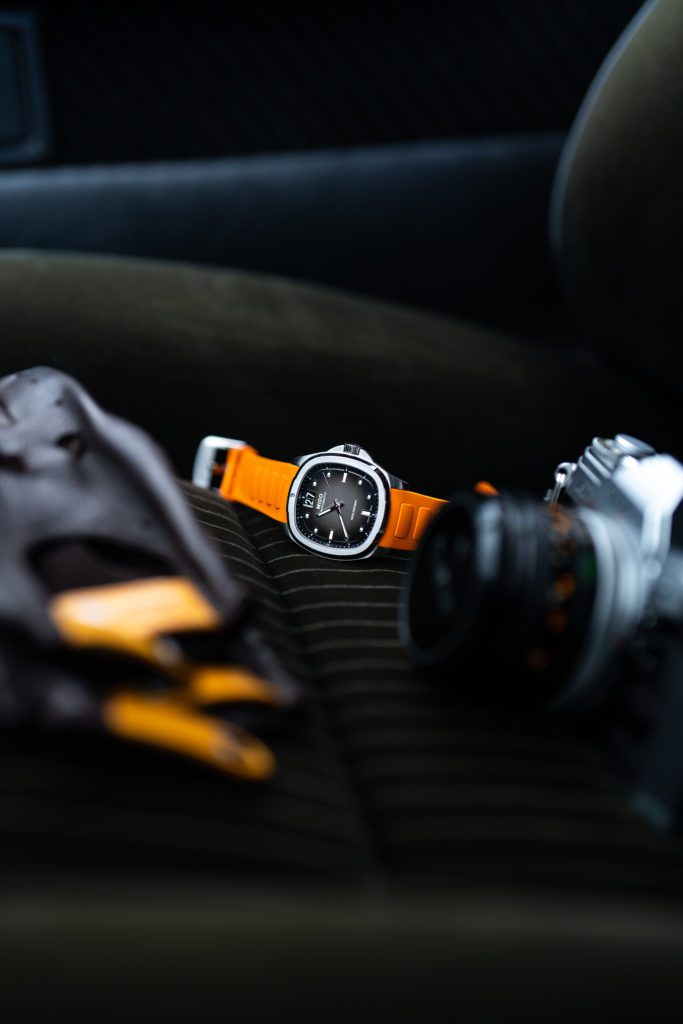
Cutting-Edge Mechanics
Beneath its stylish exterior, the Multifort TV Big Date is powered by the Calibre 80. The transparent case back reveals the intricately decorated gears, including an oscillating weight with Côtes de Genève and the Mido logo. This model boasts an impressive 80-hour power reserve. The inclusion of a Nivachron™ balance spring enhances its resistance to magnetic fields and shocks, ensuring remarkable precision. With water resistance up to 10 bar (100 meters/330 feet), this watch is built to endure.
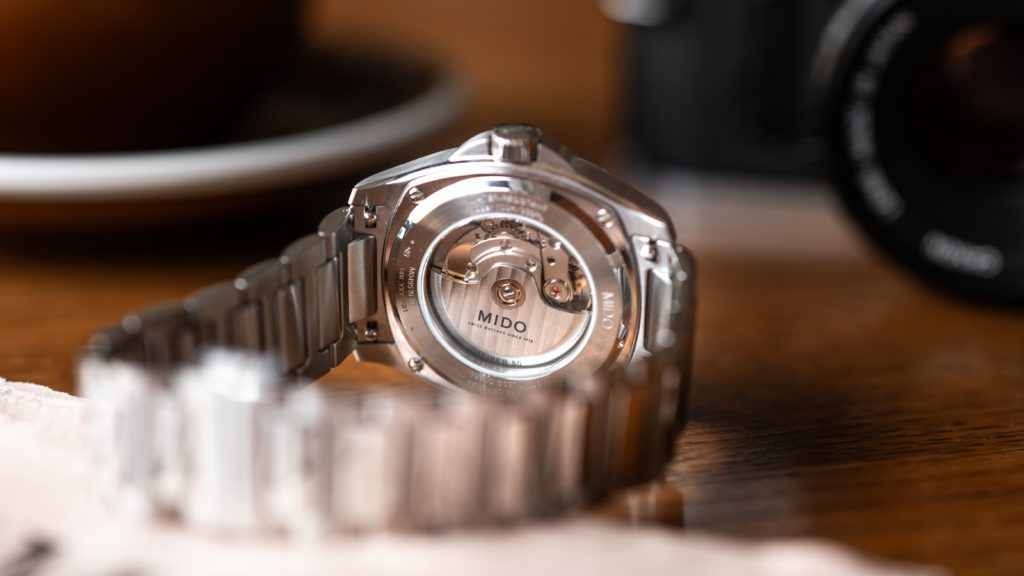
Modern Mastery
The Multifort TV Big Date epitomizes MIDO's expertise in watchmaking, offering a dynamic and original aesthetic. It's designed for the modern-day city dweller who values precision, robustness, and bold design. Whether you're dressing up for a special occasion or elevating your everyday look, this watch makes a powerful statement.

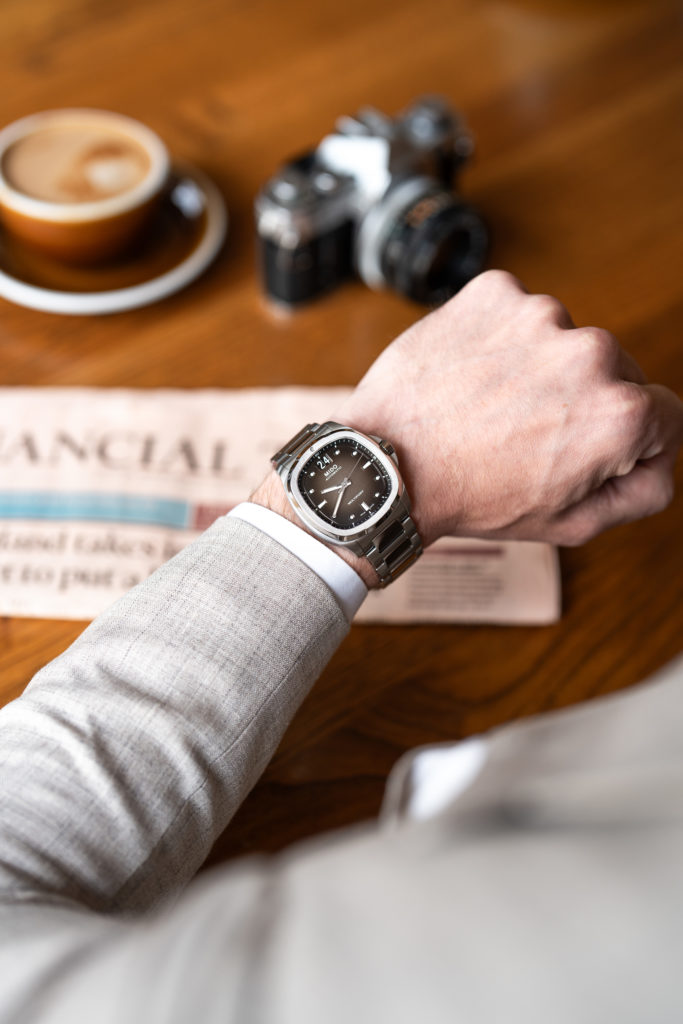

With the Multifort TV Big Date, MIDO has once again proven its ability to honor its rich heritage while infusing a breath of fresh air into its designs. This watch is more than just a timepiece; it's a symbol of timeless elegance and cutting-edge innovation, perfect for those who appreciate the finer details in life.
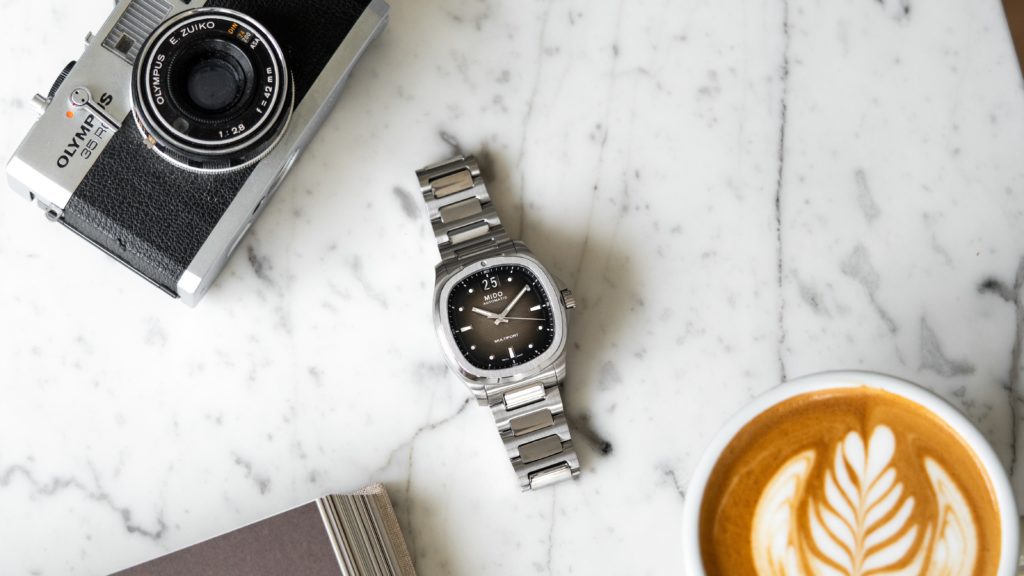
Stepping into the heart of a watch company's manufacture is akin to peering behind the curtain of a grand theater production. It's here that the true essence of craftsmanship, quality, and innovation is unveiled. Recently, we had the privilege of embarking on a tour of IWC's state-of-the-art Manufakturzentrum, and what we witnessed was nothing short of extraordinary.

A Legacy of Industrial Vision
In 1868, Florentine Ariosto Jones, a visionary from Boston, set out on a journey to Switzerland with a radical idea: fuse modern American production methods with Swiss watchmaking expertise. This visionary spirit laid the foundation for the birth of the International Watch Company (IWC) in Schaffhausen. Nestled beside the Rhine, Jones established a manufacture capable of churning out an impressive 10,000 watches annually.
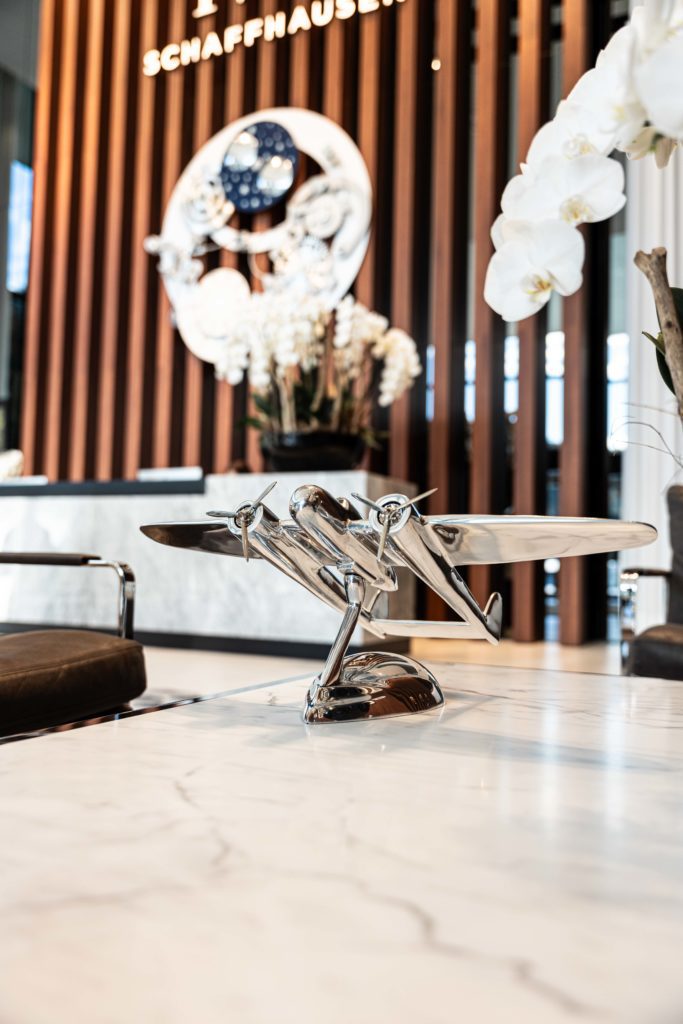
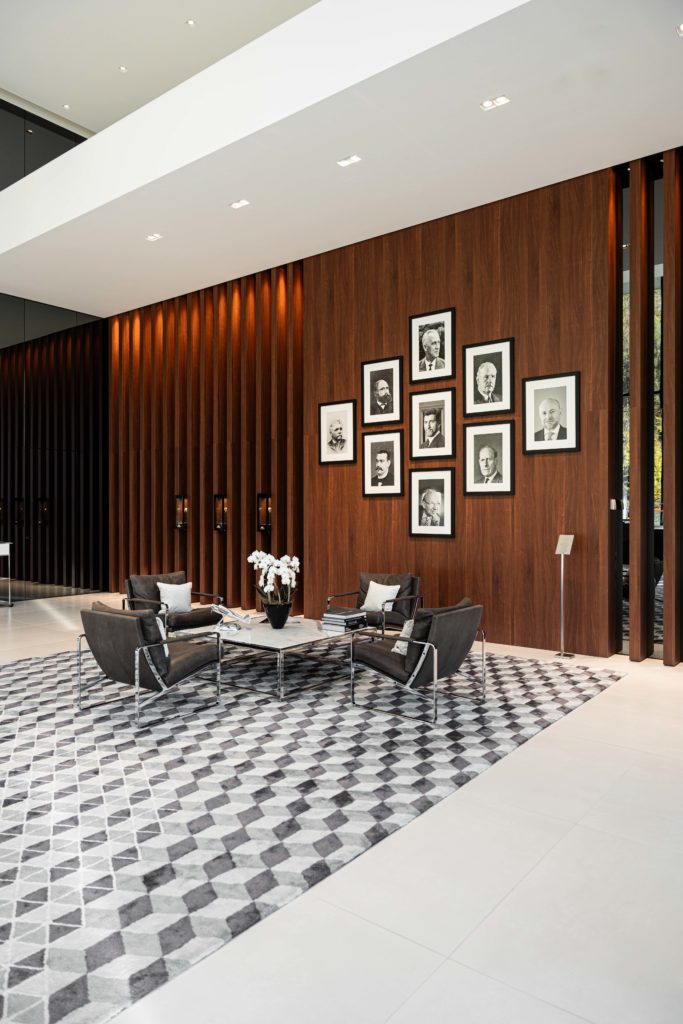
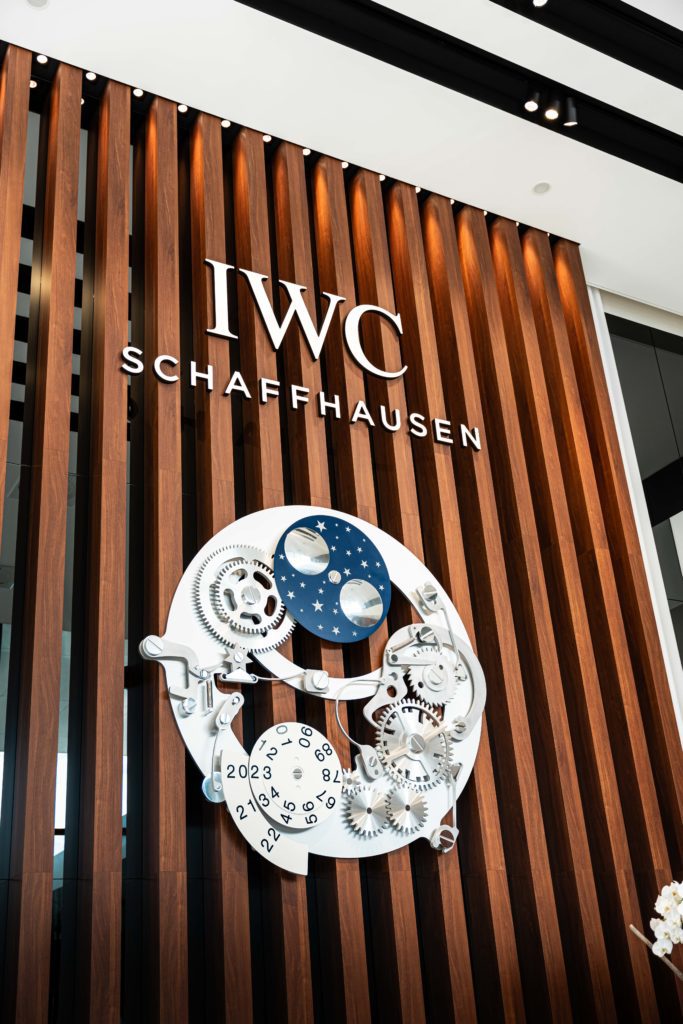
Fast forward to the present day, and IWC's industrial tradition initiated by Jones reaches new heights with the inauguration of the Manufakturzentrum, perfectly timed to coincide with the brand's 150th anniversary. Erected in a remarkable 21 months, this cutting-edge facility unites the production of movement components, complete movements, and cases under a single, technologically advanced roof. Casing up and final testing, however, remain reverently within the confines of the historic building. Notably, Christoph Grainger-Herr, IWC's CEO and an accomplished architect, lent his expertise to the design, ensuring a seamless blend of luxury and precision engineering.
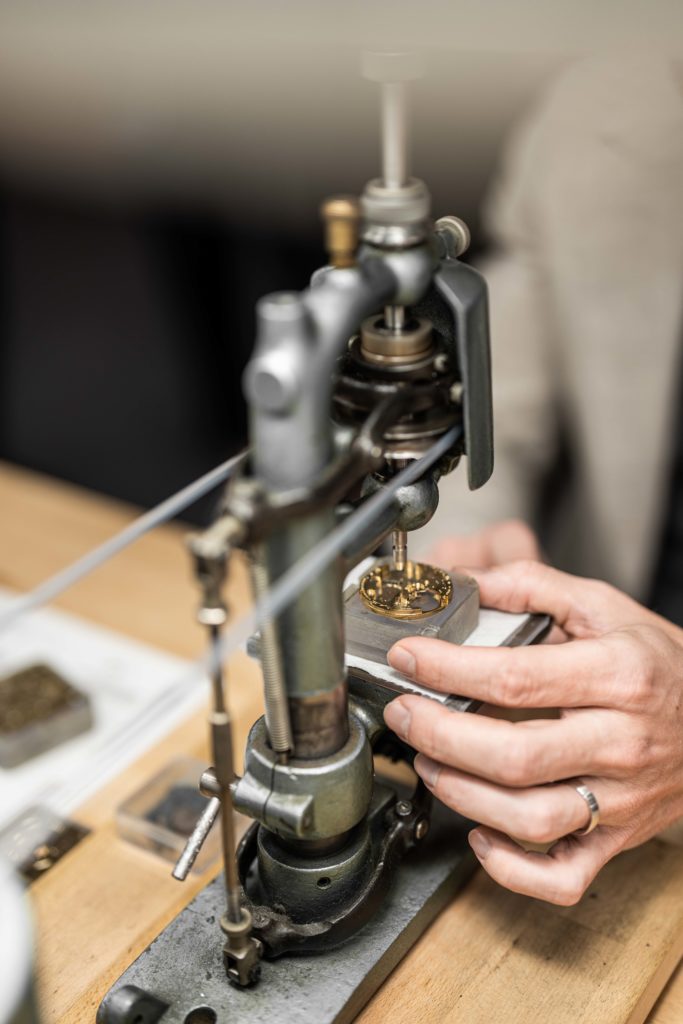
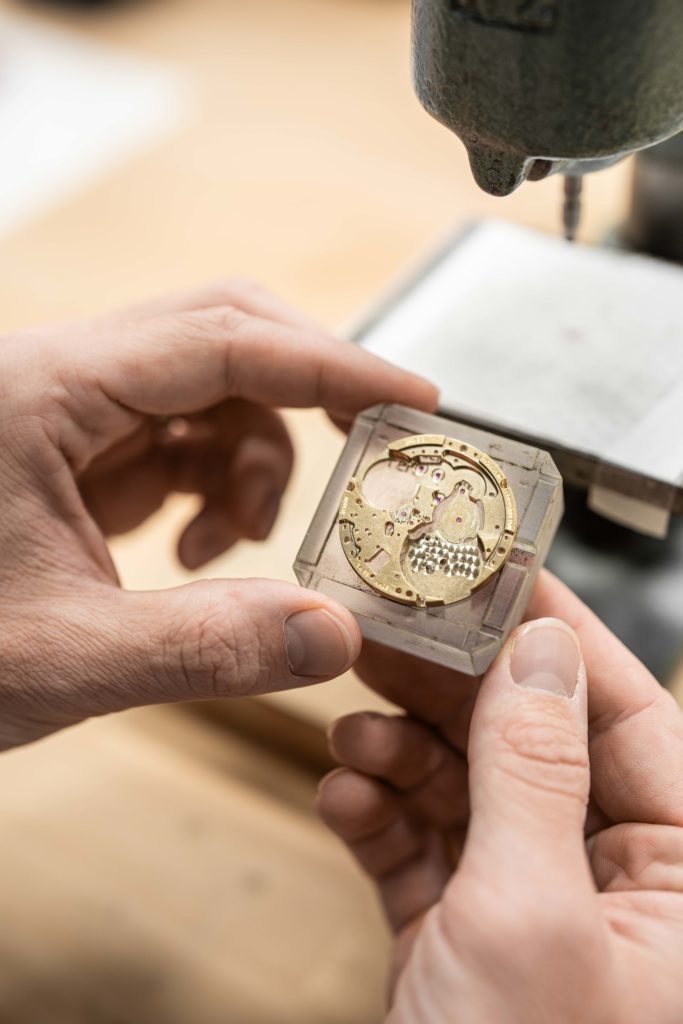
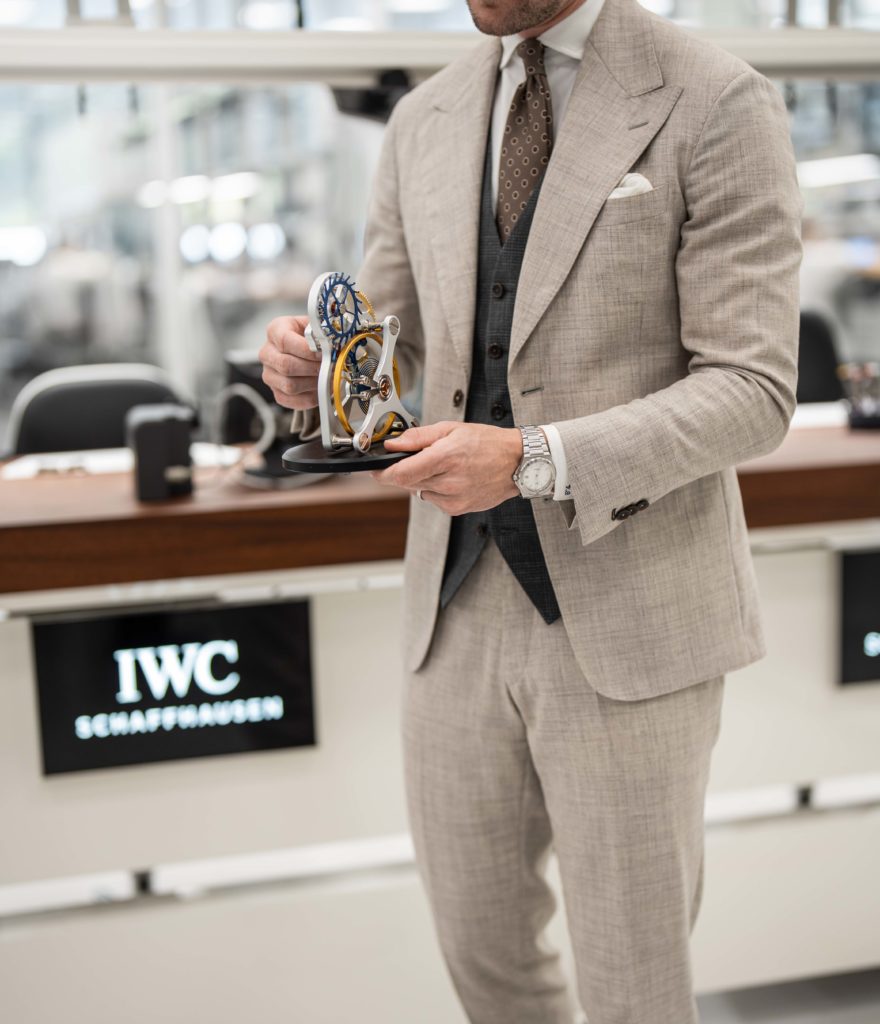
The IWC Manufakturzentrum: A Testament to Tradition
From the moment one approaches the 139-meter-long, 62-meter-wide structure, the Manufakturzentrum exudes an air of modernity and aesthetic allure. The monumental 2,200-square-meter glass façade captivates the eye, complemented by a soaring 9-meter-high entrance lobby, where a colossal perpetual calendar mechanism presides over the reception area. As a tribute to the luminaries who shaped IWC's legacy, portraits of key figures adorn one of the walls.
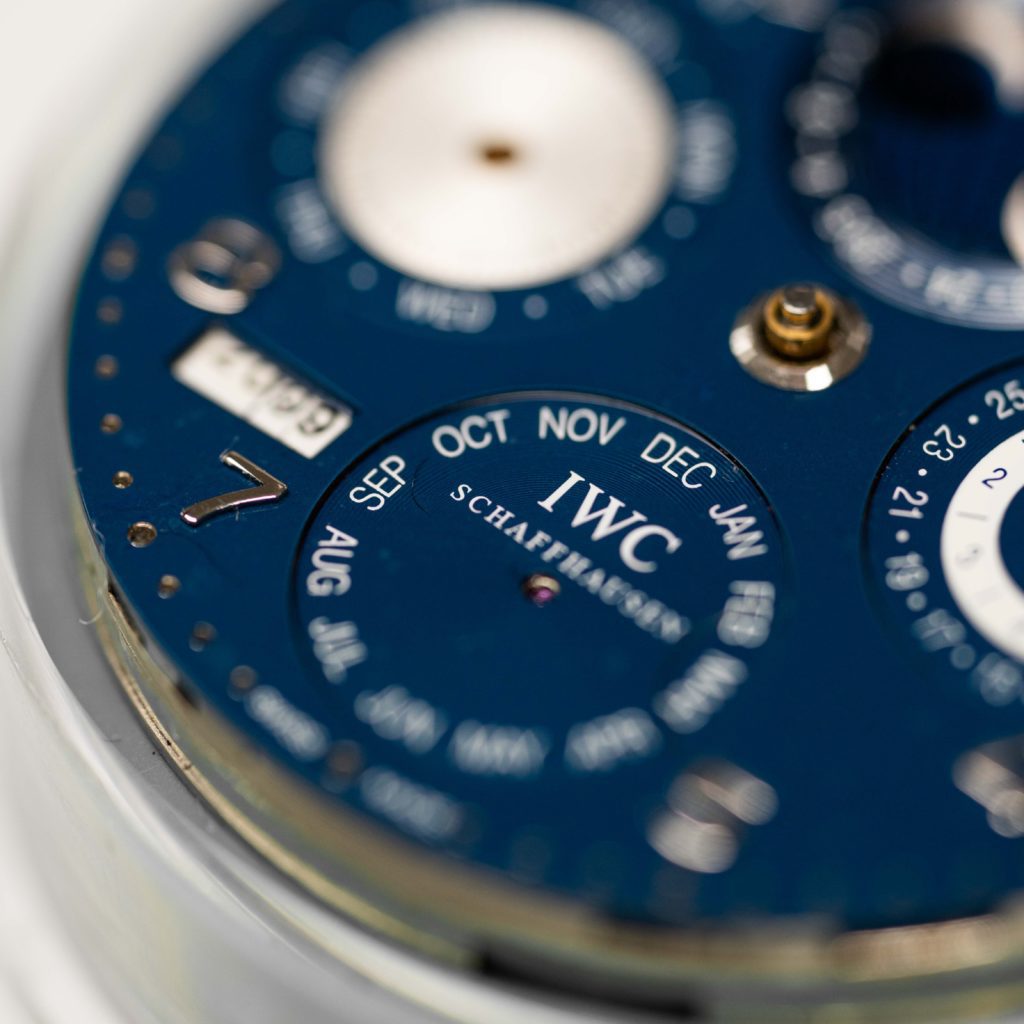
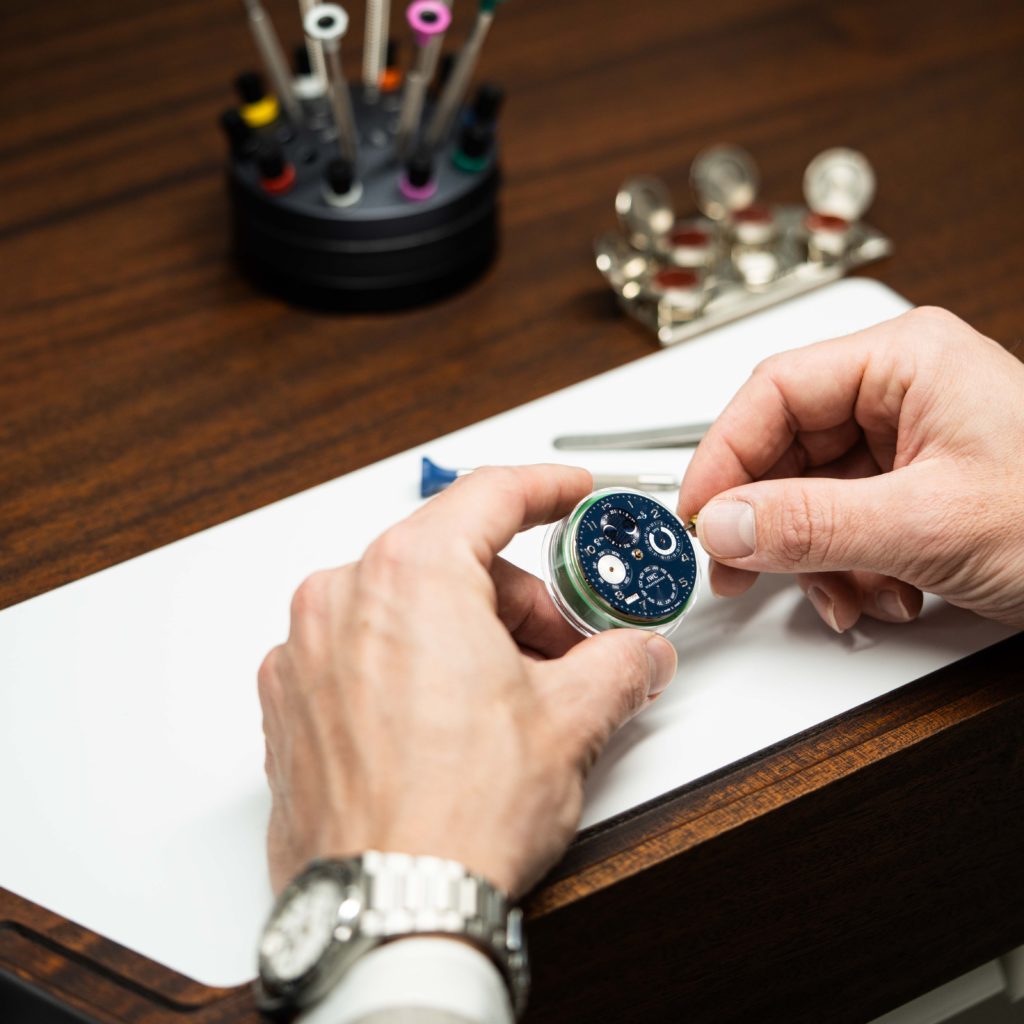
As visitors, we are immediately immersed in a world of fervent activity. Devoted craftsmen, each equipped with a magnifying glass and surrounded by cutting-edge CNC machines, pour over their workstations with meticulous care. The importance of natural light permeates the entire space, enhancing the production environment with optimal conditions. Everything is finely tuned for functionality, as the production flow unfolds seamlessly before your eyes.
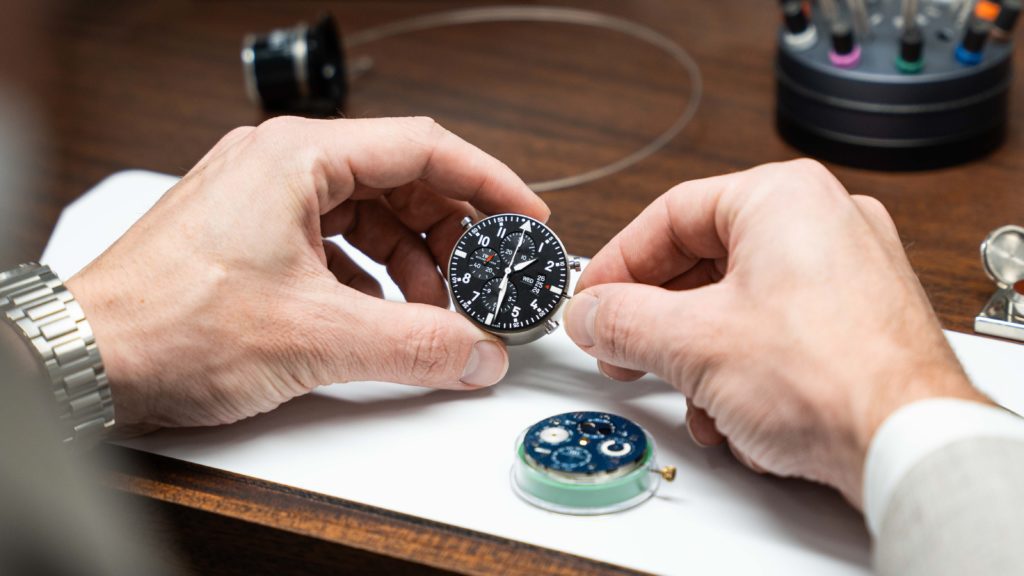
A pivotal area within the Manufakturzentrum is devoted to the birth of movements. From raw materials to meticulously crafted components, the process advances with surgical precision. Digitally controlled machines sculpt the parts, which are then adorned and electroplated. Precious jewels find their homes in plates and bridges, creating the intricate inner workings of each timepiece.
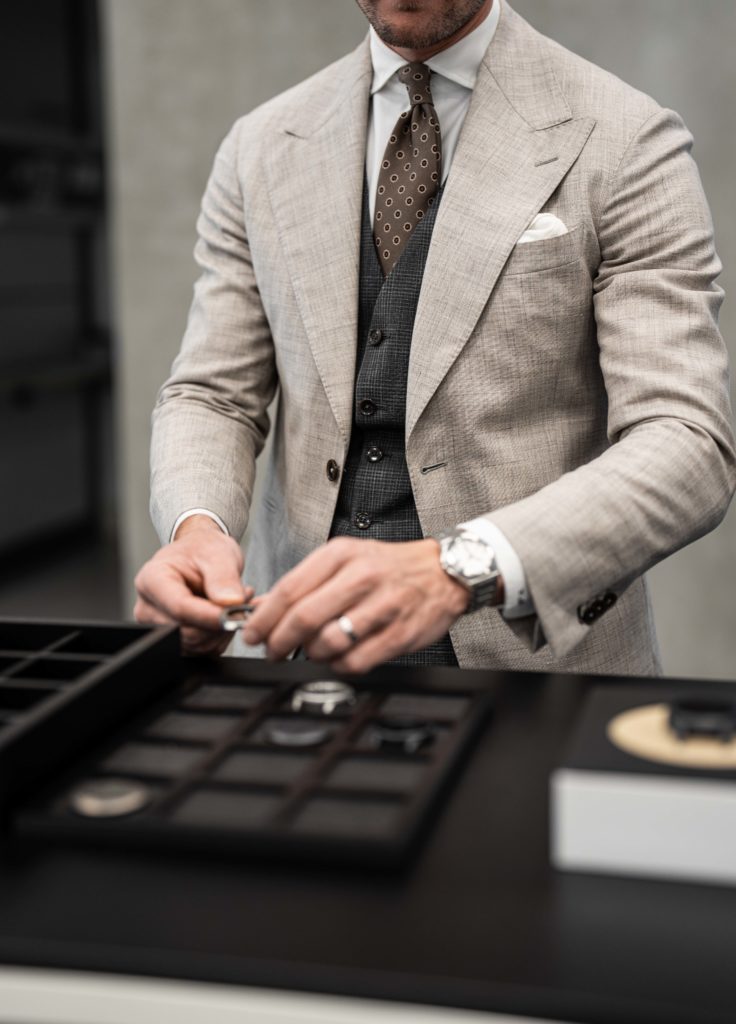
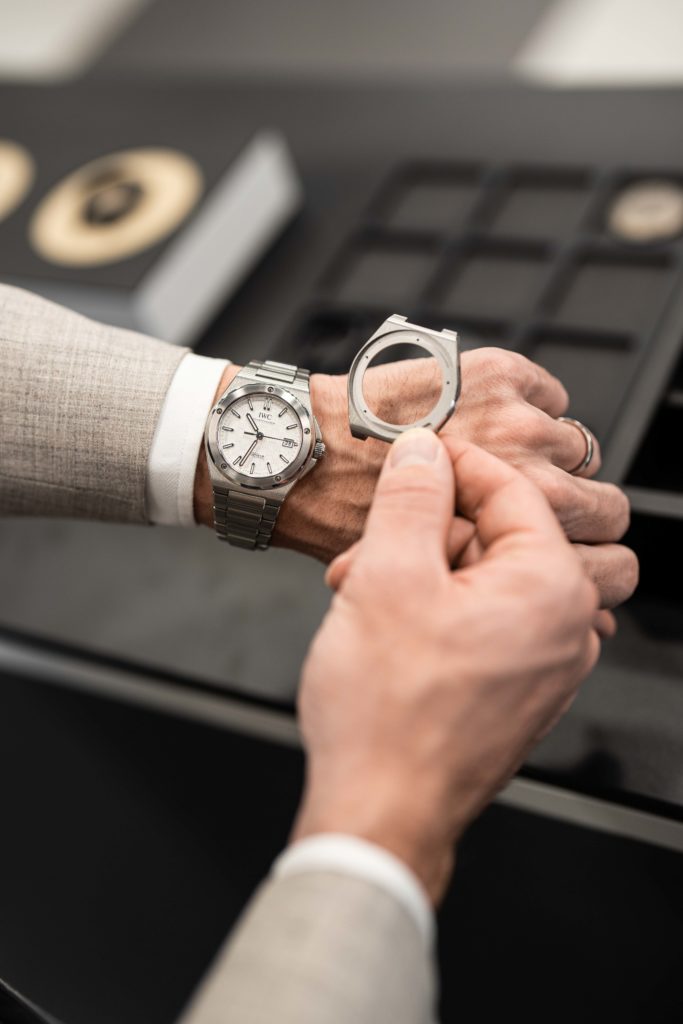
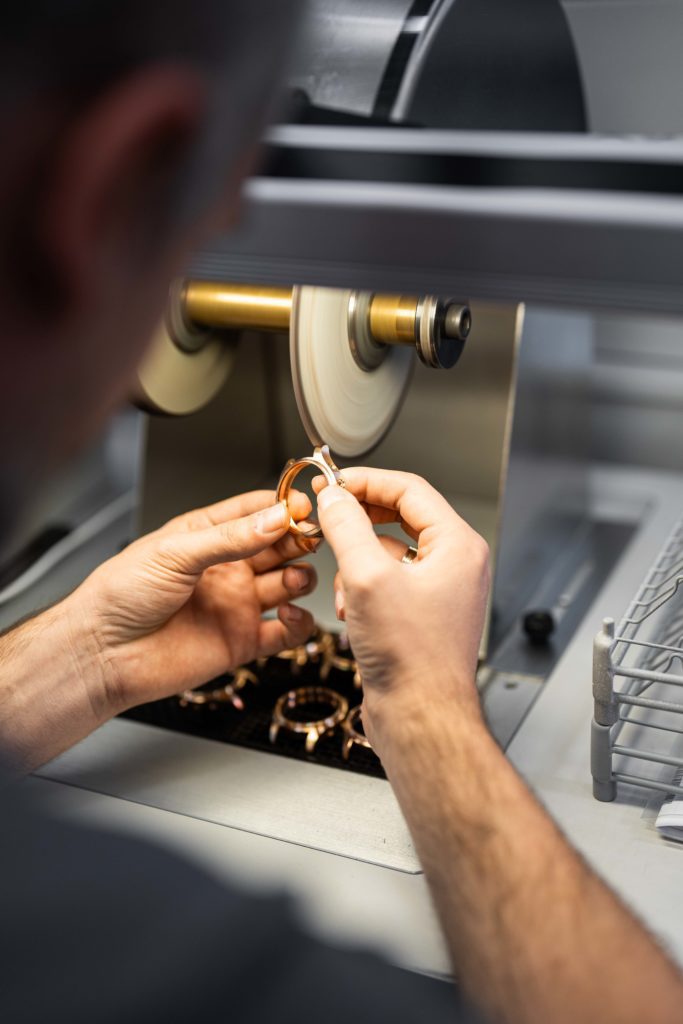
The Art of Case Making
Descending into the basement, a realm of case manufacturing reveals itself. IWC's mastery of materials is on full display, with stainless steel, titanium, platinum, gold, and bronze cases all being produced in-house. Also showcased is Ceratanium, an innovative material that marries the strength of titanium with the hardness of ceramic. The expertise and attention devoted to hand-finishing the cases is nothing short of remarkable. Each surface and angle undergoes patient refinement with a polishing wheel, culminating in a level of craftsmanship rarely seen in case production departments.
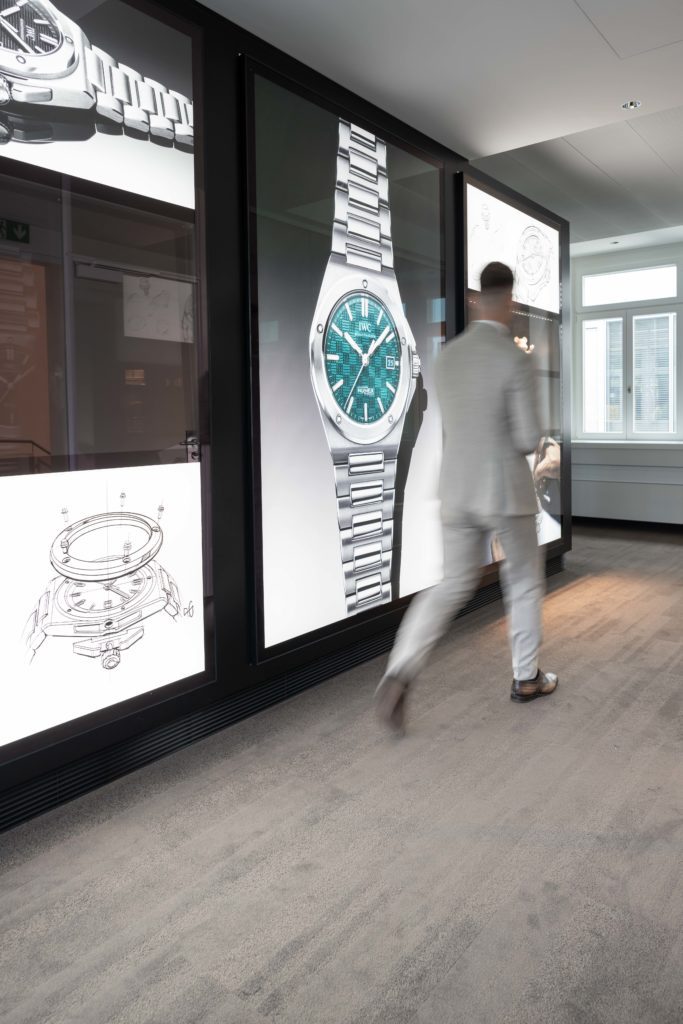

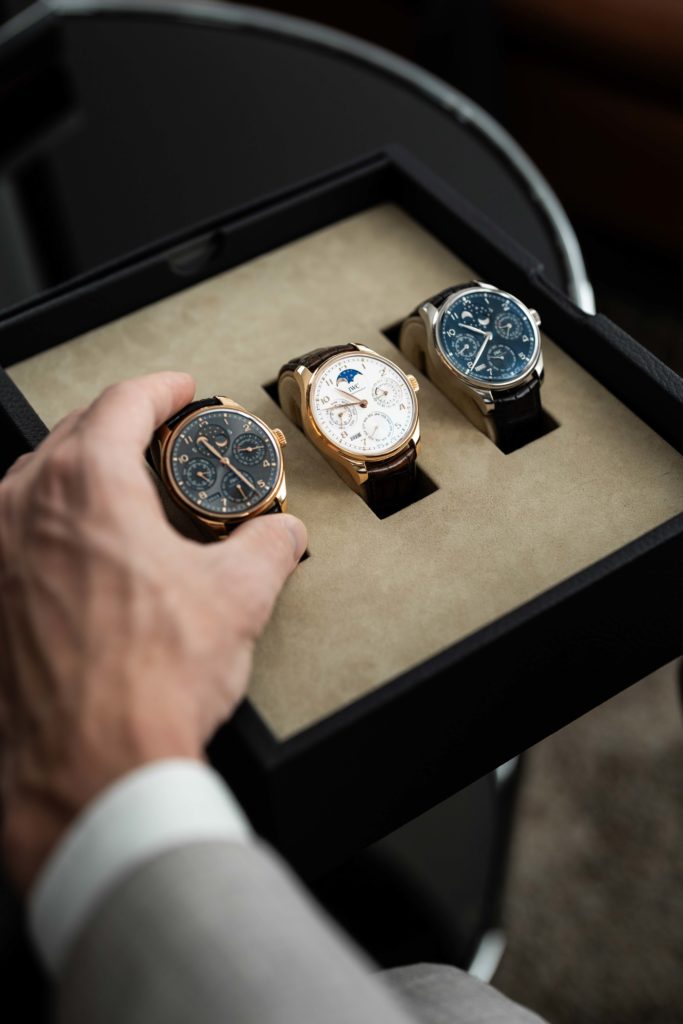
A Testament to Quality and Commitment
The new IWC Manufakturzentrum is a testament to the brand's unwavering commitment to quality and innovation. It represents a significant step forward in IWC's evolution, providing a purpose-built infrastructure to accommodate the company's expansion. With room for 400 craftsmen, the Manufakturzentrum stands as a beacon of pride for every employee, underscoring that an IWC timepiece is more than a mere instrument for telling time—it's a masterpiece of precision and legacy.

As watch enthusiasts, we're always on the lookout for the next game-changing creation that will propel the industry forward. In a world of ever-expanding horological wonders, it's often the pursuit of innovation and fresh ideas that make a timepiece stand out the most. The Swiss brand Horage definitely ticks a lot of boxes in that regard: let’s have a closer look at the newly released Lensman 2!
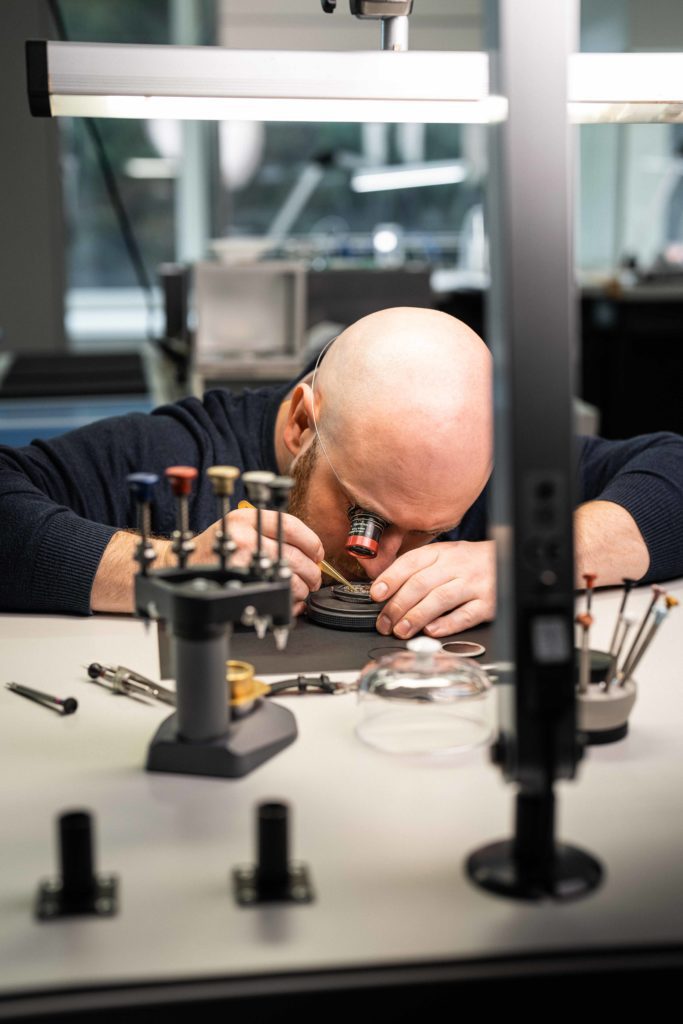
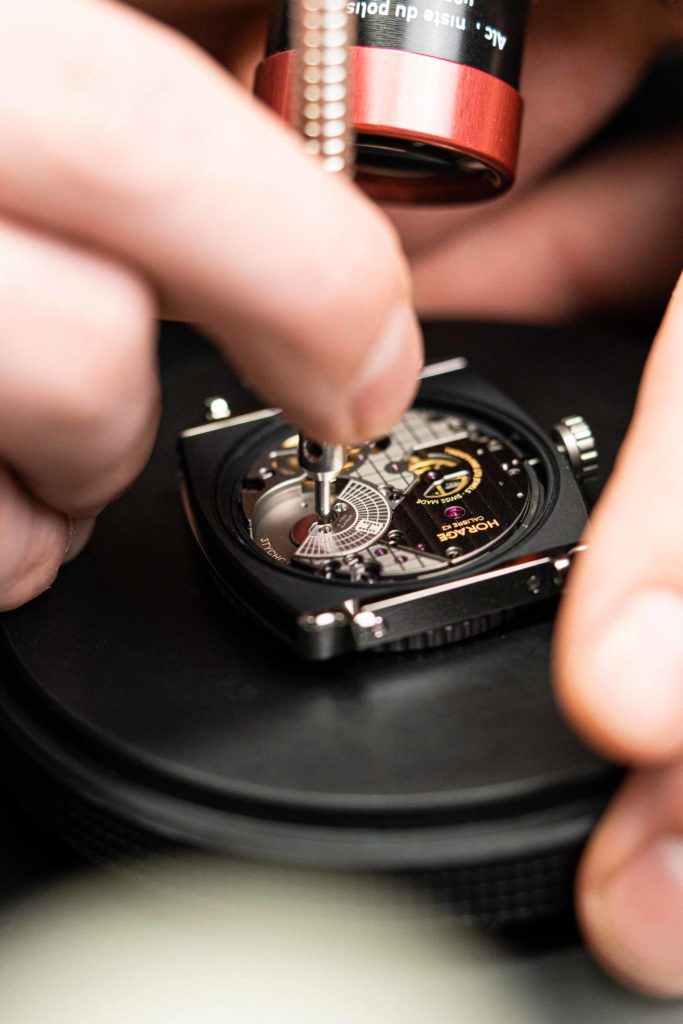

A Watch for Photographers
Photography is one of our biggest passions here at Artworth - and the idea of combining watchmaking with photography is without a doubt very intriguing to us. The Lensman 2 by Biel/Bienne based Horage is equipped with a very unique Bezel that functions as an exposure calculator, combining the two worlds in a way that has never been done before. An impressive ISO and aperture range is offered on the bi-directional bezel for quick referencing between your shots. This allows the watch to show you the optimal values for your camera when the markings on the bezel are aligned with your current lighting conditions. Fascinating, no?
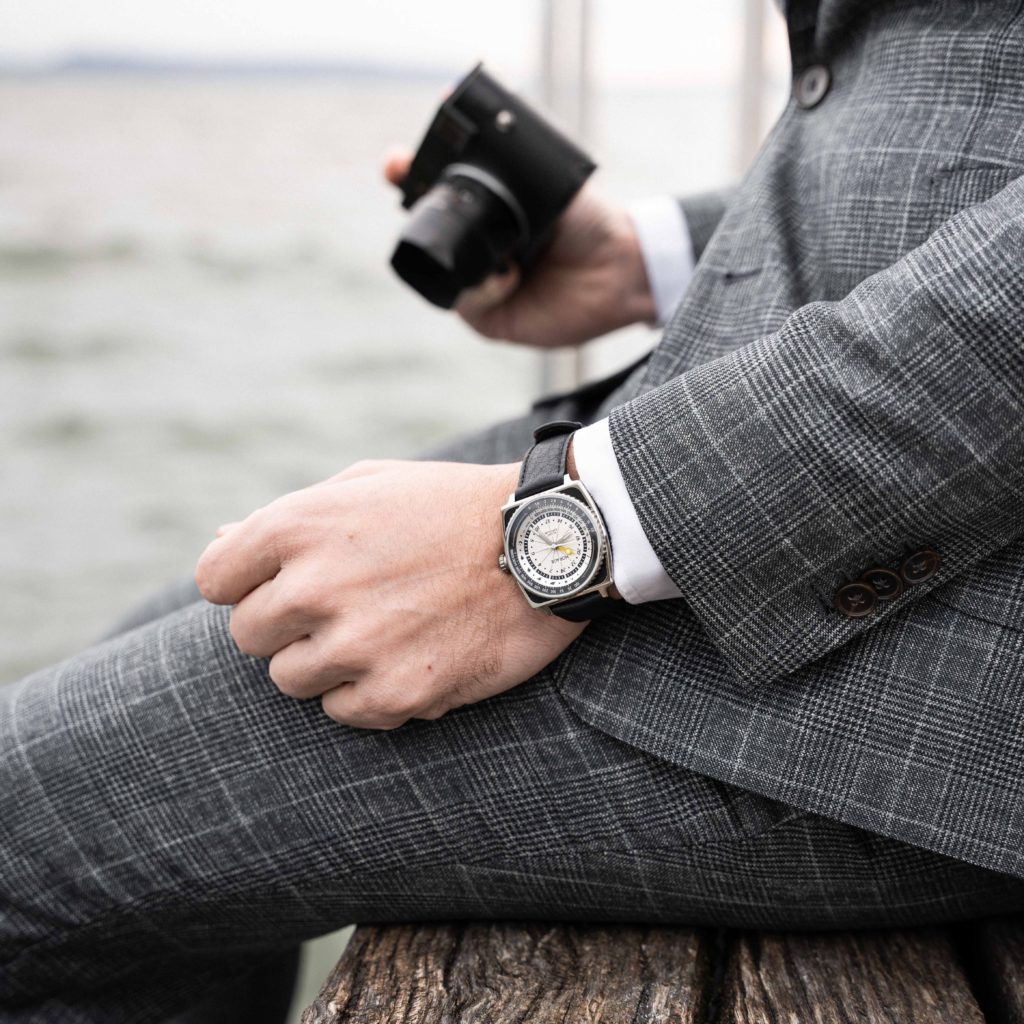

This highly innovative function reinvents the definition of a modern daily tool watch in our eyes. The watch satisfies both form and function and gives off old-school vintage vibes, while maintaining a sleek and clean overall look and feel. In addition to the unique Bezel, the watch also features a GMT 24 hour jump set. This is ideal for photographers exploring the globe, keeping track of multiple time zones.
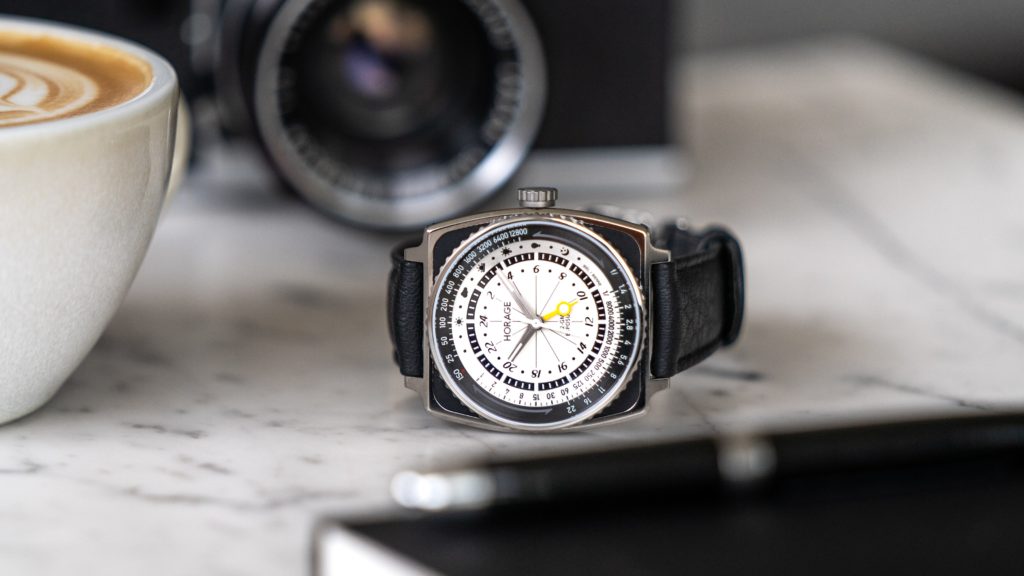
A Look inside the Horage Lensman 2
Of course, as you would expect from a Horage timepiece, the heart of the watch doesn’t disappoint either: The in-house K2 micro-rotor is accompanied by a 24-hour GMT module that packs a strong 72 hour power reserve. This highly sophisticated movement is also properly protected: both the crown as well as the case itself are made from polished grade 5 titanium to make sure the COSC Chronometer Certified timepiece won't be damaged.
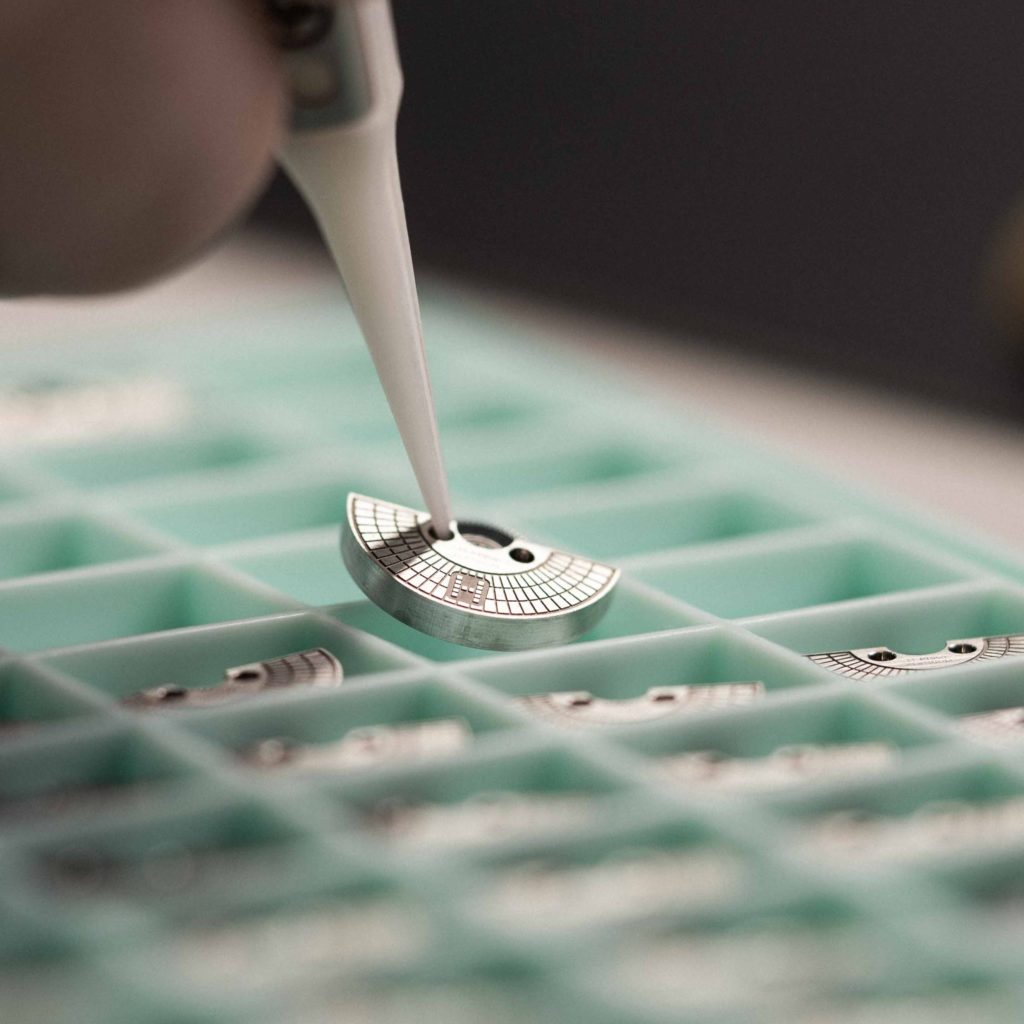
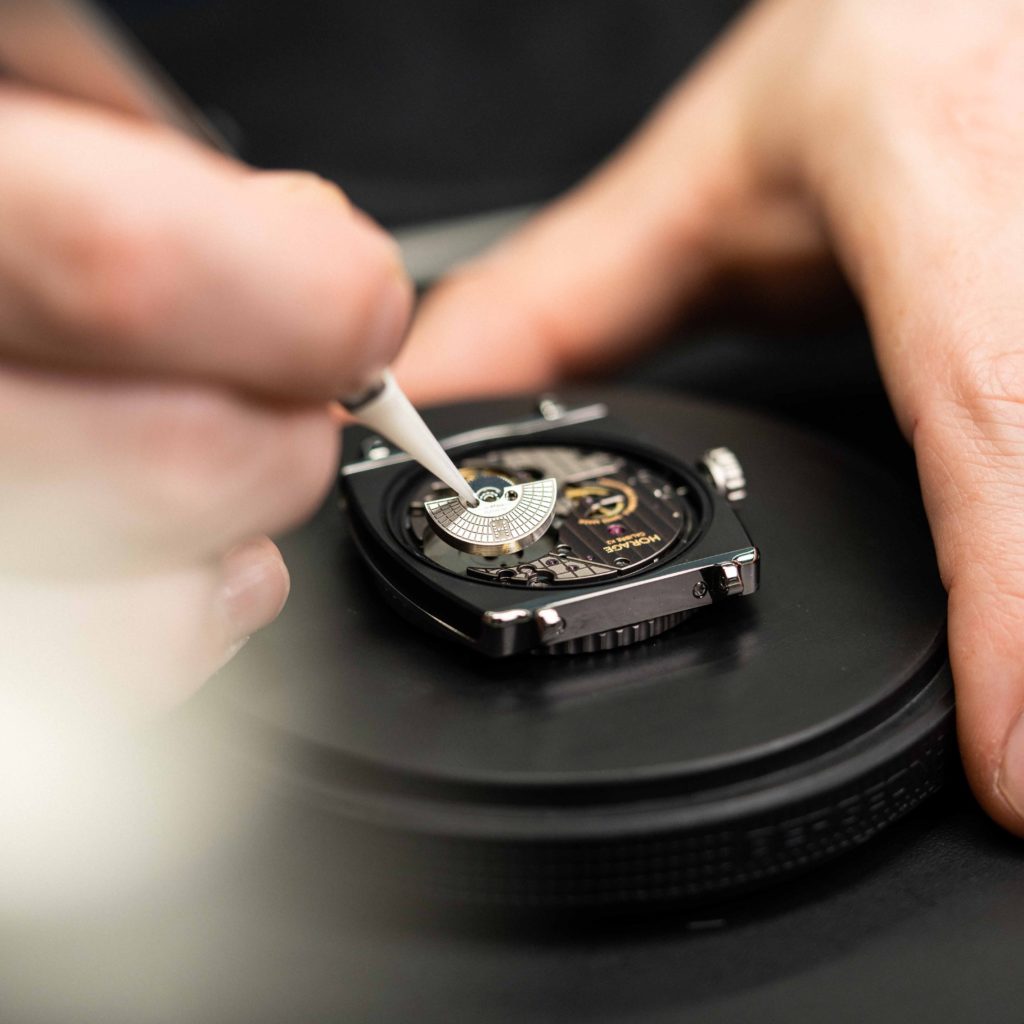
At Artworth, we love the Horage Lensman 2 for multiple reasons. It's a timepiece that visually and functionally reinvents the definition of what a true modern-day tool watch can and should be. We’re convinced that anyone with a strong passion for either photography or watchmaking will fall in love with the Lensman 2, just as we did!
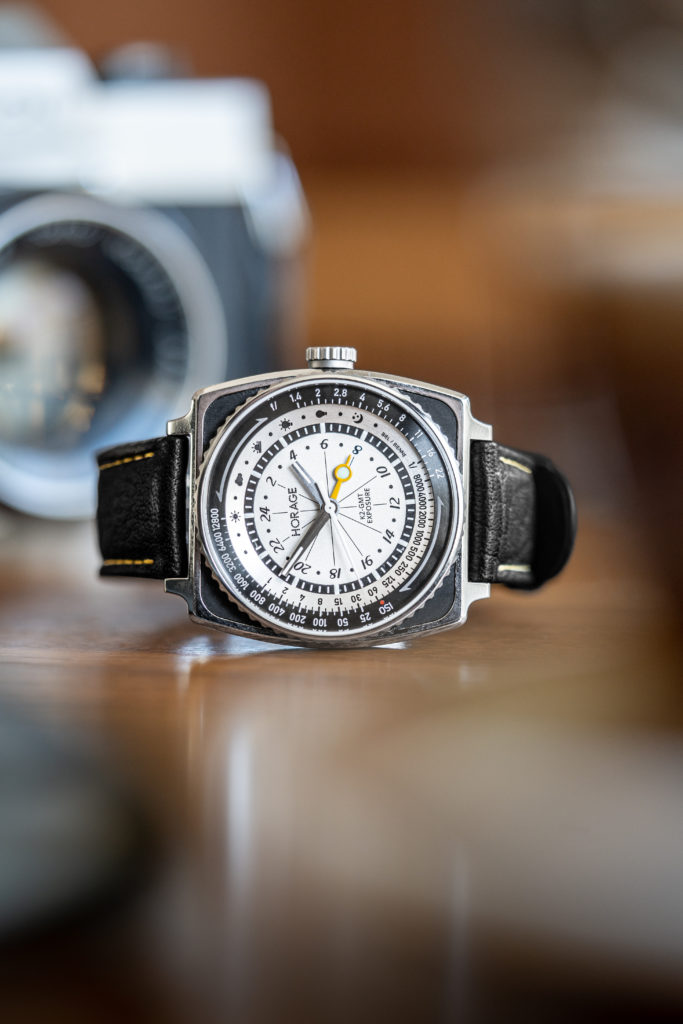

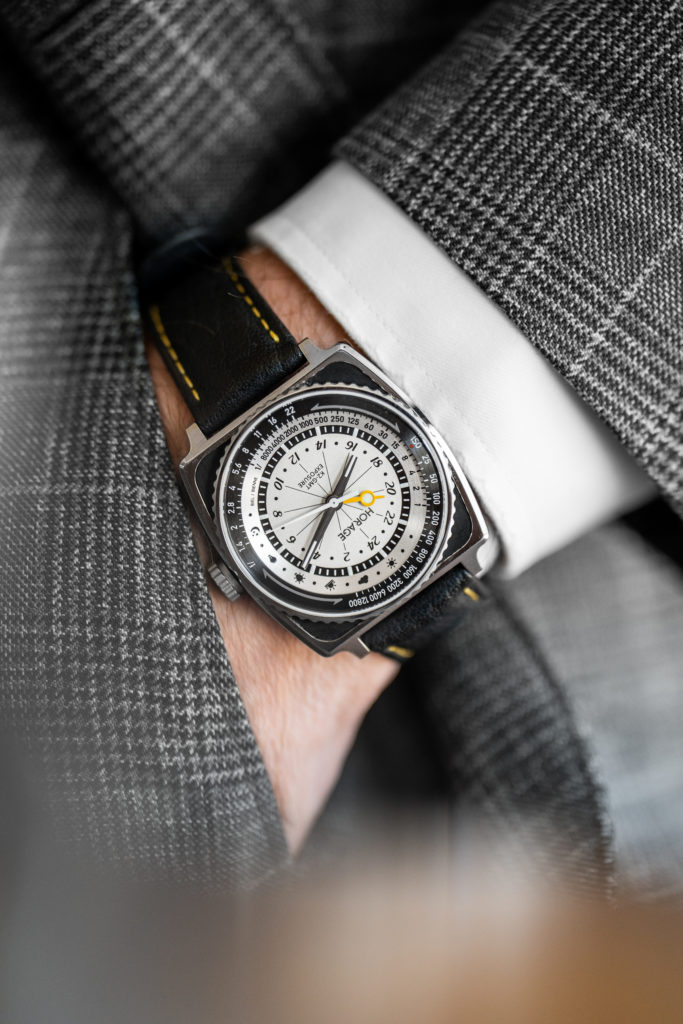
To learn more about Horage, read this article about our visit at their manufacture in Biel/Bienne.
Join us on an exciting tour through the mountains of Neuchâtel in the Jura & Three-Lakes region in northwestern Switzerland. Here, we can trace back the origins of Swiss watchmaking for centuries. Let's start in La Chaux-de-Fonds!
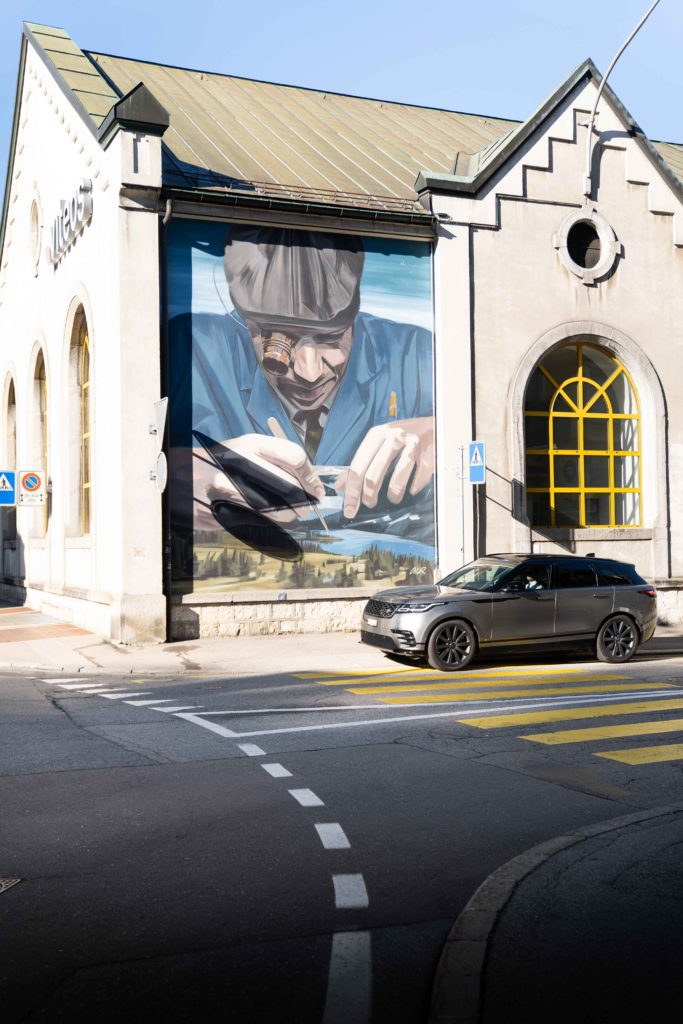
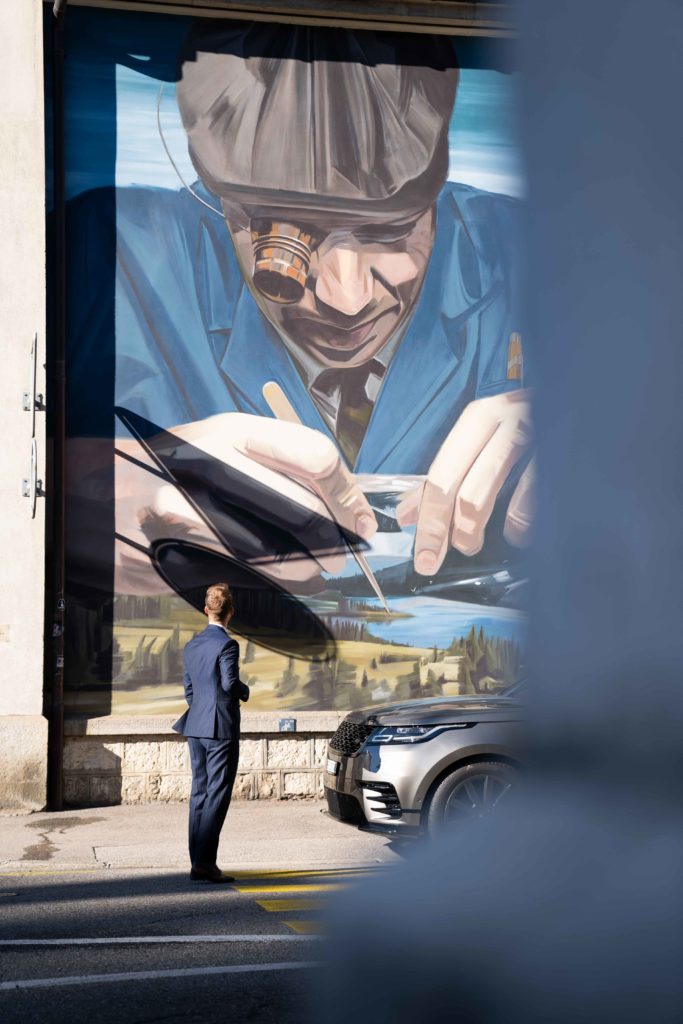
Visiting the Cradle of Watchmaking
Alongside Geneva and Lausanne, La Chaux-de-Fonds is one of the largest cities located in the Romandie, the French-speaking part of Switzerland. For many, this might be somewhat surprising. However, the town has a rich history, dating back to 1656. From there on, its growth and prosperity are mainly correlated with the success of Switzerland's watchmaking industry. Situated within an area known as the Watch Valley, La Chaux-de-Fonds has become the epicenter of fine watchmaking.

Consequently, the city is the birthplace of some of the most famous Swiss watch brands. Among them TAG Heuer, Girard-Perregaux, Corum, Eberhard & Co. and Omega. In 1908, the first location of the watch brand Rolex was also registered in La Chaux-de-Fonds. Even today, manufacturers of world-famous brands are still based in La Chaux-de-Fonds. Here, brands like Cartier, TAG Heuer, Jaquet Droz, Greubel Forsey, Patek Philippe, Schwarz Etienne, Ulysse Nardin or Breitling Chronometrie develop and manufacture complicated Swiss timepieces.

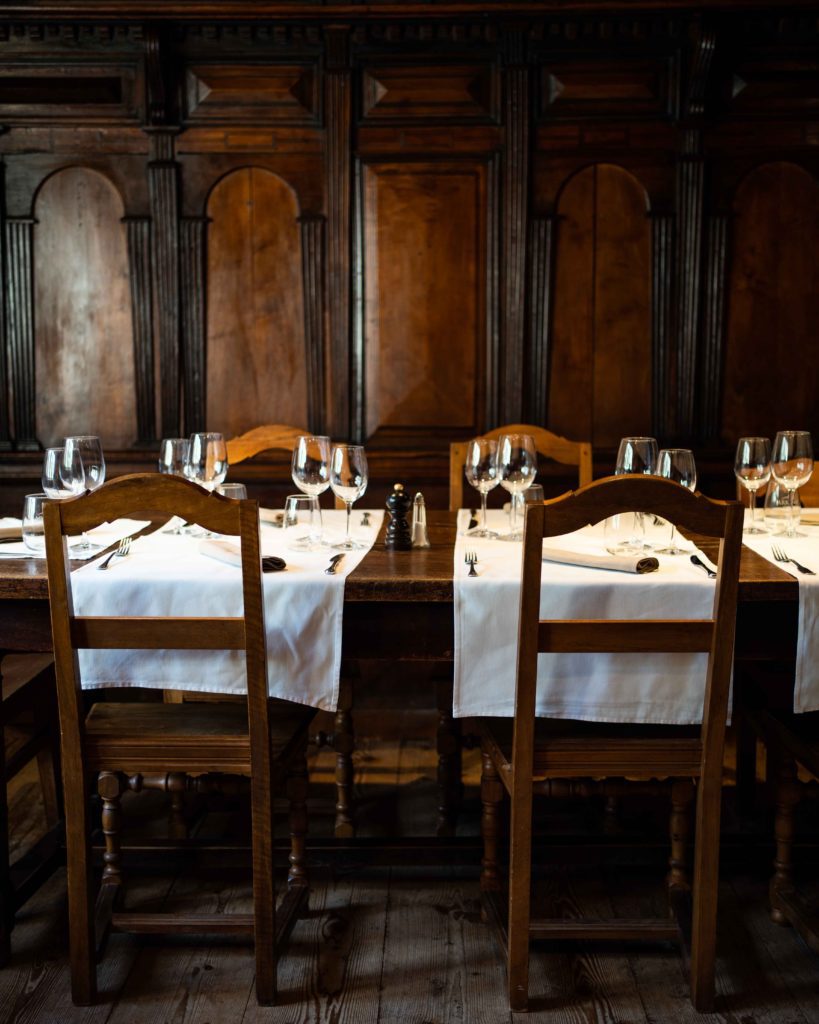
After a delicious lunch at the Ferme des Brandta converted Neuchâtel farmhouse, we meet Rudolf Schläpfer. He lived in La Chaux-de-Fonds for more than 40 years and has studied the history of the town and watchmaking in great depth. We are happy to join him on a tour to visit the former Spillmann watchmaking atelier. This former residence, renovated in the early 20th century, was used as a factory and residence. We're impressed by The Salon Bleu adjoining the workshop. It is decorated with magnificent floral motifs, a superb example of the local "Sapin" (Pine Tree) Art Nouveau style.

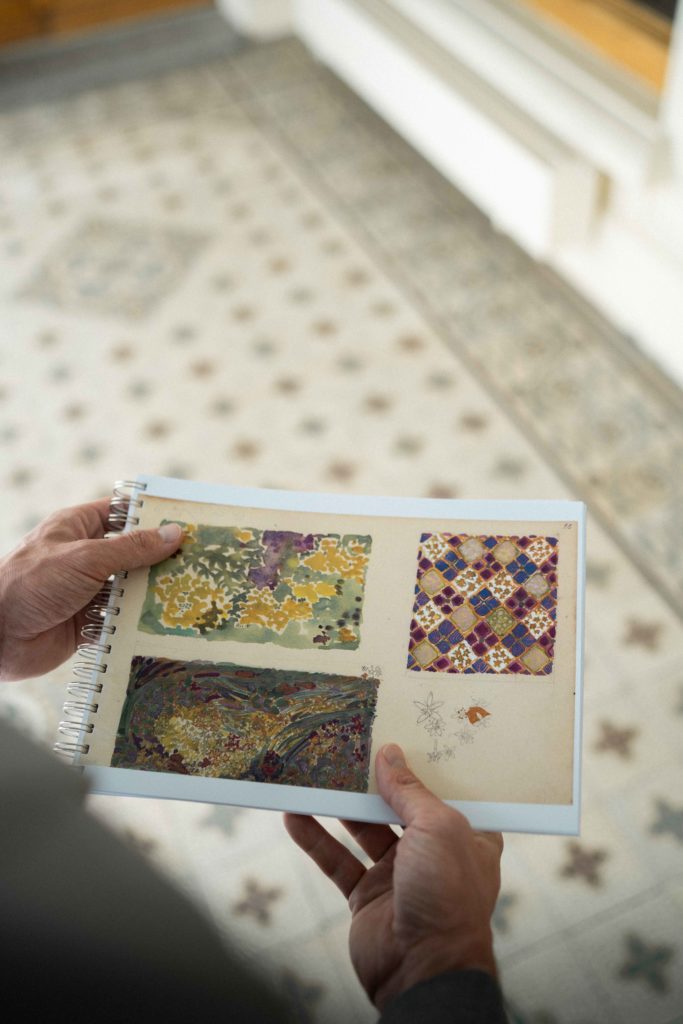
Rudolf Schläpfer tells us that even Karl Marx mentions La Chaux-de-Fonds in his books, referring to it as one big manufactory of watches. Around 1900, about 50% of the world's watches were produced in the city of La Chaux-de-Fonds. Here, the concept of network production was pioneered, which proved much more efficient.
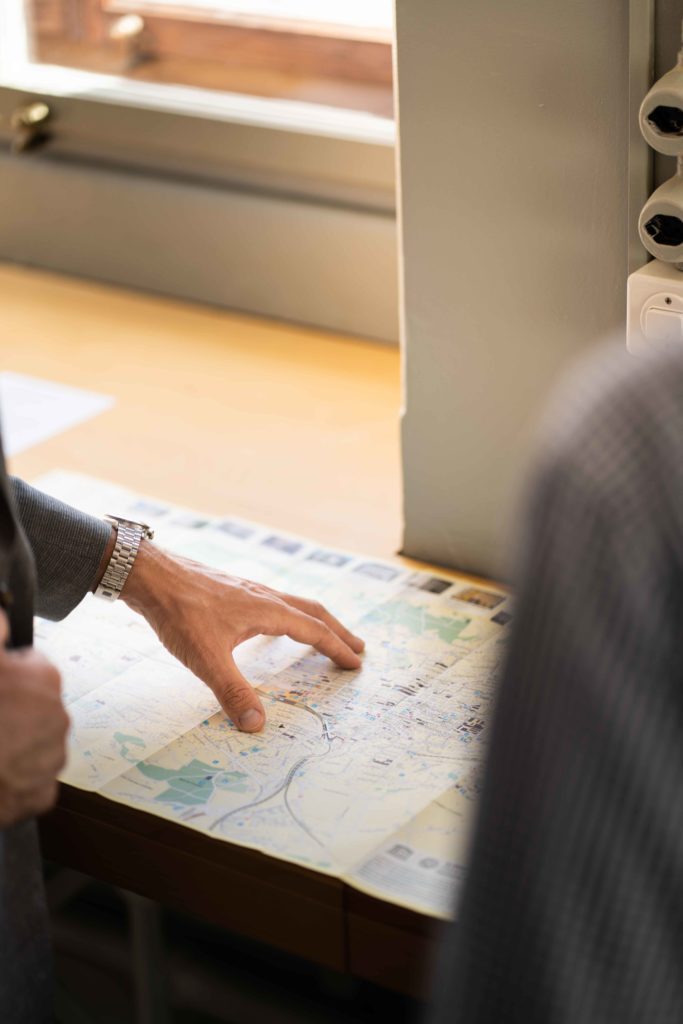
Unwinding at the Grand Hôtel Les Endroits
After an eventful day we're happy to check in at the Grand Hotel Les Endroits. Here, on 1,111 meters above sea level, we enjoy a cigar and a fine Single Malt Scotch Whisky. The family-owned and run hotel turns out to be the perfect fit for us. After a relaxing time in the beautifully renovated spa of the hotel, we enjoy an excellent dinner with a wide variety of local and seasonal dishes.
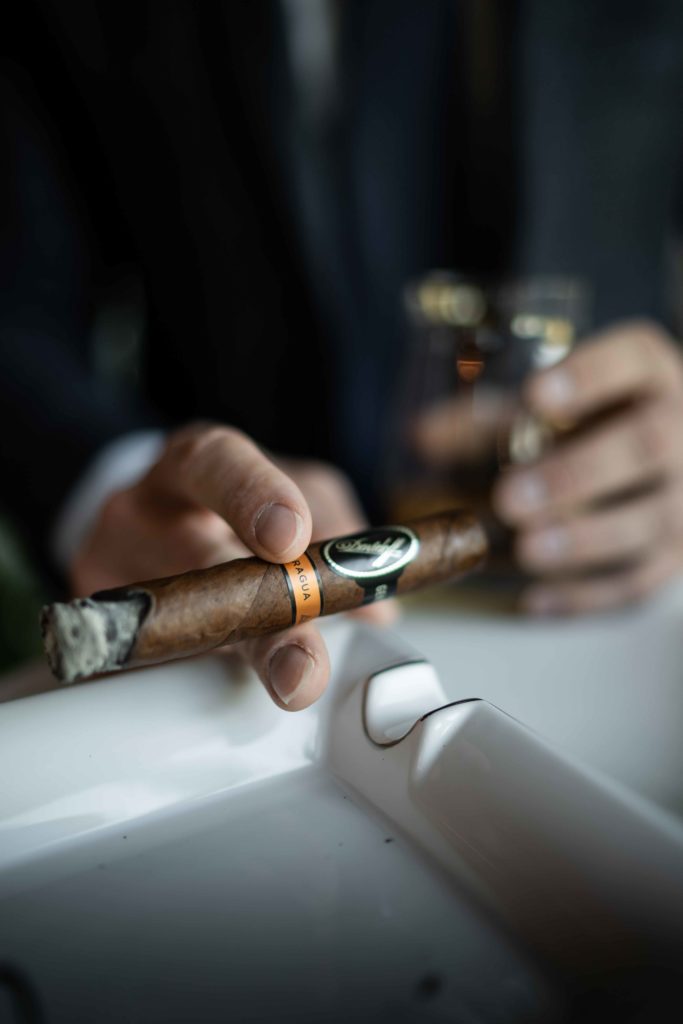
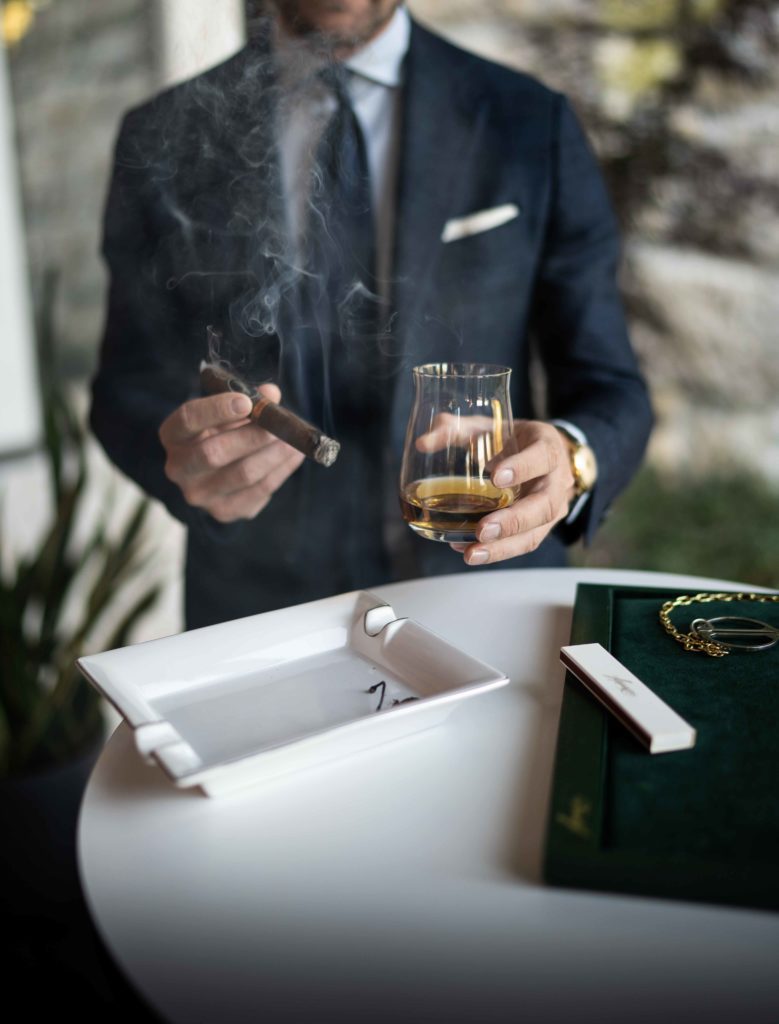
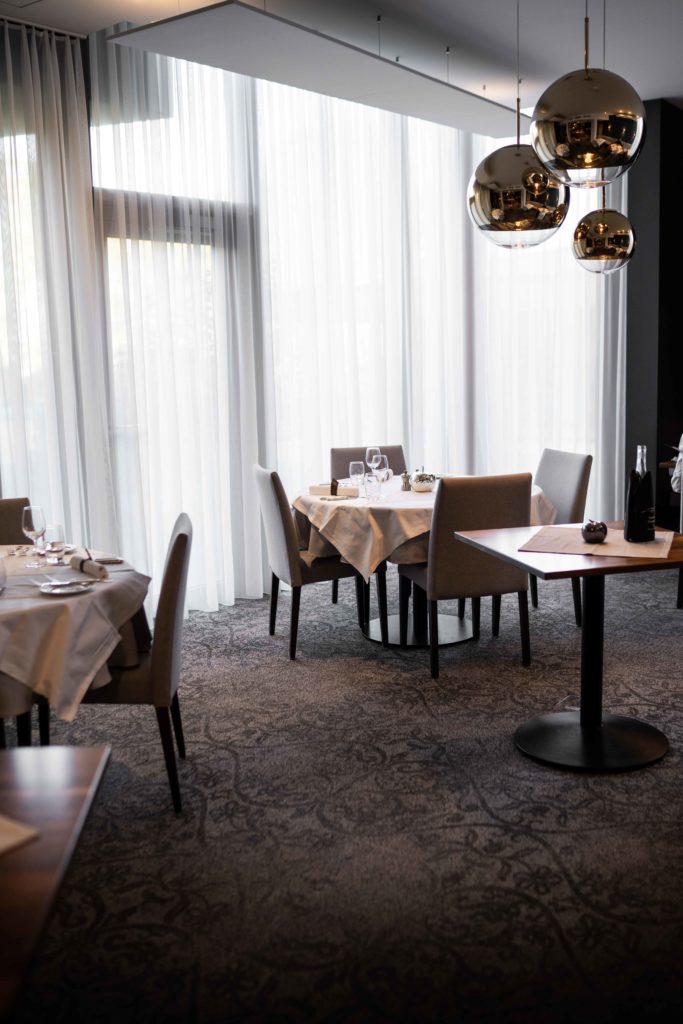
We then look forward to a night in our wonderfully exclusive spa suite. On a lavish 82m² space, luxury awaits us. There is a private spa inside the magnificent suite featuring a whirlpool, sauna and steambath. The elegant bedroom has access to a nice balcony or terrace, while the large living room has a home theater, working space, dining table and even a kitchenette.
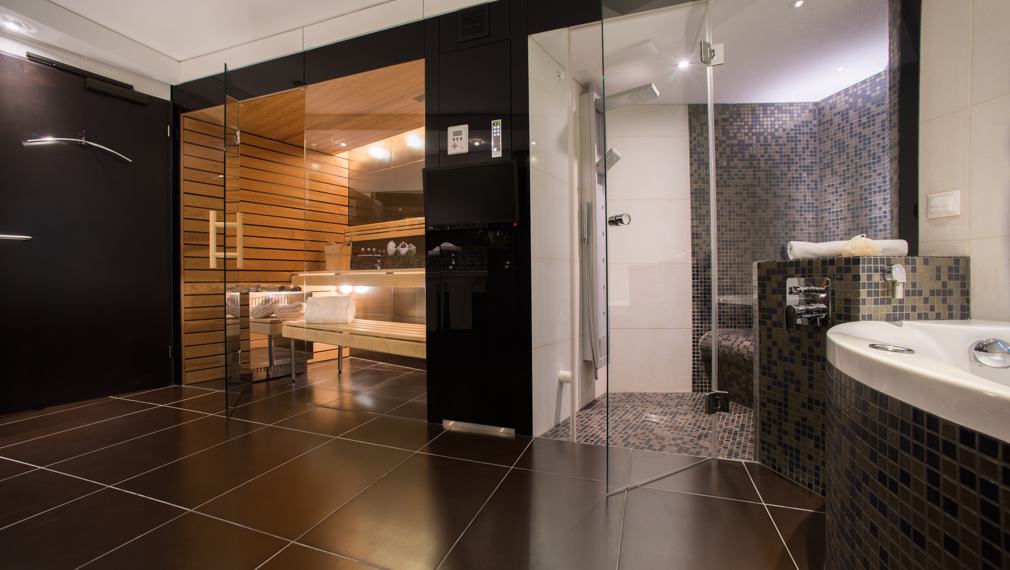
Inside the Musée de l'horlogerie in Le Locle
The next morning, we're heading to Le Locle where we visit the Musée de l'horlogerie. It is the perfect place to deepen our knowledge of watchmaking and its exciting history. Today, the museum is located inside a beautiful estate on a hill overlooking the town. However, that wasn't always the case. In fact, the museum had to move several times in its rich history dating back to 1868. Back then, the Watchmaking School of Le Locle was opened. For pedagogical reasons, the watch collections of the existing Museum of Le Locle were transferred to the new school. Subsequently, the watch museum was subject to the relocations of the school. After a period of rapid growth in 1902, the museum itself fell into neglect. At the beginning of WWII, its collections were boxed and stored away as a precautionary measure. At the end of the war, a lack of space made it impossible to house the works in a new location.
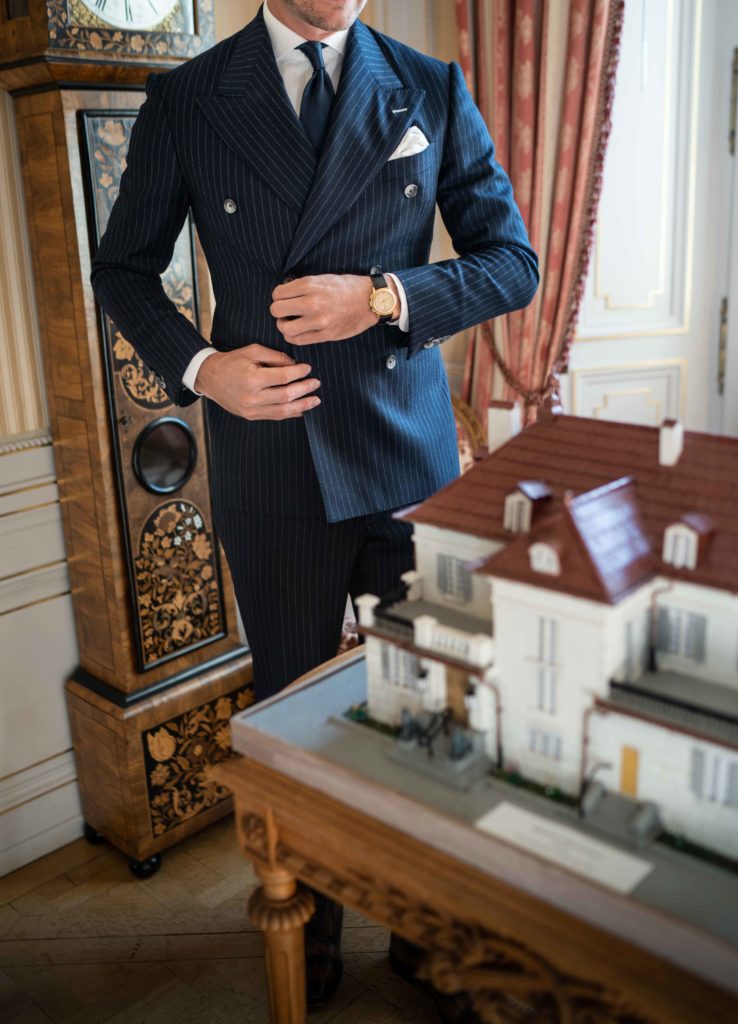
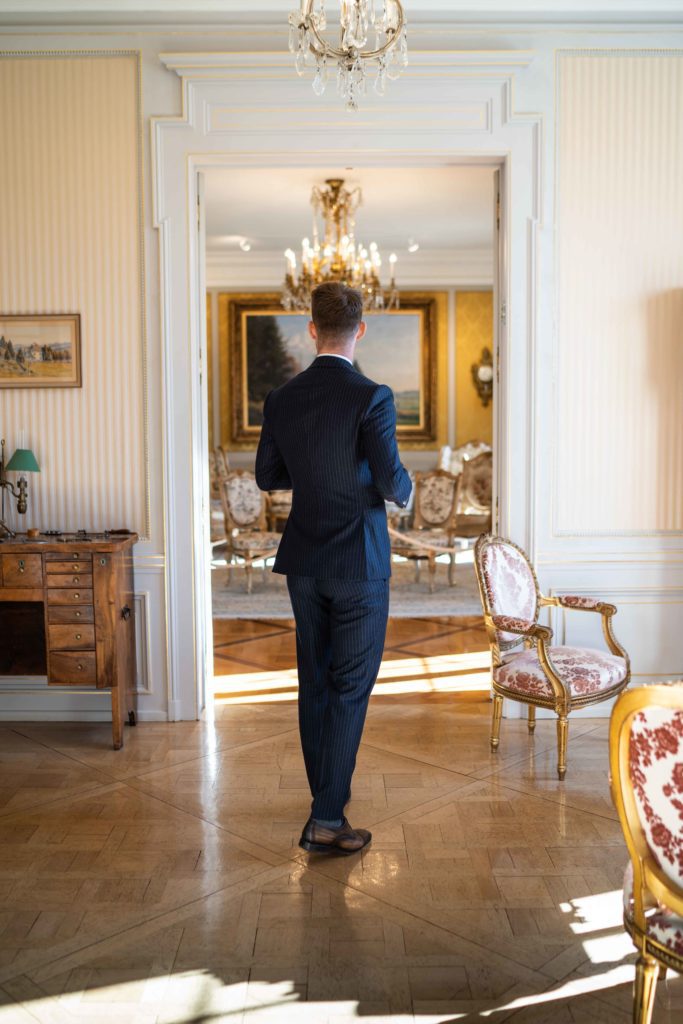
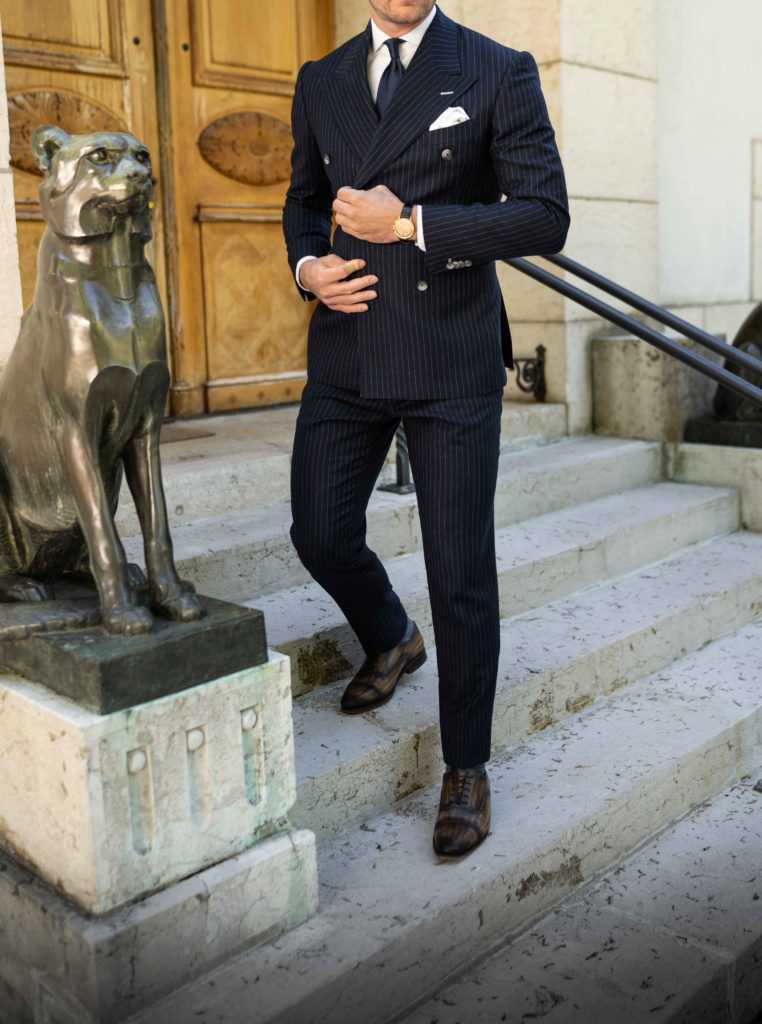
In 1951, a small group of enthusiasts luckily decided to revive the museum. However, they faced difficulties finding an appropriate building to exhibit the existing collections. Amazingly, they managed to purchase the Château des Monts. In this magnificent estate, the Musée de l'horlogerie could undergo a rebirth by opening its doors on 23 May 1959.

Zenith Watch Manufacture & Chronometry Workshop
Learning about the history of mechanical watchmaking makes us want to get a glimpse behind the scenes. Luckily, Zenith has recently partnered with the Neuchâtel Tourism Office to create an unforgettable watchmaking experience. Besides an immersive 360° experience about the inner workings of a fully-fledged watchmaking manufacture, visitors can discover crucial skills of artisans as well as different manufacturing processes. Among them are designing movements, component manufacturing and assembly of the final watch.
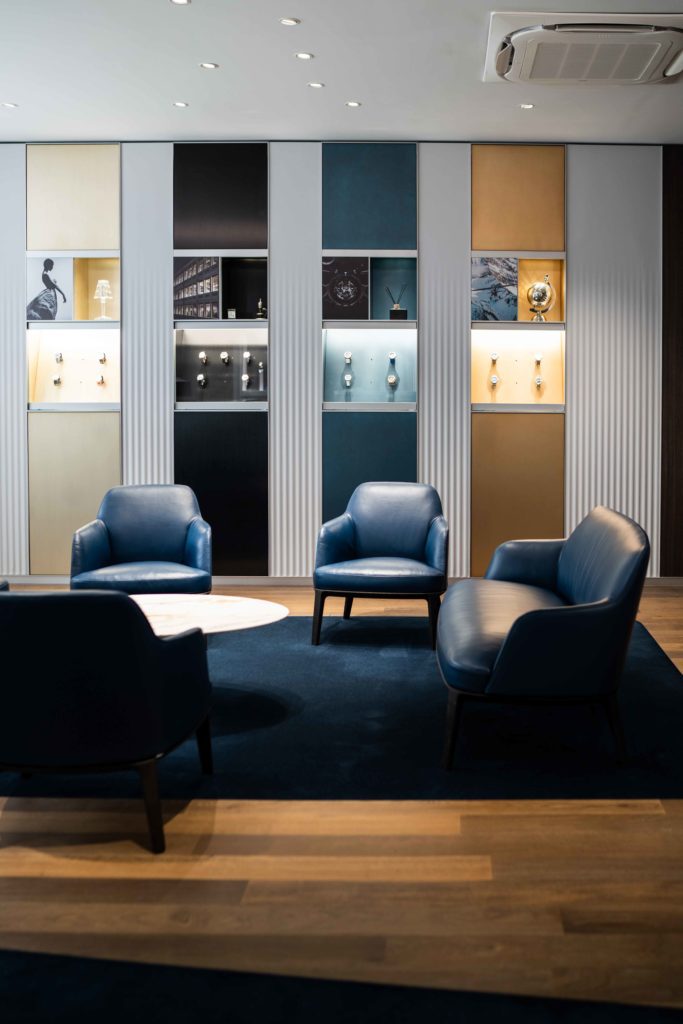

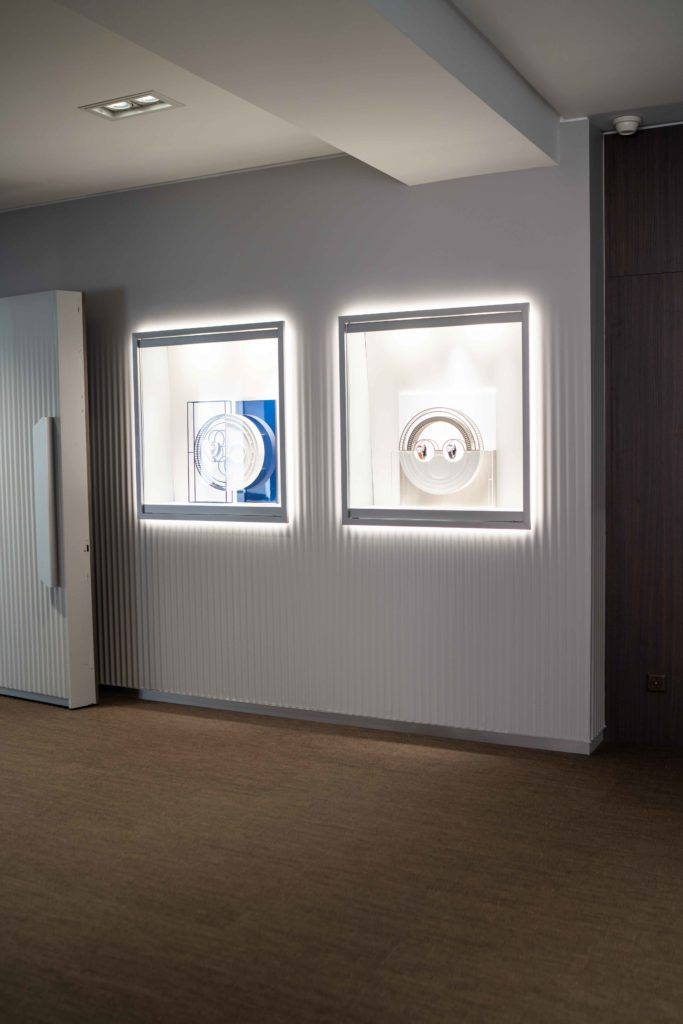
Now it's even possible to step into the shoes of a watchmaker! At the Zenith watchmaking workshopAfter a brief introduction, a passionate master watchmaker guides us through the regulation steps. Next, we even get to disassemble and reassemble the core piece of the watch. Using the watchmaker's tools to work on the balance spring is both challenging and fascinating!

Zenith's history dates back to 1865 when Georges Favre-Jacot founded the company in Le Locle. He invented the concept of "in-house movements," believing that only through control of the entire watchmaking process, perfection could be achieved. Today, Zenith is one of the oldest continuously operating watchmakers. Their manufacture comprises of 18 different buildings which have never changed since the company was founded. When setting up the premises, the idea was to bring together all the skills and crafts from the whole valley in one small space where one brand would produce the best watch.

El Primero: An iconic chronograph
One can't talk about Zenith without mentioning the iconic El Primero movement. At their manufacture, visitors can learn about the past, present, and future of the outstanding caliber, with rare watches from the archives on display for all to admire. As cheaper foreign quartz watches were taking a toll on traditional watchmaking, Zenith revolutionized mechanical chronographs in 1969 with the unveiling of the El Primero, the world's first automatic, integrated high-frequency chronograph caliber. This was the result of intensive research and development by the manufacture. Zenith envisioned a modern production method using the latest generation tools. Their designers translated the modernity of the caliber into unprecedented designs.
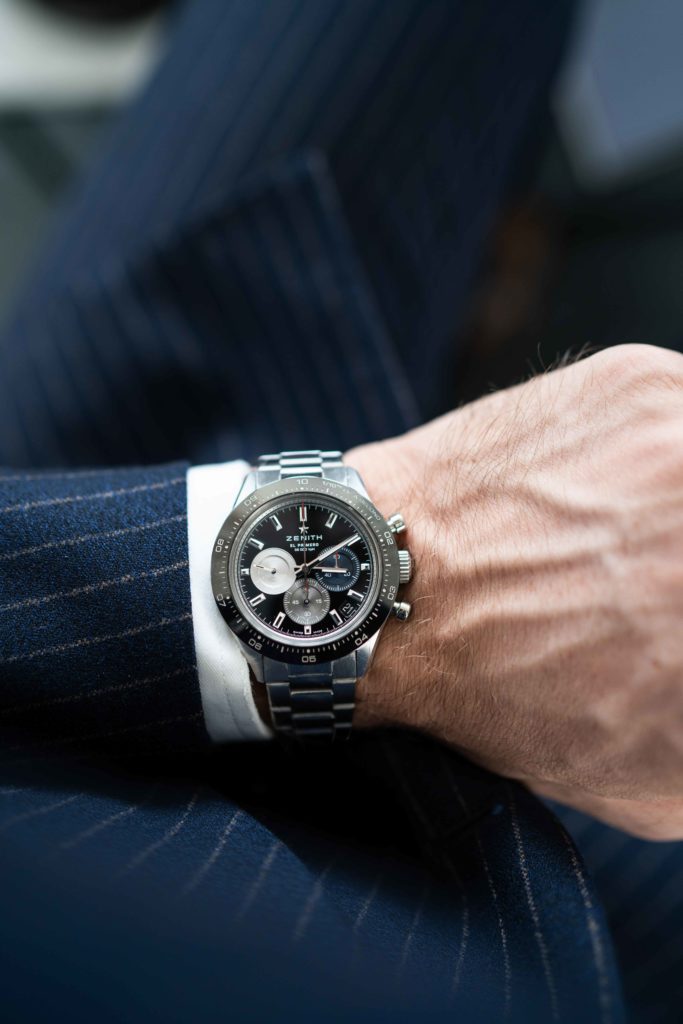
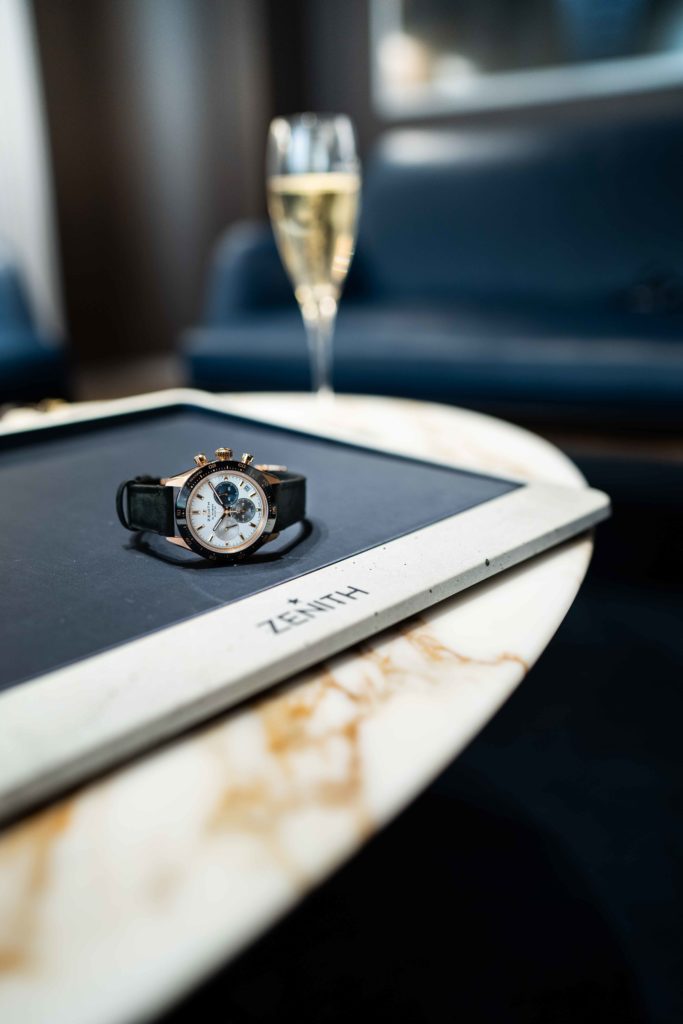
When Zenith's management decided to cease the production of the El Primero in 1975, watchmaker Charles Vermot took it upon himself to secretly protect the El Primero for future generations by gathering all the technical plans and tools necessary to produce the movement and hiding them in a walled-off section of the manufacture's attic. His heroic act became a cornerstone in the El Primero's enduring legacy. His foresight proved very valuable because demand for Swiss mechanical watches returned by the 1980s. Several watch brands reached out to Zenith asking for El Primero movements to use in their own watches. One popular example is Rolex. Their massive order eventually convinced Zenith to relaunch the unrivalled chronograph into production. Subsequently, the renewed surge in demand inspired Zenith to create its own lines of classical and sporty watches. El Primero chronographs.
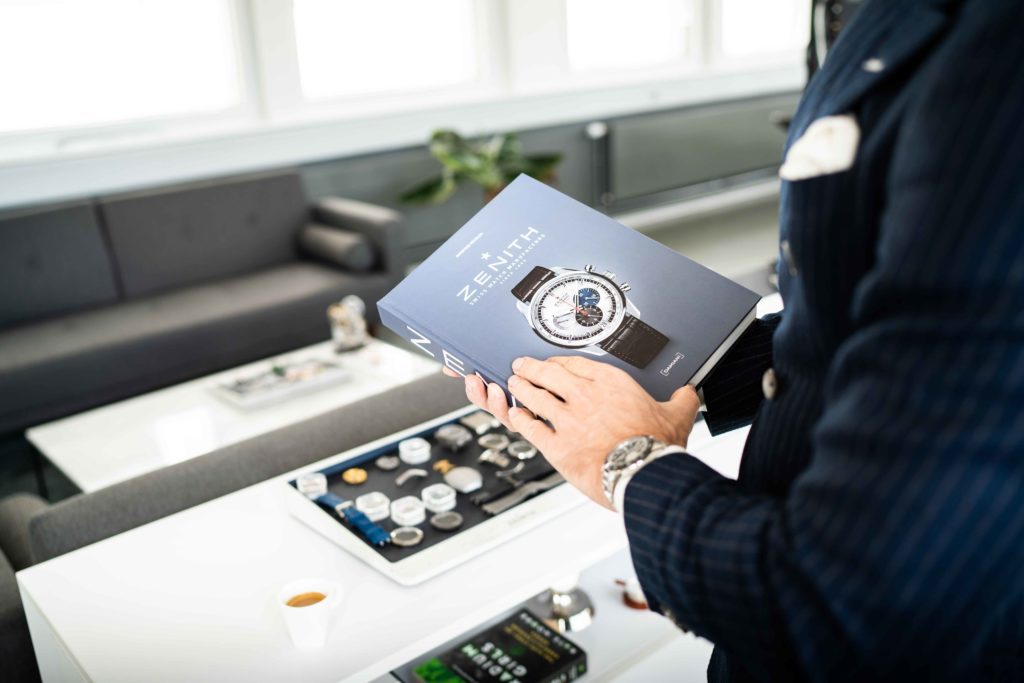
Staying at the Hotel Beau-Rivage in Neuchâtel
After two days in the mountainous Jura region, we're happy to arrive at the picturesque Lake Neuchâtel. A stone's throw from the historic town center of Neuchâtel we unwind at the Hotel Beau-Rivage. The Relais & Châteaux member also houses the O'terroirs restaurant. Offering views of the lake and the Alps, the restaurant offers a range of dishes that blend tradition with modernity.



Assembling our own Timepiece
The next morning, the highlight of our entire experience is awaiting. We are putting together our very own timepiece. Not far from the Hotel Beau-Rivage, we meet Giuseppe Picchi. The experienced watchmaker shares his knowledge with us as we assemble our own watch. For us watch enthusiasts, this is a dream come true. Thanks to Giuseppe Picchi we deepened our knowledge about mechanical watches. A day to remember!
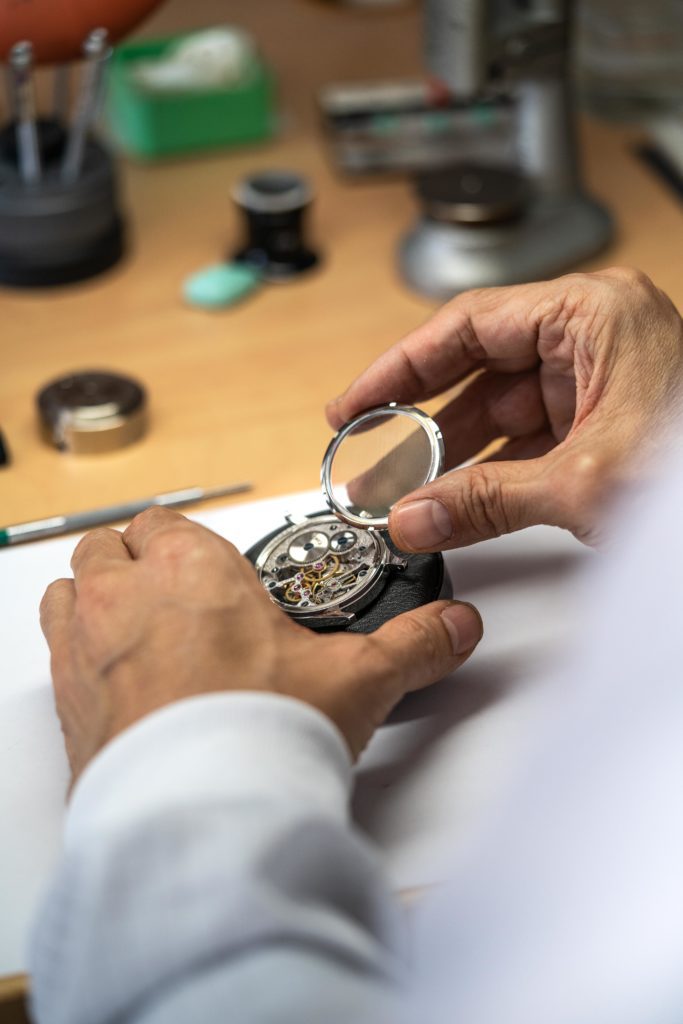
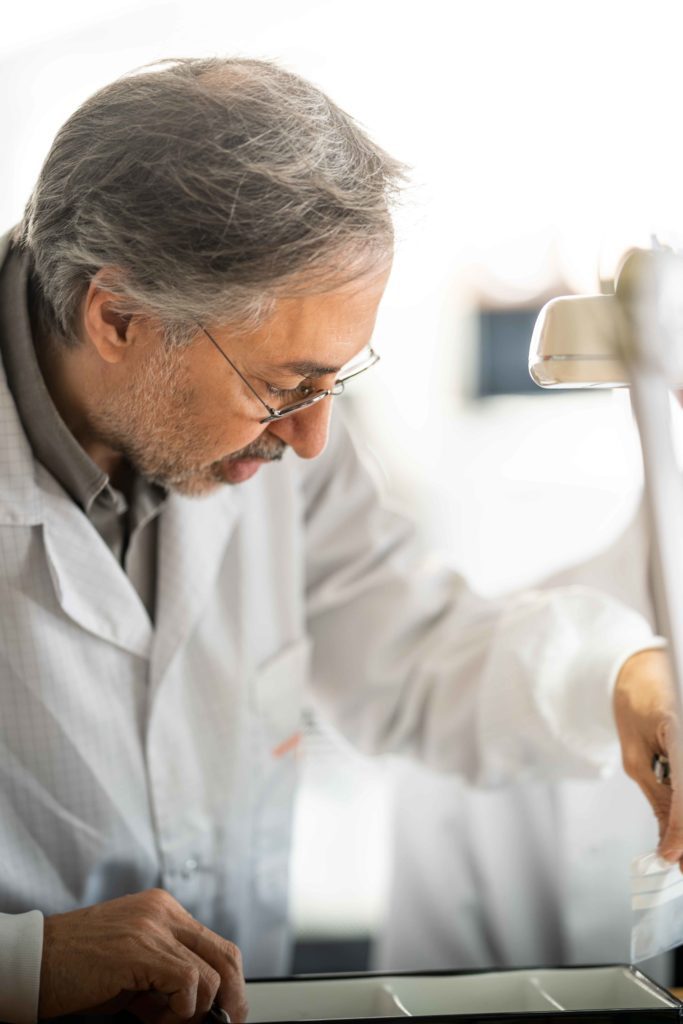
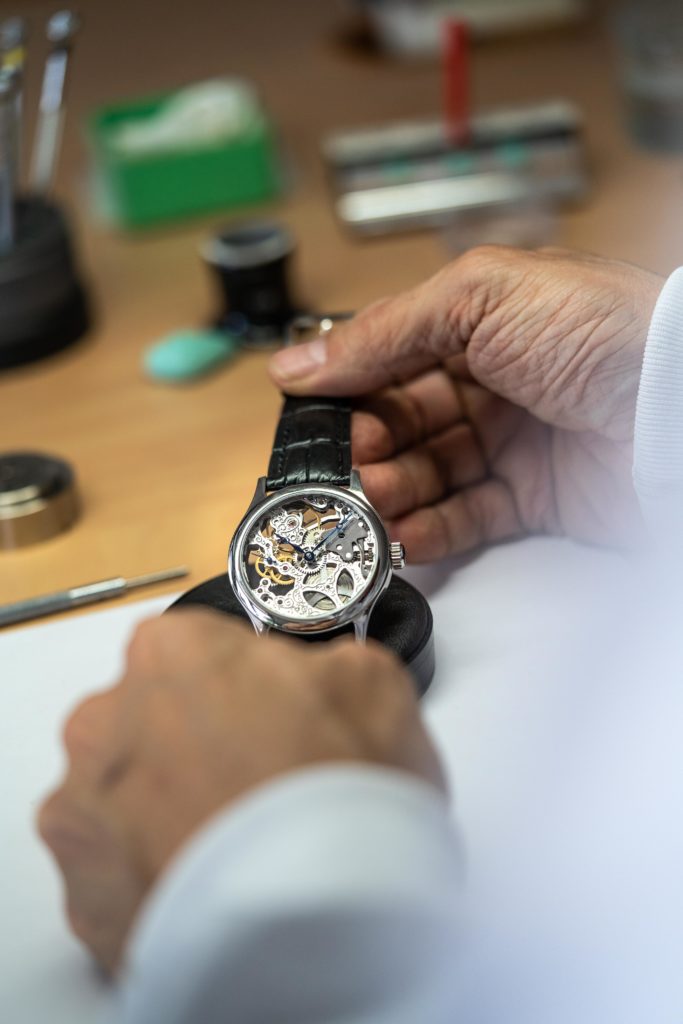
Visiting Auvernier and its Wall Clock Specialists
After a morning of hard work, we enjoy some delicious local fish dishes at the restaurant "Brasserie du Poisson in Auvernier" before heading to our last visit. The clock workshop "Au Carillon d'Or"is located at the center of the picturesque town of Auvernier. Here, we dive into a long-forgotten world. A great number of ancient clocks of various origins can be admired. The continuous ticktack surrounding is us hypnotizing. It is in this setting that we meet Thierry Amstutz. Besides repairing and creating clocks with automatons and music boxes, he is also technician-demonstrator of the Jaquet-Droz automatons at the Museum of Art and History in Neuchâtel. With over 40 years of experience there is practically no wall clock he cannot repair. Even if sometimes some pieces need to be manufactured from scratch again because replacements are no longer available. We're happy to hear that his eldest son Grégory has joined the company in December 2005. Together with his brother David he will run the family business going forward.
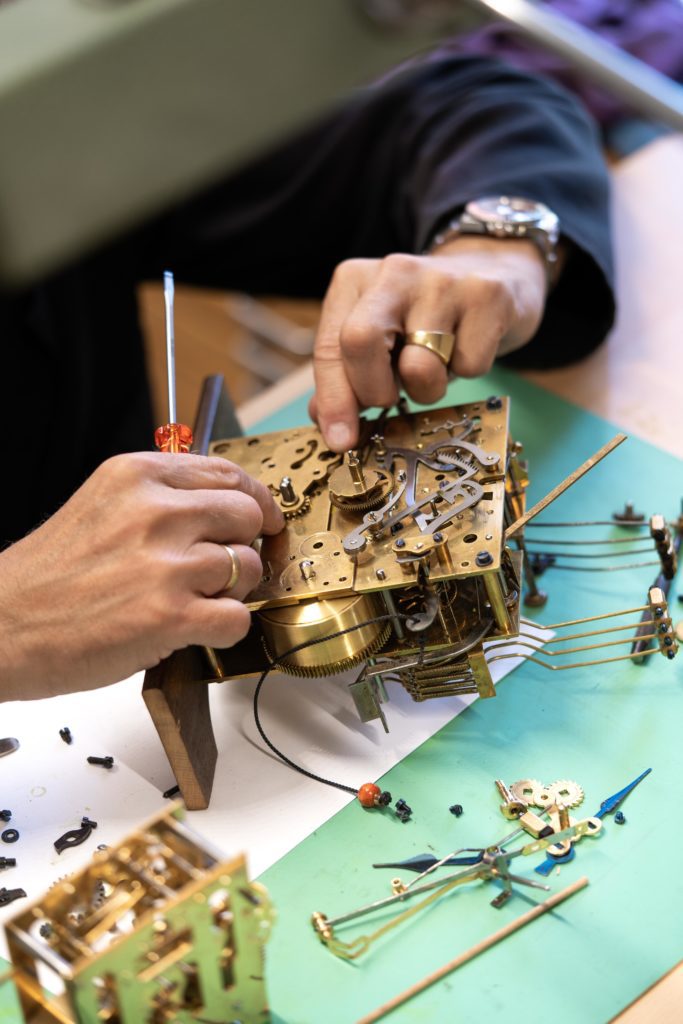
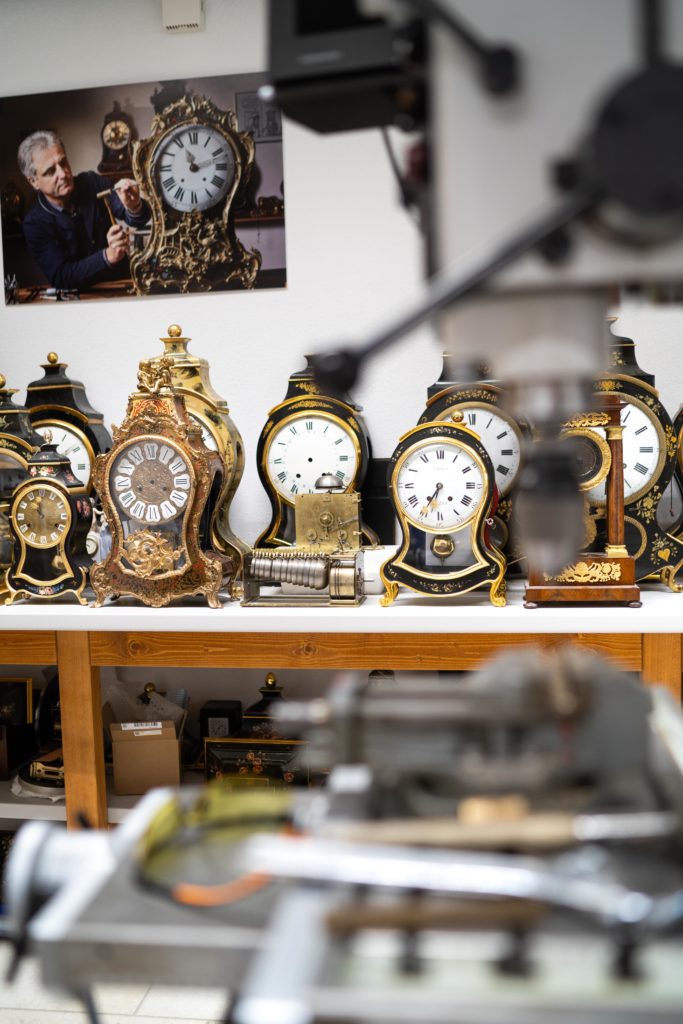
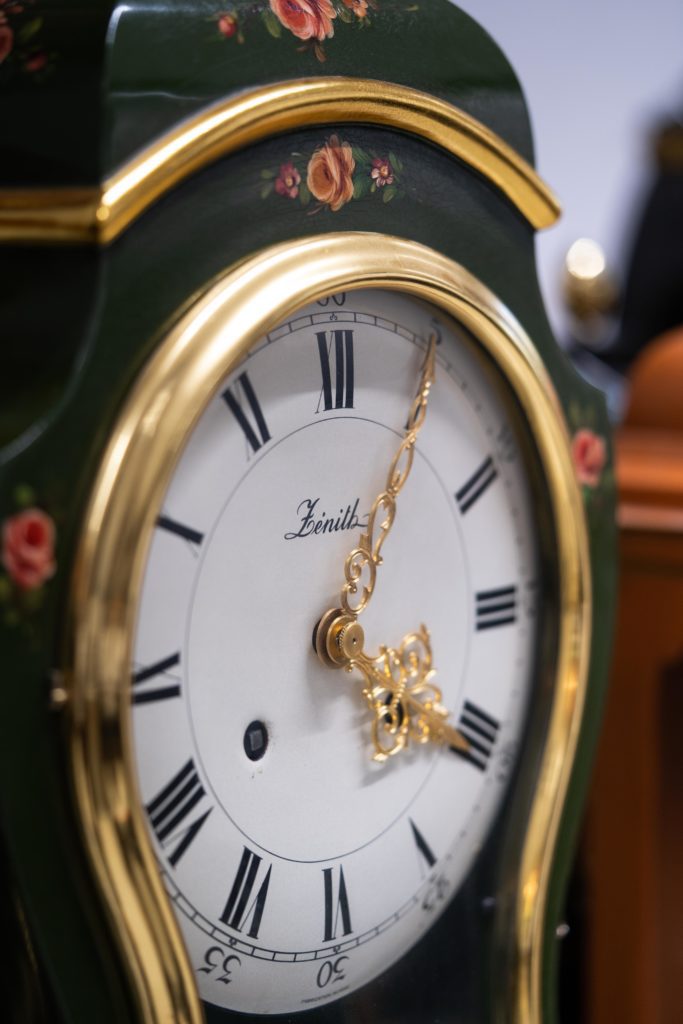
And so, our watchmaking journey is coming to an end. If you want to embark on a similar journey, visit the website of Jura Trois Lacs and discover all available watchmaking experiences.
Disruption is hard to achieve in the traditional Swiss watchmaking industry. That's exactly why Horage has entered the space. And what they have achieved after 12 years of research and development is remarkable. Let's have a look inside their manufacture in Biel/Bienne and go hands-on with the Horage Supersede. A true all-terrain GMT with an in-house movement, powered by a micro-rotor.
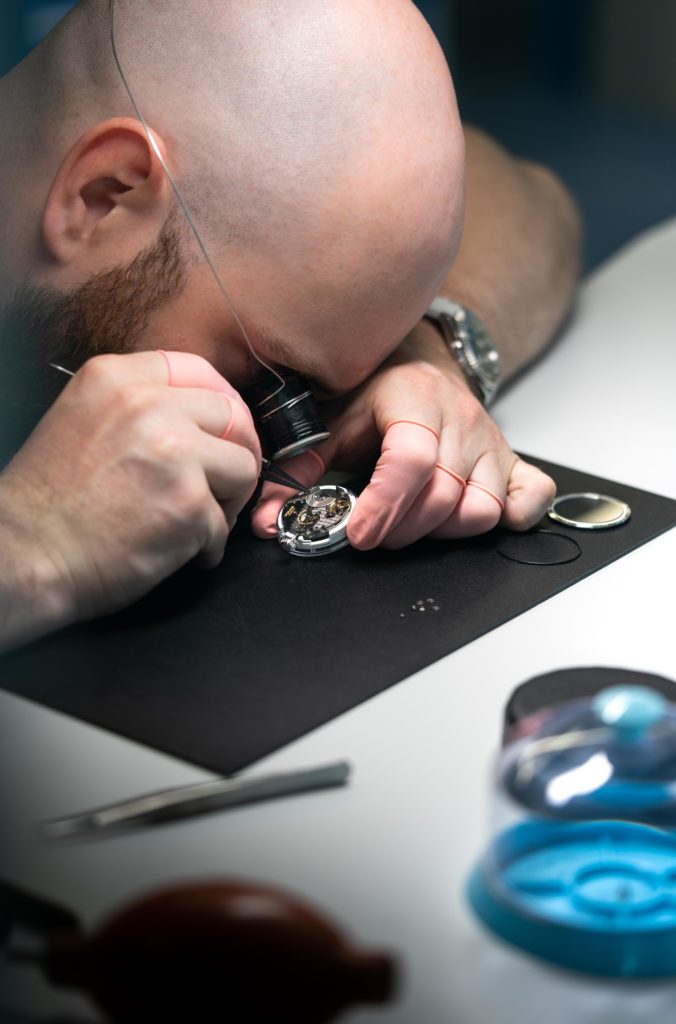
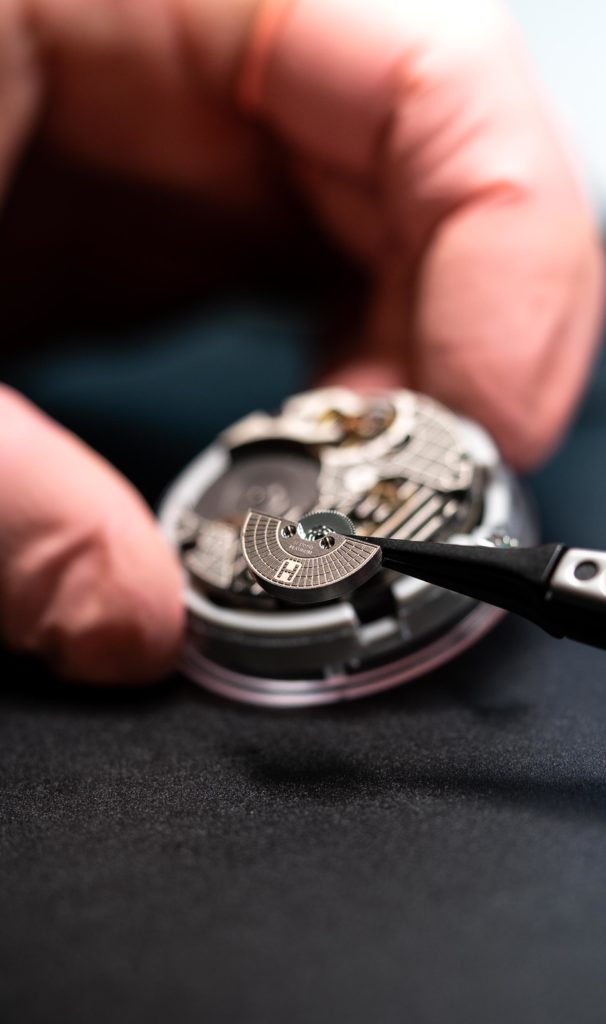
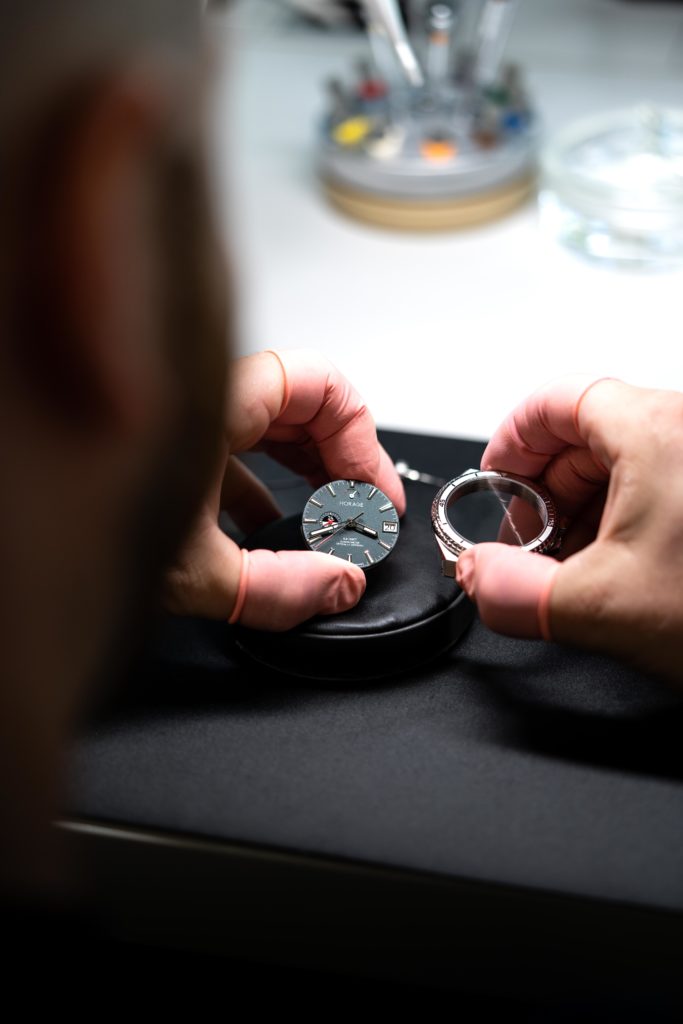
Horage - Made in Bienne
Just like us, Horage is based in Biel/Bienne, Switzerland. The town is home to the biggest and best known Swiss watchmakers. Engineering, design, and production happens at their highly industrialized facility. Truly committed to Switzerland as home of mechanical watchmaking, they reach a Swiss Made threshold of 87% to 98% in their watches. This is one of the highest rates in the industry!
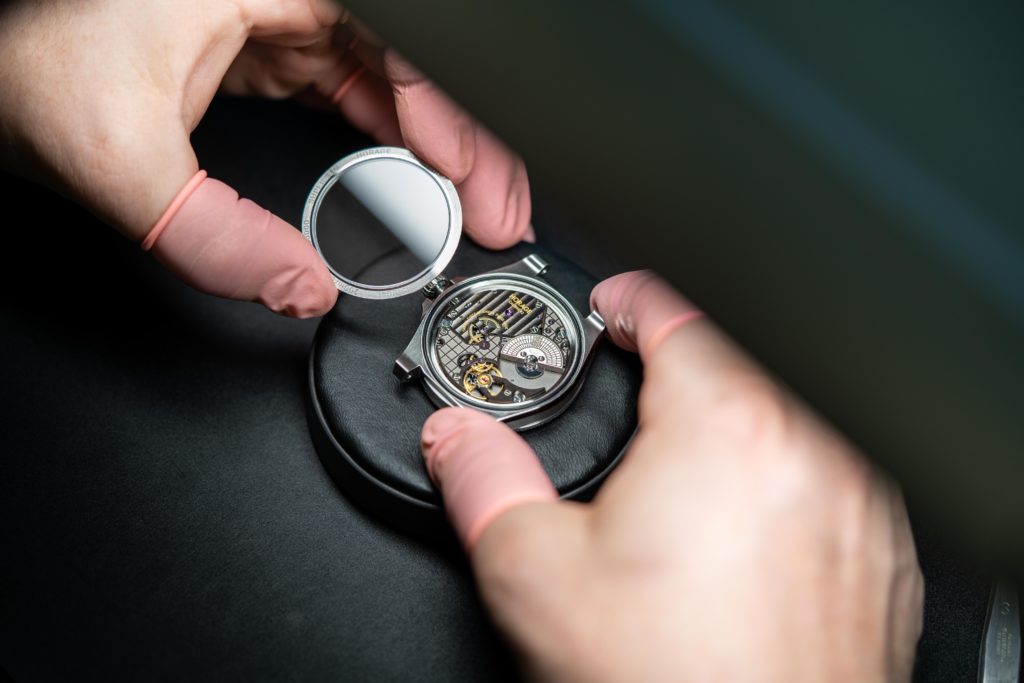
When they launched Horage back in 2009, the founders Tzuyu Huang and Andreas Fels knew they needed to bring in some of the best talent if they were to disrupt the watchmaking industry. Consequently, they teamed up with Stefan Kussmaul, a former engineer at Eterna. Three years later, Jonas Nydegger joned and took over the project. Florian Serex also brought a wealth of knowledge to the Horage projects after acting as head of renowned ETA laboratories and CEO of Vaucher Manufacture.
Ever since, Horage has been pushing the boundaries in movement production. They aim to manufacture movements that are more precise and have a higher Swiss Made threshold, while also being more affordable. After achieving a breakthrough with their sturdy in-house Tourbillon 1 movement, available for (only!) around $6'900, they now want to shake up the GMT category. Their goal: manufacturing the most accessible Swiss micro-rotor GMT. The result is Supersede, a thin, all-terrain ready timepiece on an integrated steel bracelet.
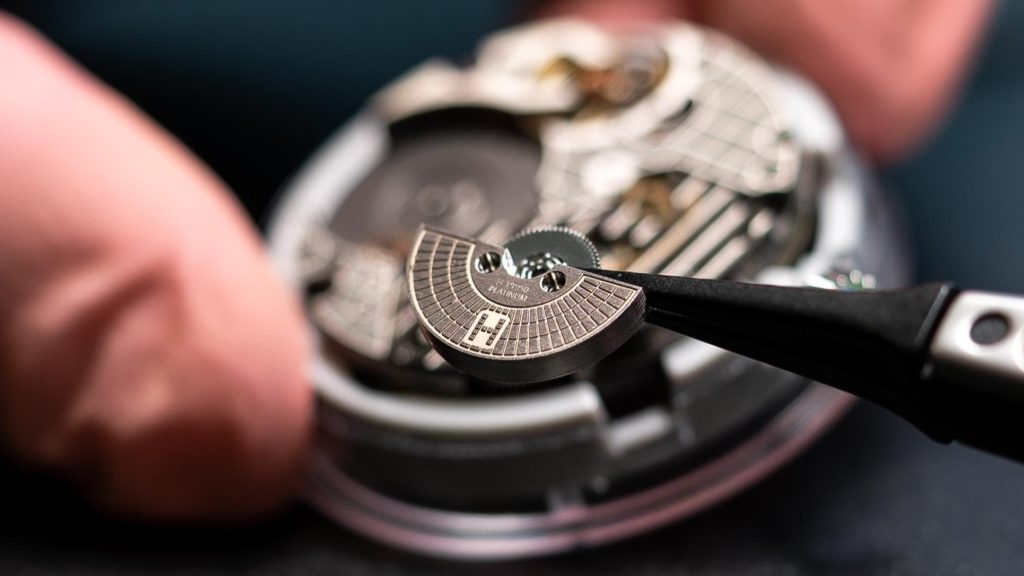
Hands-On with the Horage Supersede
First things first: While the market start point for Swiss micro-rotors with three hands is around $7'500, Supersede will have a final retail for around $6'500. A true all-terrain GMT, the timepiece comes on an integrated steel bracelet and in-house movement. And its K2 micro-rotor movement is thin. With its dimensions of 3.6mm x 30mm it achieves +72 hours of power reserve. Equipped with silicon spring & escapement, the movement is hand finished with Côtes de Genève and square black gold bridge decorations.
Overall, the watch is 98% Swiss Made. A threshold almost unheard of at this price point. Especially considering that the timepiece is powered by an in-house movement.
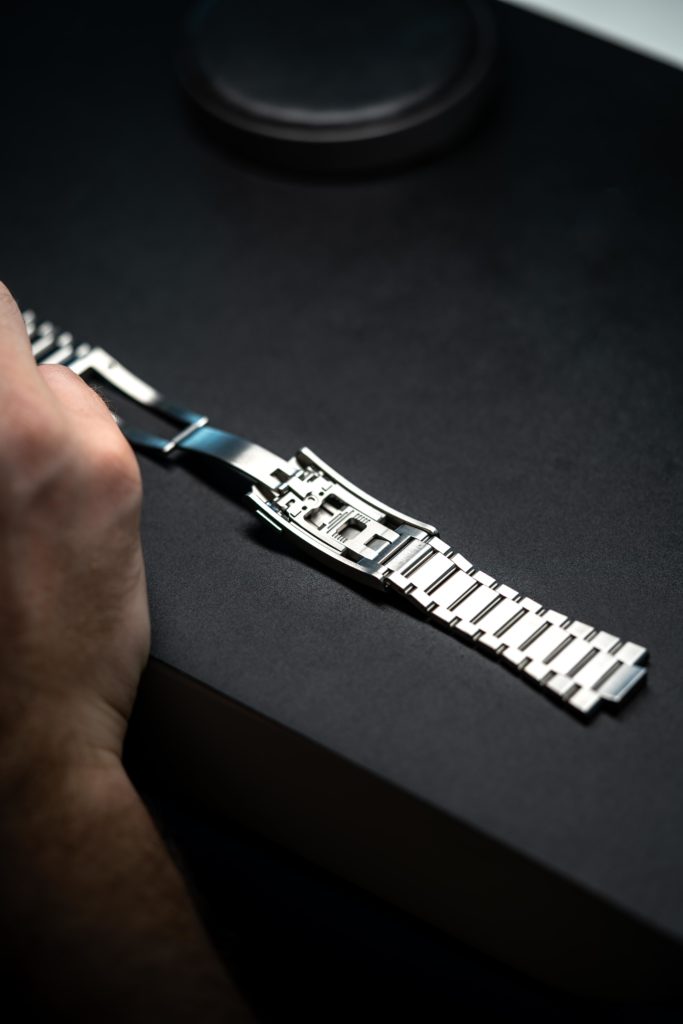
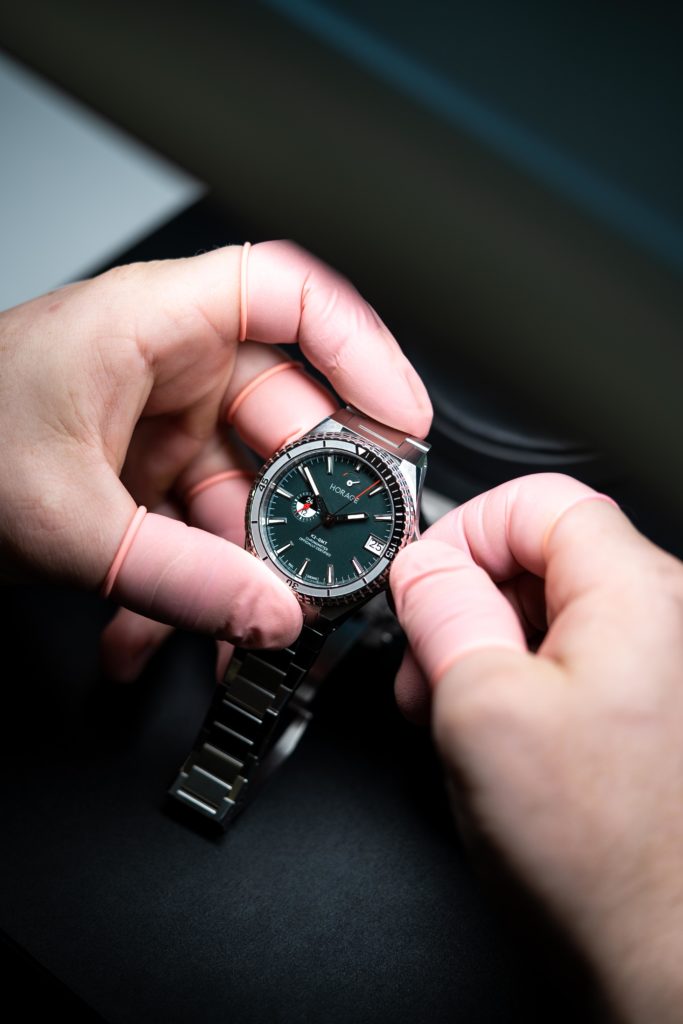
Supersede - A Day on the Wrist
What we love about the Supersede is its dimension. Its dial has a diameter of 39.5mm and a thickness of 9.85mm. At a lug to lug distance of 46.29mm, the watch sits perfectly on the wrist. Especially considering its beautifully executed integrated bracelet with 3-point micro-adjustment buckle.
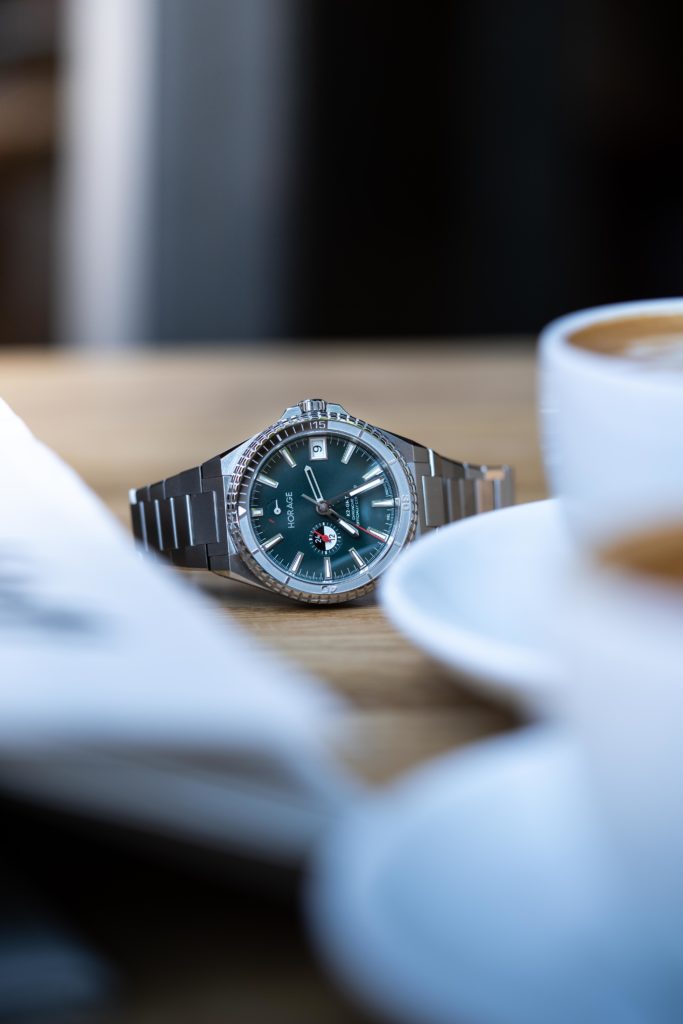


Besides Boreal Green, the watch also comes in the colors White, Transatlantic Blue, and Atoll Blue. While all are coming on the high quality 904L steel bracelet, rubber straps in different colors will also be available soon.
For us, the Horage Supersede is the perfect daily watch. The steel sports watch aesthetics match both a suit and t-shirt & jeans. While the GMT and big date indication make the watch a useful tool, the true beauty of the timepiece ticks inside. The K2 micro-rotor movement is another breakthrough for the young team that is revolutionizing the watchmaking industry from within their manufacture in Biel/Bienne.
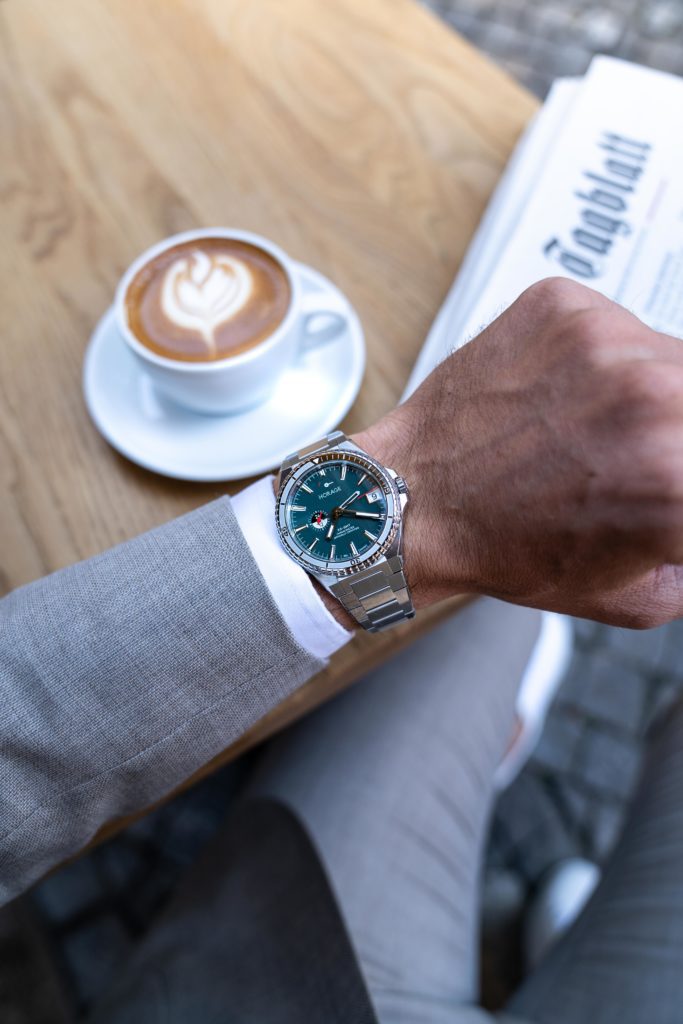
To read more stories like this one click here.
Did you know that Carl F. Bucherer is one of Switzerland's leading watch manufacturers? The brand is developing outstanding mechanical movements and watches in its own manufacture in Lengnau, Switzerland. Every timepiece that leaves the Carl F. Bucherer workshop is a miniature work of art. Let us show you why!
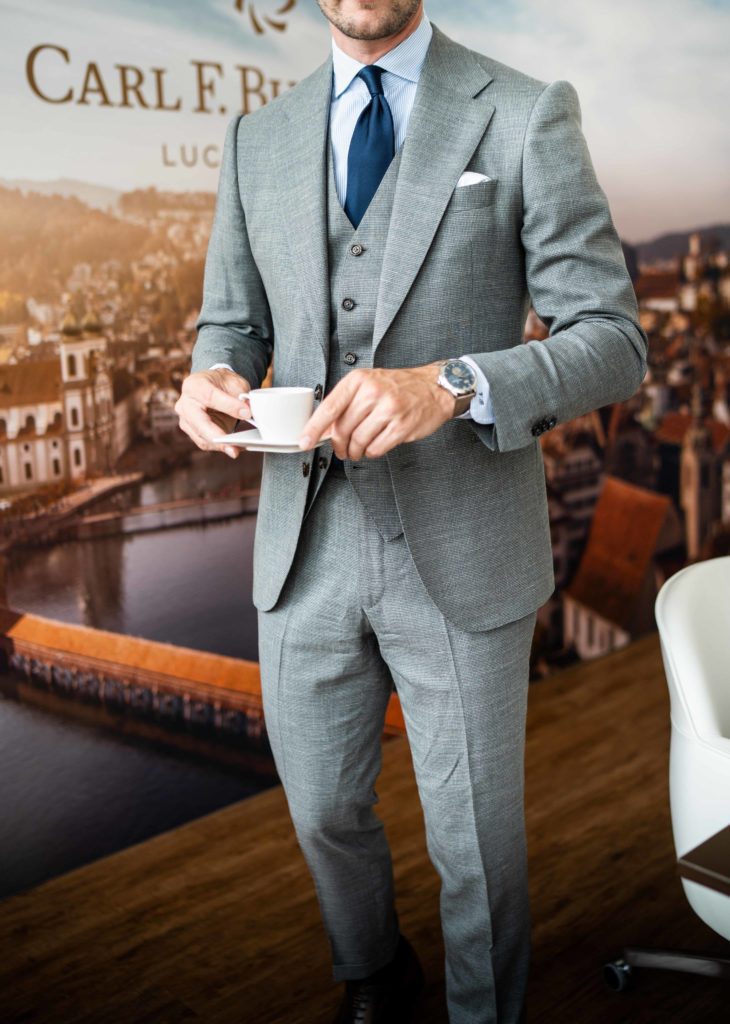
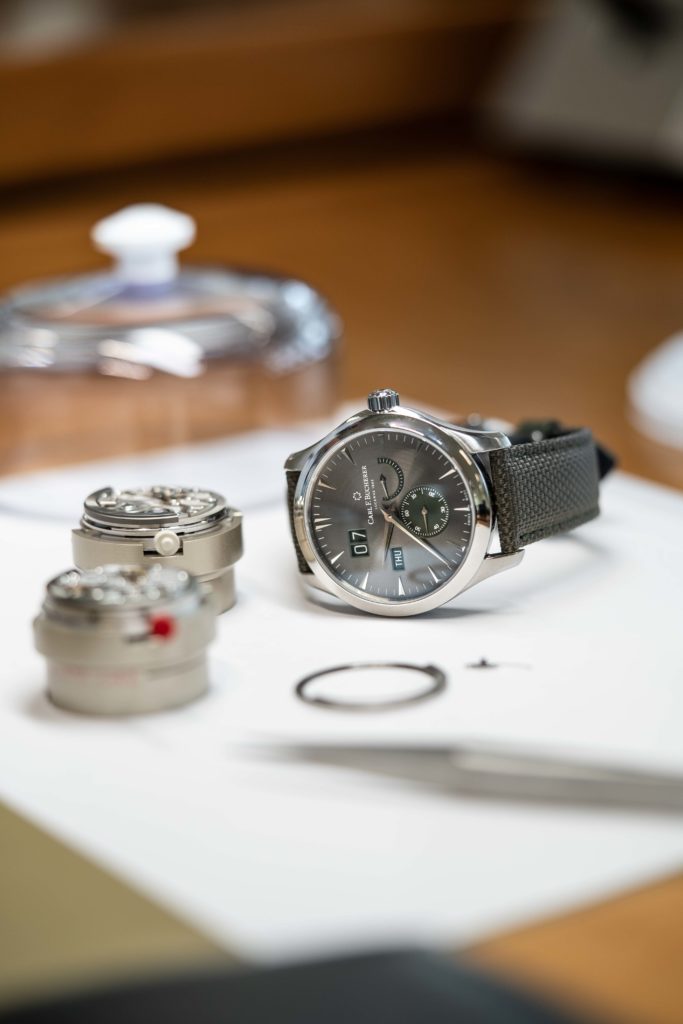

Inside the Carl F. Bucherer Manufacture
The history and development of the Lucerne-based watch brand is closely linked to the person of Carl Friedrich Bucherer. He was a visionary who created timepieces that moved with the times. Quite literally. He always aimed to combine extravagance and aesthetic appeal in extraordinary ways. In 1888, Carl Friedrich Bucherer opened a jewelry and watch store in Lucerne. Thereafter, his name rapidly became a synonym for quality and originality. His two sons followed in his footsteps: one became a watchmaker while the other trained as a goldsmith. Today, the combination of these two skills is still reflected in the Carl F. Bucherer timepieces.
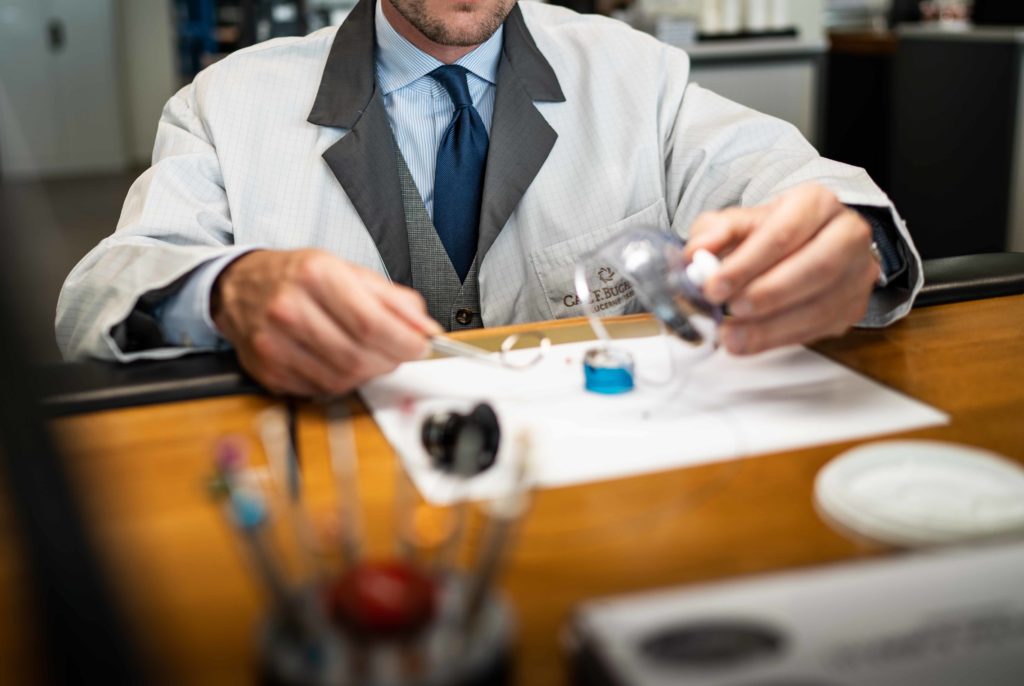
Carl F. Bucherer's recent history is shaped by the launch of the in-house manufactured CFB A1000 movement in 2008. It is equipped with a unique peripheral rotor. Soon after the launch of this revolutionary movement, the brand became a member of the illustrious Fondation de la Haute Horlogerie.
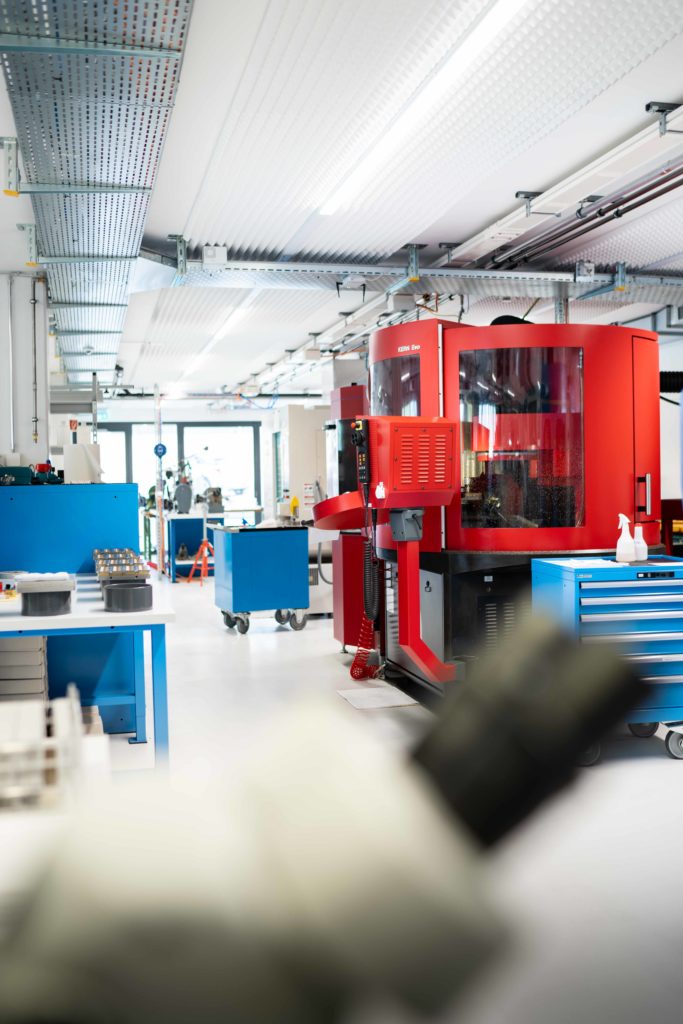
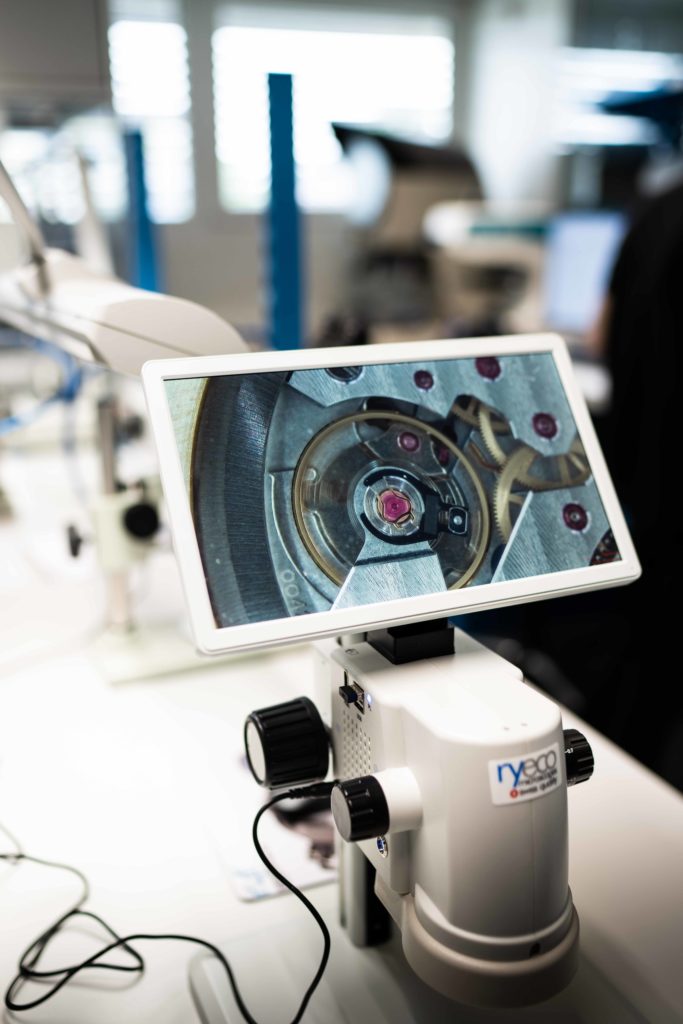
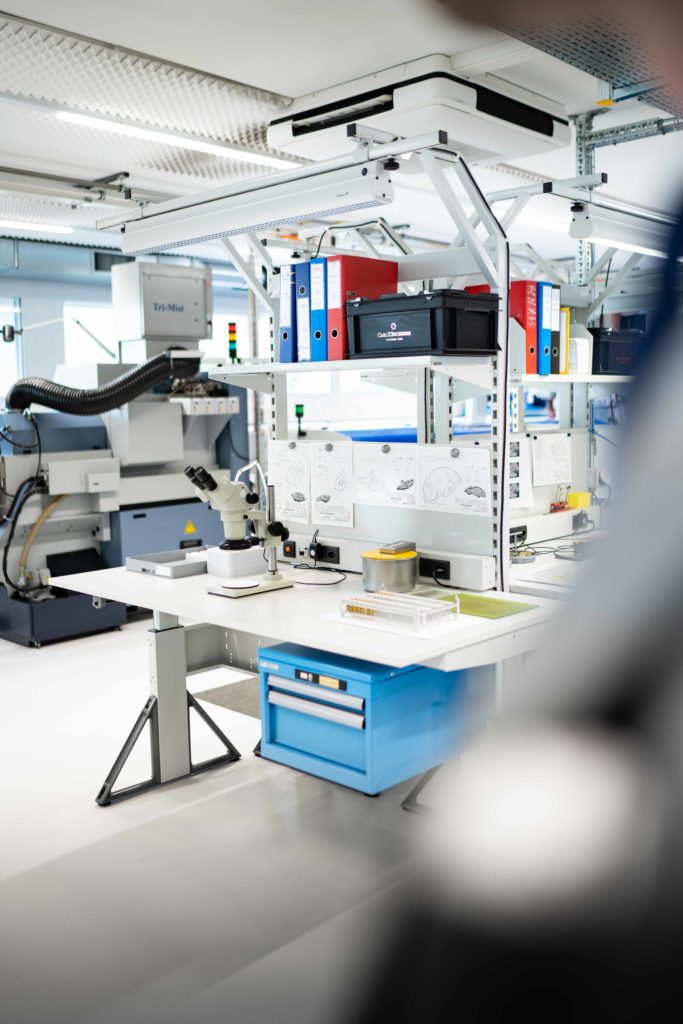
The groundbreaking movement and its predecessors are the center of attention at the Carl F. Bucherer manufacture in Lengnau, a small watchmaking town situated between Geneva and Zurich. Here, the 4 in-house movements are manufactured by skilled artisans.
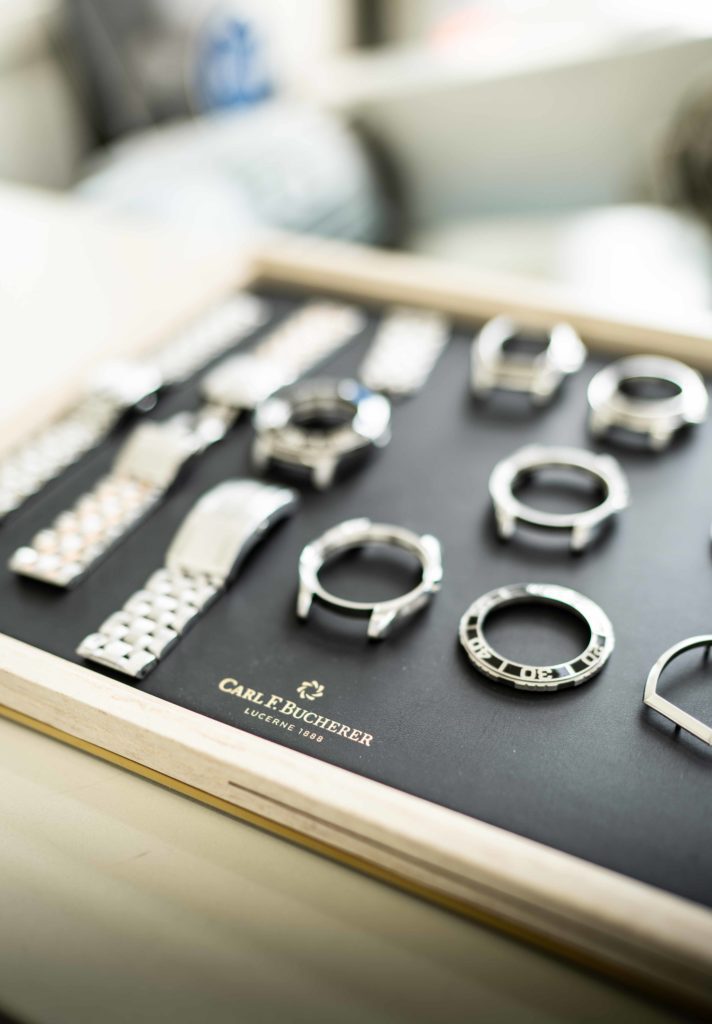
The Peripheral Technology by Carl F. Bucherer
Movements using the peripheral technology feature a special winding mass. It's a peripherally-mounted annular segment, swinging bidirectionally around the movement. It replaces the centrally-mounted oscillating weight, which usually rotates over the movement. While the technology allows for thinner watches, it also offers an unobstructed view of the beautifully finished movement. This is very attractive to watch enthusiasts and aficionados like us.

While at the manufacture, we get to see how the Manero Peripheral BigDate is assembled. A very delicate task that involves many different parts and requires a steady hand.
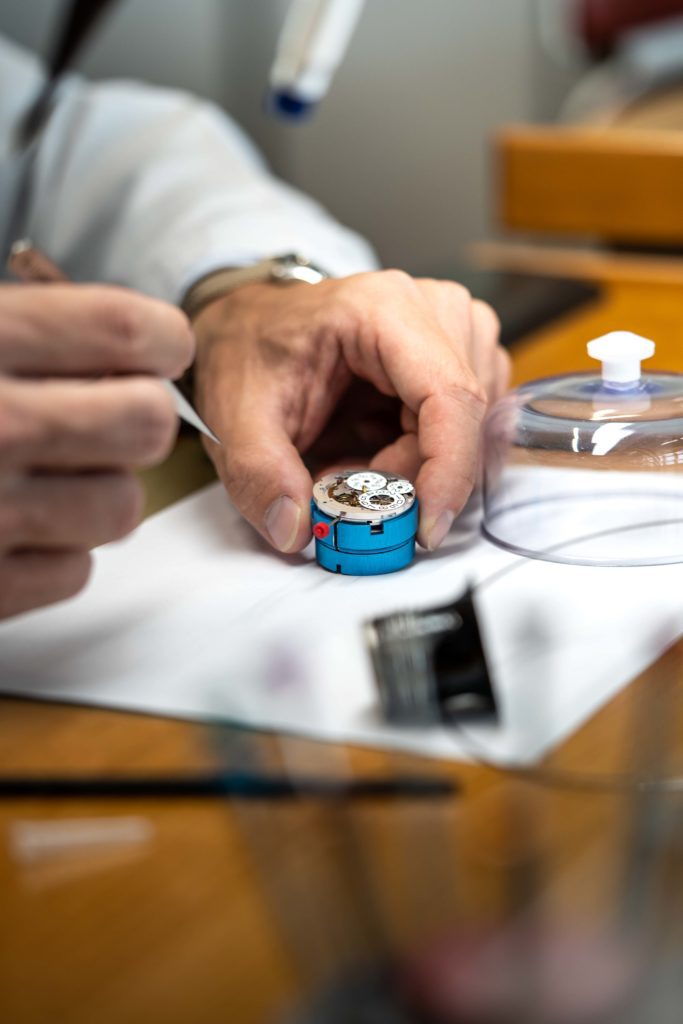
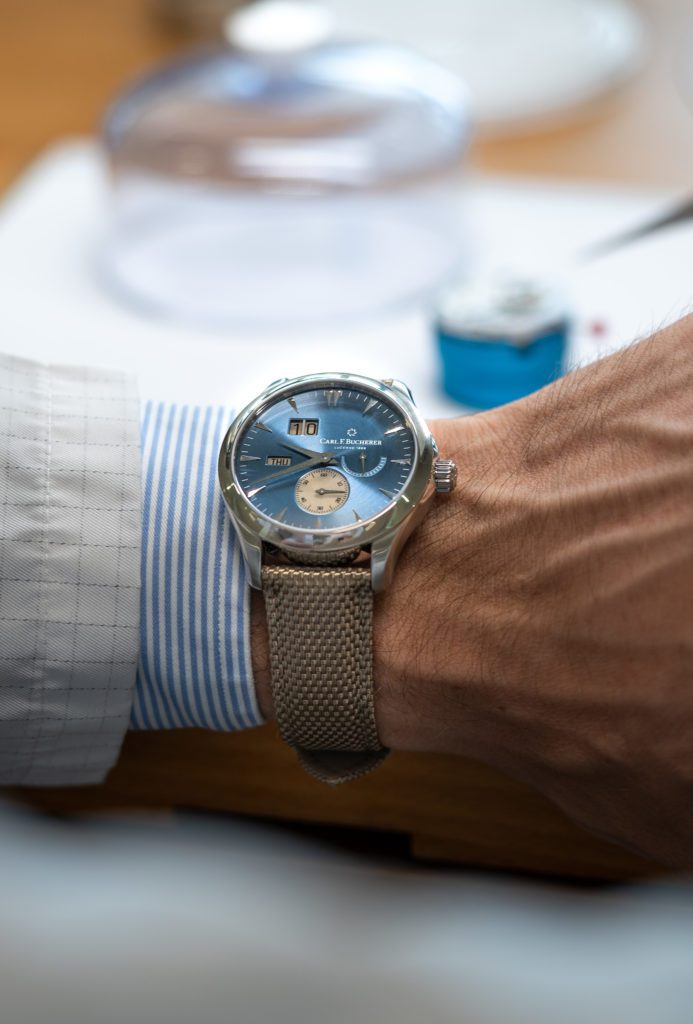
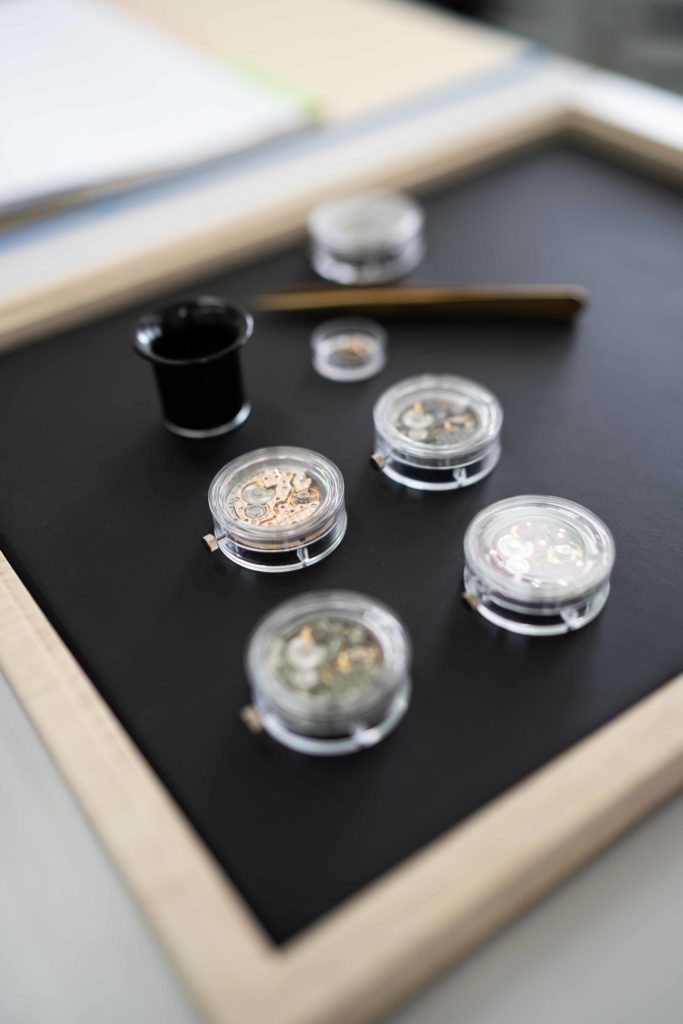
Carl F. Bucherer Manero Peripheral BigDate
The Manero Peripheral BigDate is an outstanding timepiece that perfectly blends design, material, and technology. Its 42mm stainless steel case houses the automatic CFB A2011 movement. It offers a power reserve of 55 hours and is water-resistant to 3 bar (30 m). At CHF 8'300, you get a whole lot of engineering, craftsmanship, and design for your money.
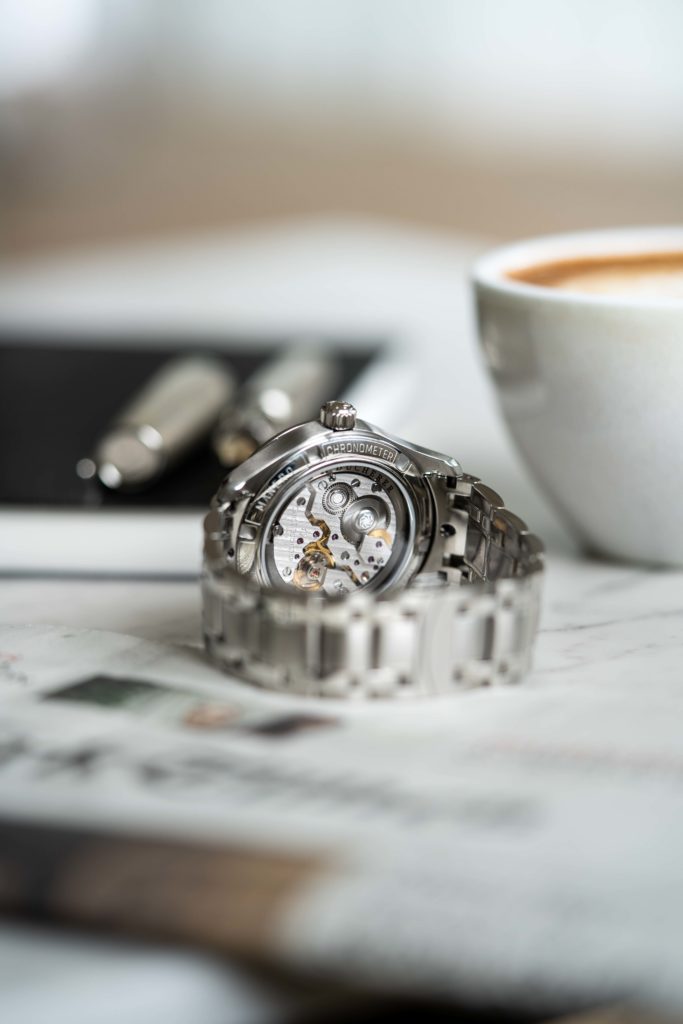

The Manero Peripheral BigDate has been interpreted in two distinct versions. One has a light blue dial with a contrasting small-seconds subdial in beige, followed by a big date and day-of-the-week aperture in the same color.
The other has been crafted with a dark gray dial with a contrasting olive-green small-seconds subdial and power reserve indication, followed by a big date and day-of-the-week aperture in the same color. Each dial option is presented on either a textile strap matching the subdial or on a robust stainless steel bracelet. Which one do you prefer?
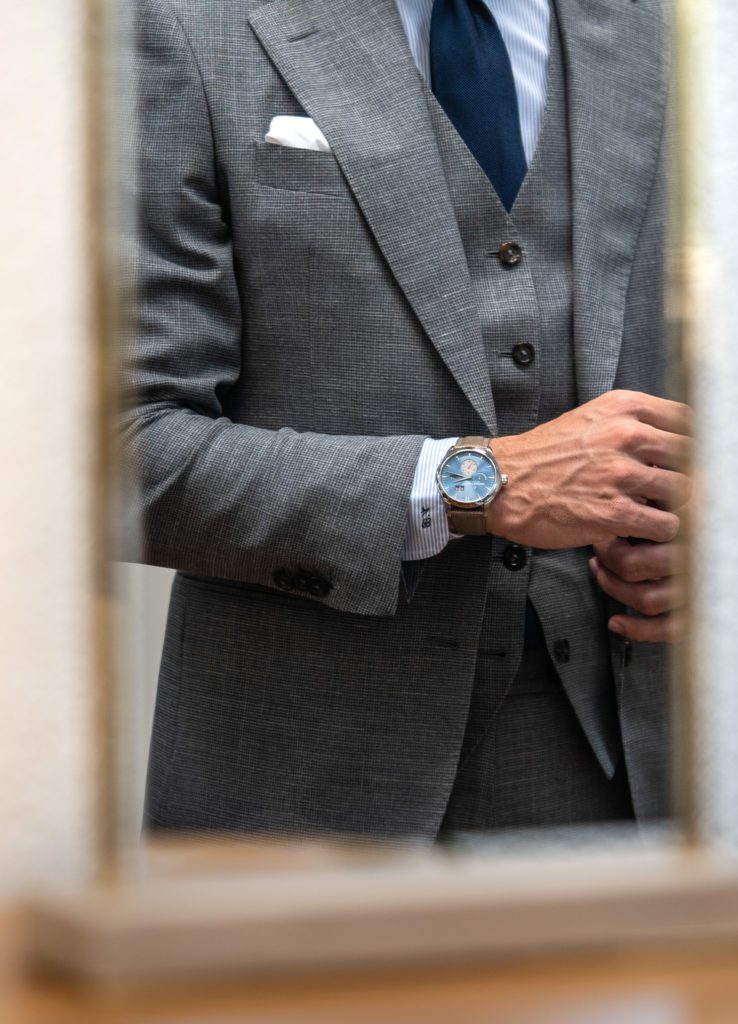
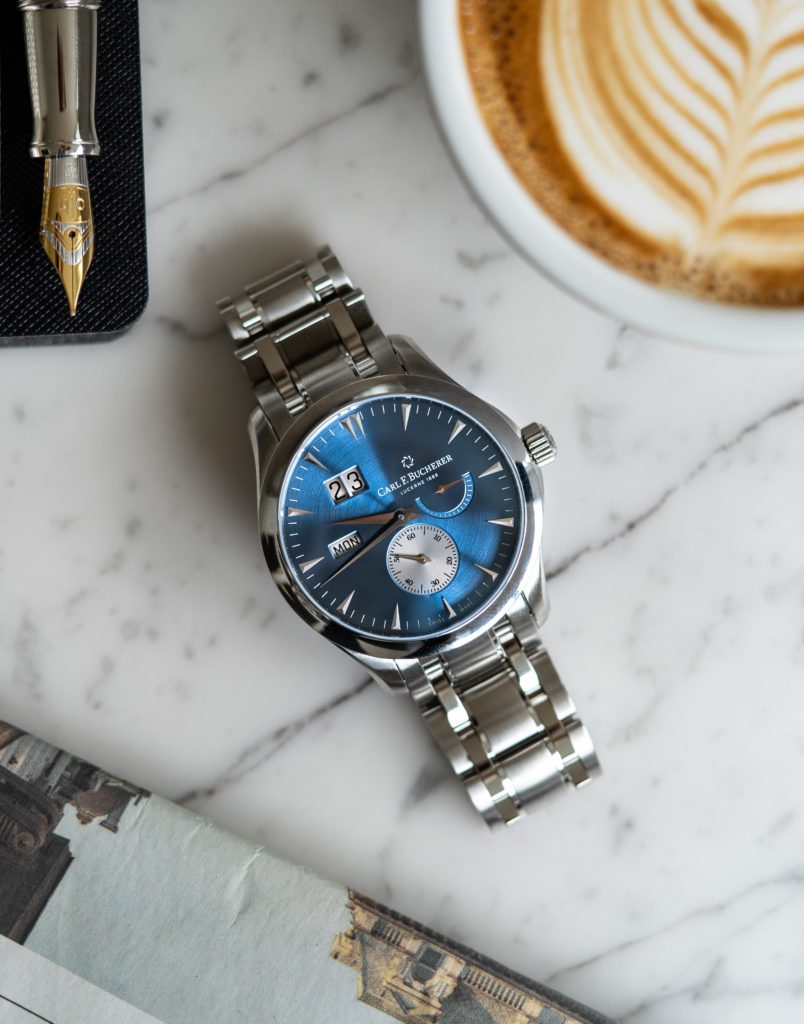

To learn more about Carl F. Bucherer, read this article about their stunning Heritage BiCompax Annual Hometown Editions.
The Swiss watch brand OMEGA is updating its iconic Speedmaster family with seven new timepieces that are part of the Speedmaster Chronoscope collection. The timepieces take inspiration from OMEGA's chronograph wristwatches from the 1940s. Let's discover these novelties together!
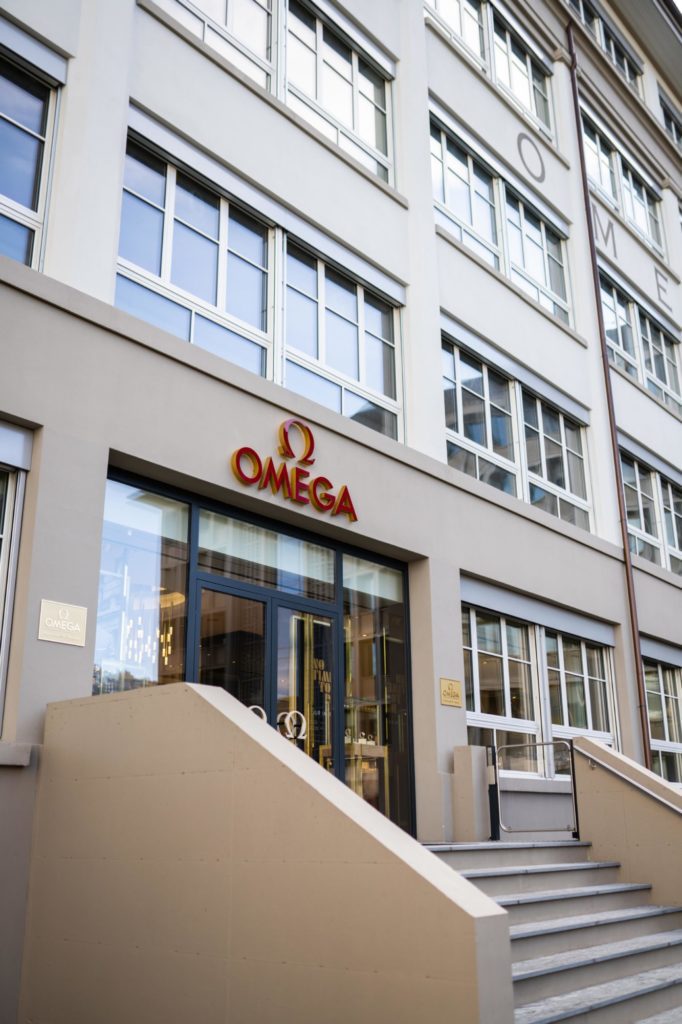
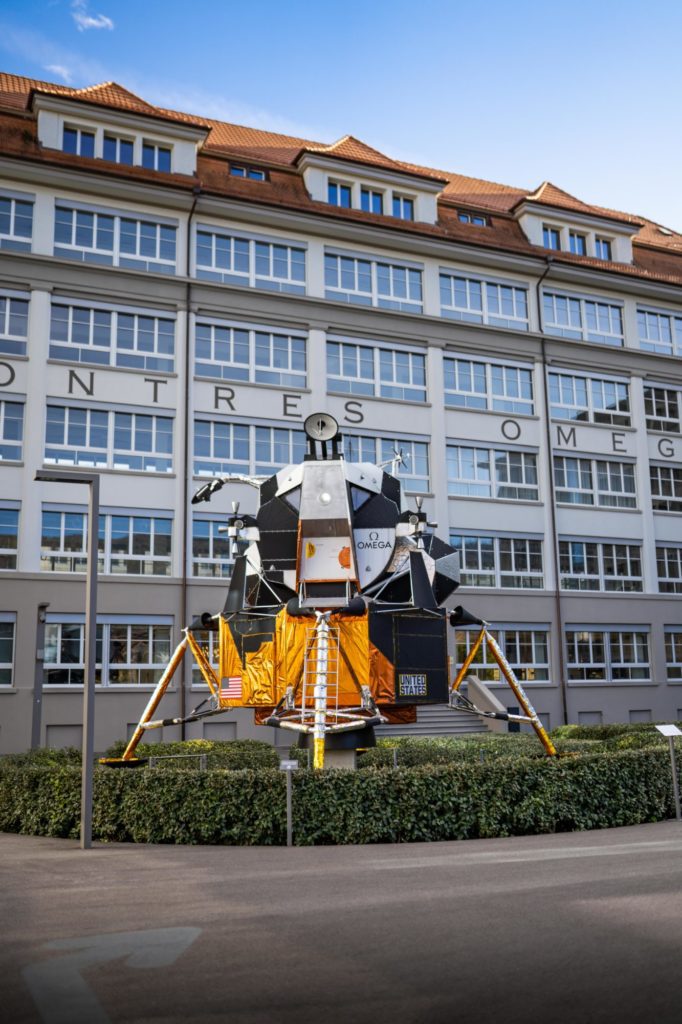

Hands-on with the Omega Speedmaster Chronoscope
With the Speedmaster ChronoscopeOMEGA is returning its vintage roots and rich history. The leaf-shaped hands and three "snail" timing scales on the dial give these watches a clear link to 1940s watchmaking. There's also an elegant addition of a "spiral" track pattern that runs beneath the Arabic numerals. We love how the style is very similar to the spiralling subdials one finds on most Speedmaster models.
Attached to each 43 mm case, the watches can either be worn on leather straps or the new Speedmaster steel bracelets. These polished-brushed stainless steel bracelets have already won our hearts. We love OMEGA's patented comfort release adjustment system.
Surprisingly, a new calibre has been developed for this collection of Speedmaster watches. Through the sapphire crystal on the caseback, owners can view the manual-winding OMEGA Co-Axial Master Chronometer Calibre 9908. Now let's get to the functionalities of the watch. Printed in a 1940s "snail" design, each dial reveals a three different scales for measuring. But what exactly?
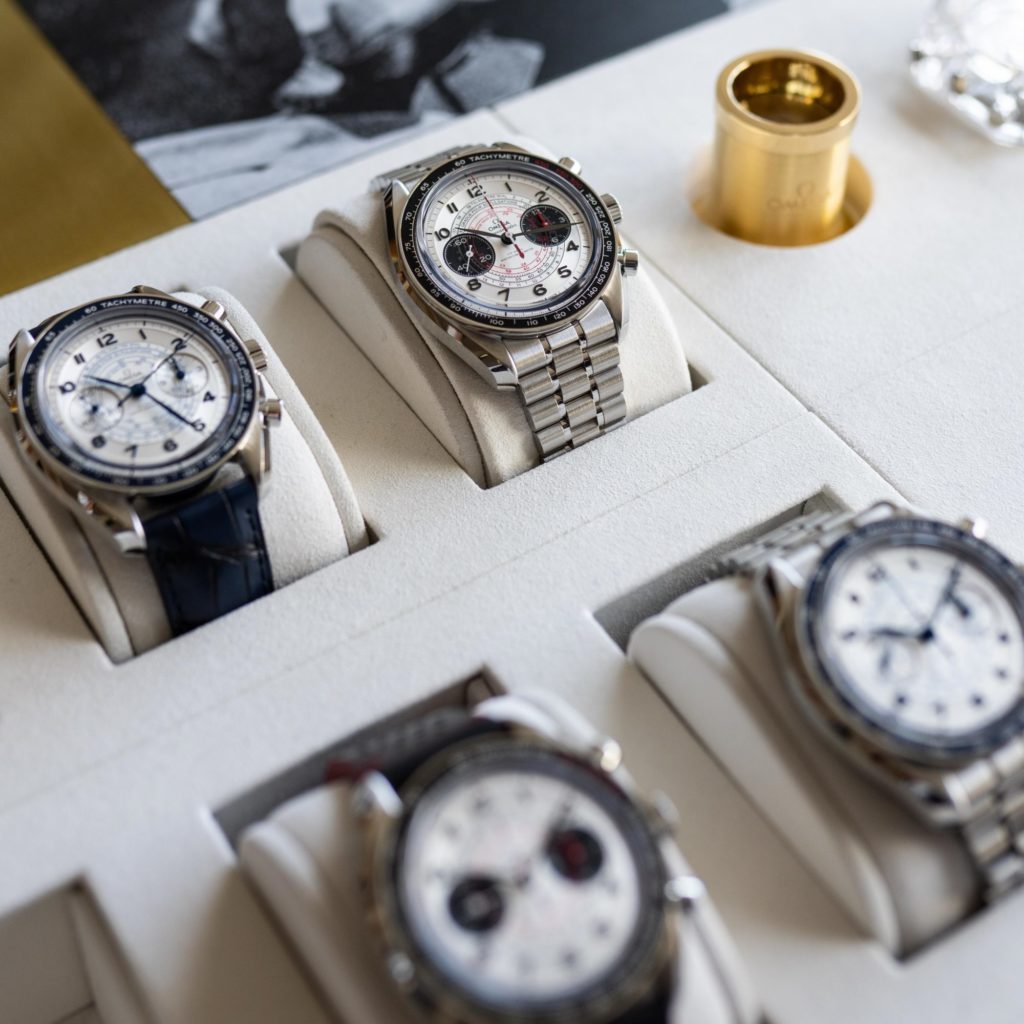
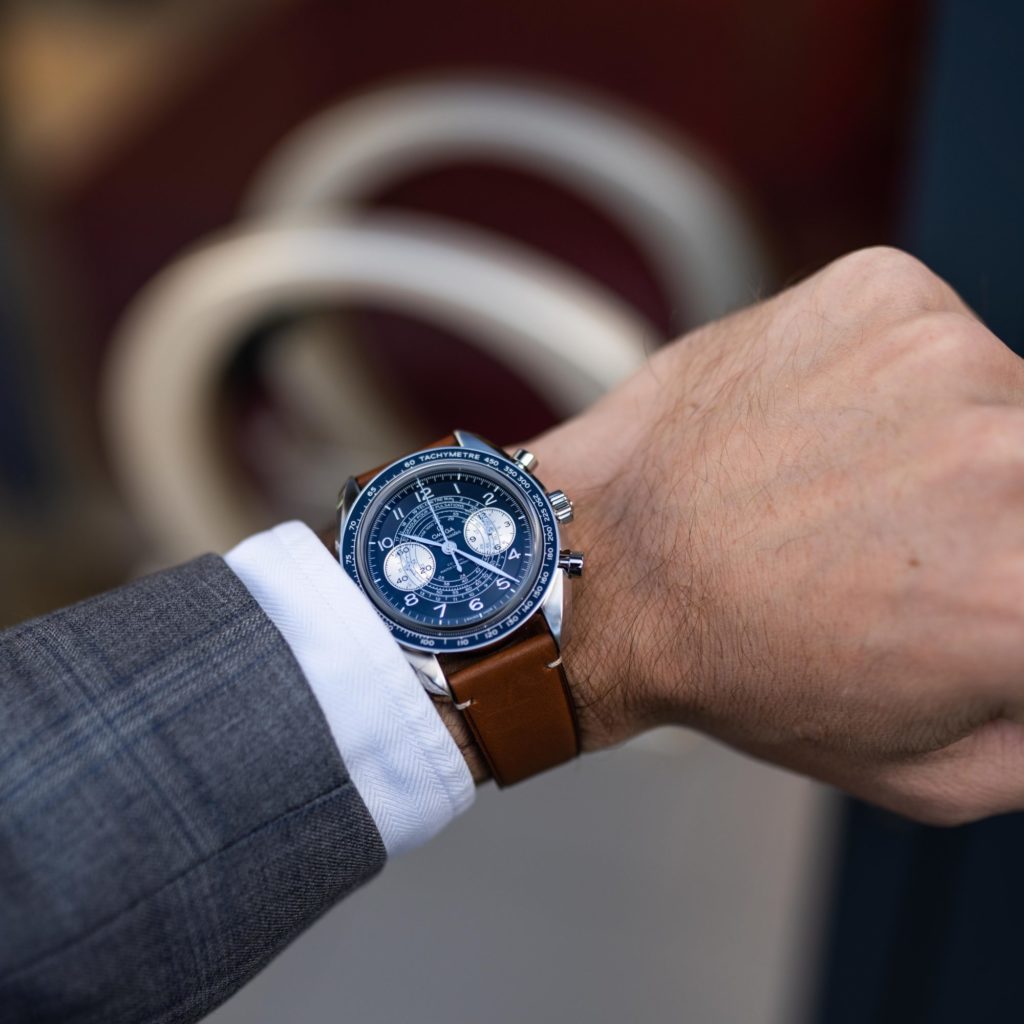
What to measure with the Speedmaster Chronoscope
Tachymeter - The Chronoscope can tell how fast you are going, based on how far you have travelled. As the scale measures the average travel time between two specific points, it makes no difference whether the journey is in miles of kilometers.
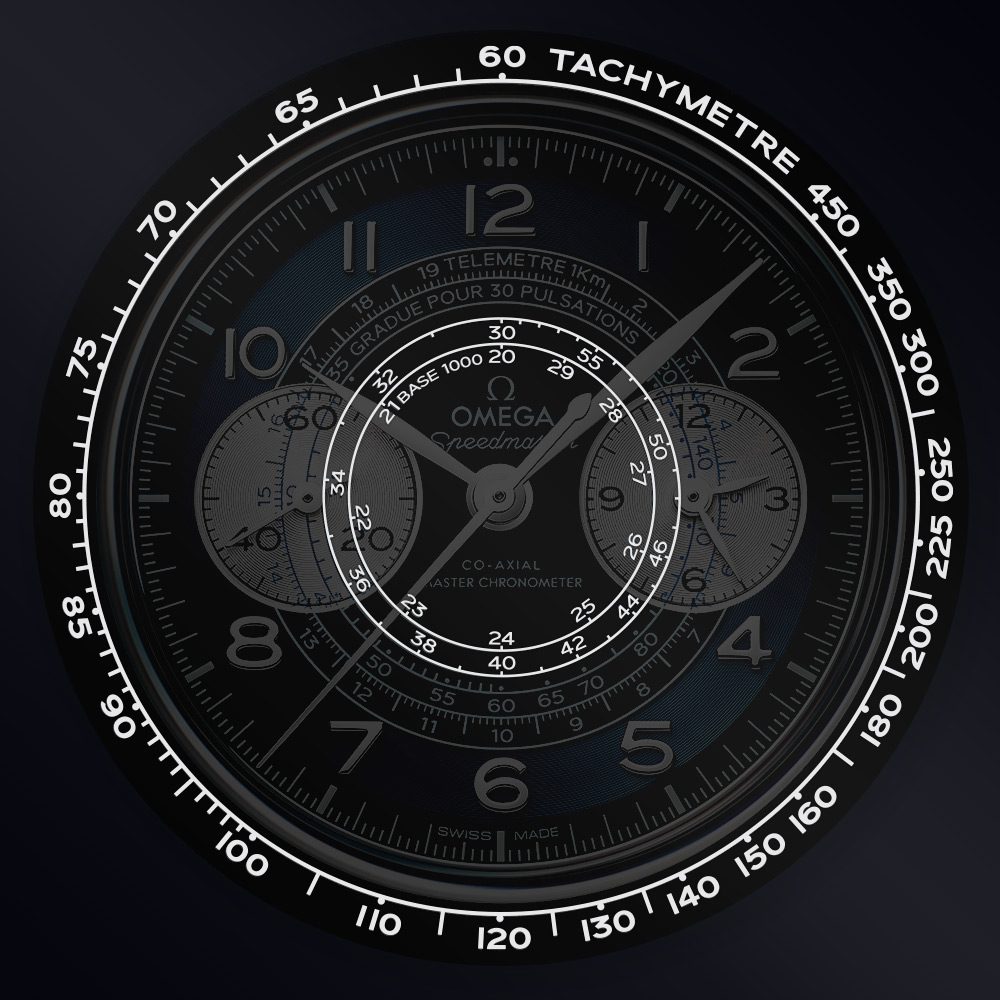
Telemeter - With a simple two-step process, OMEGA's precision tool can tell you exactly how far you are from something that is visible and audible, such as a lightning storm.
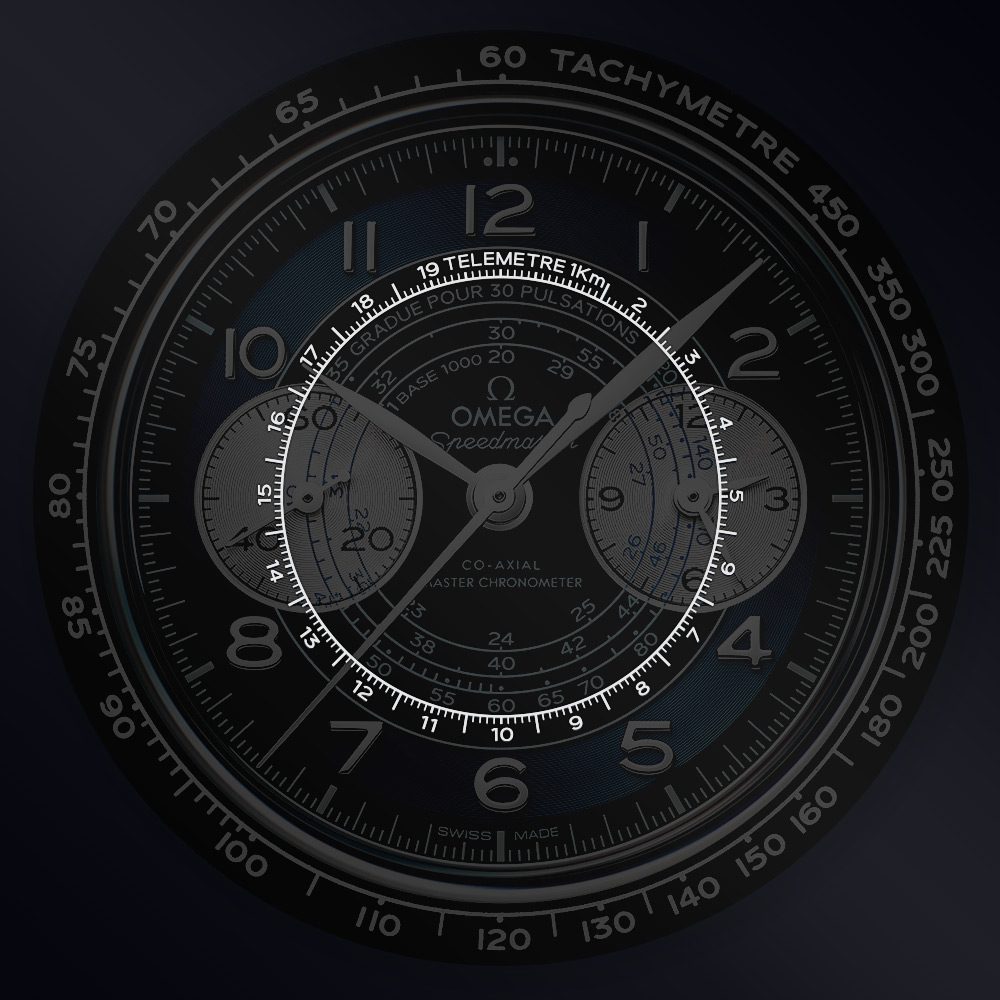
Pulsometer - Too slow, too fast, or just right? Thanks to this 30-pulse-per-minute scale, you can measure your own or someone else's heartbeat.
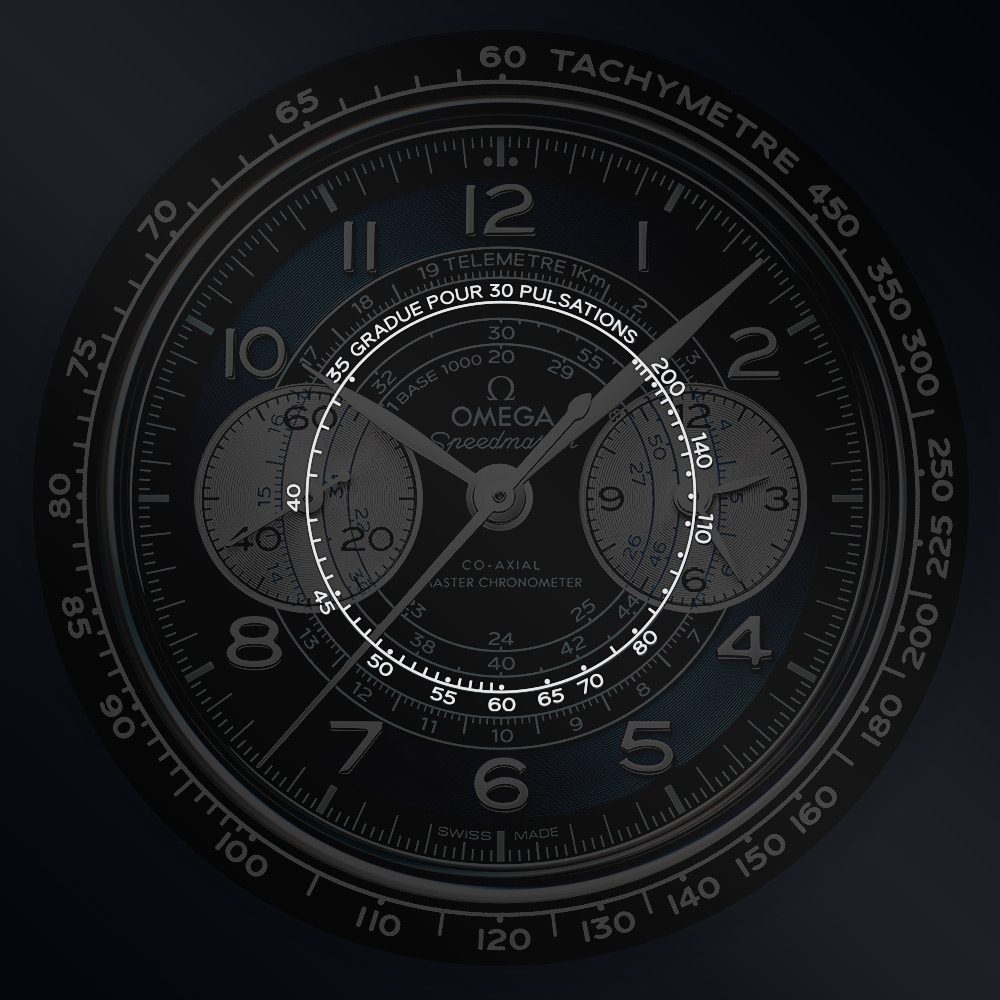
The Artworth Favorites
Among the seven watches of the new OMEGA Speedmaster Chronoscope collection, we love two models in particular. Let's have a closer look at them!
Bronze Gold on Leather
The first model has been crafted in OMEGA's exclusive Bronze Gold. Not only does this one-of-a-kind material deliver a beautiful pink hue, but it also offers incomparable corrosion-resistance. The classic look is completed with a brown leather strap, a polished brown ceramic bezel with a "vintage" enamel tachymeter scale, and an oxidized bronze dial with a special patina and opaline finish. This Reference 329.92.43.51.10.001 is beautiful, right?
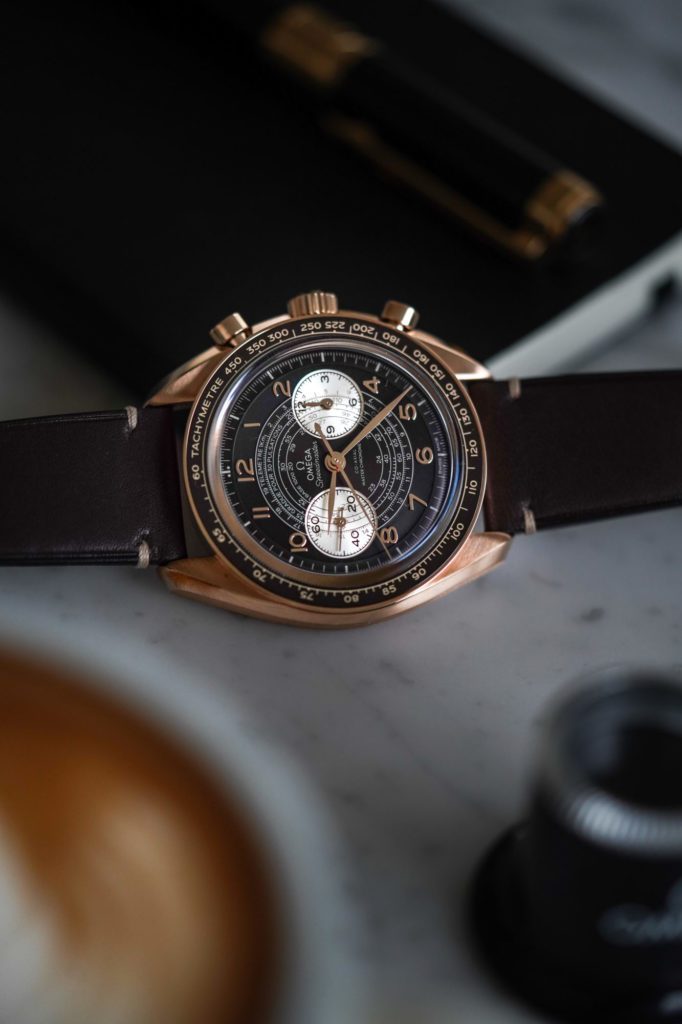
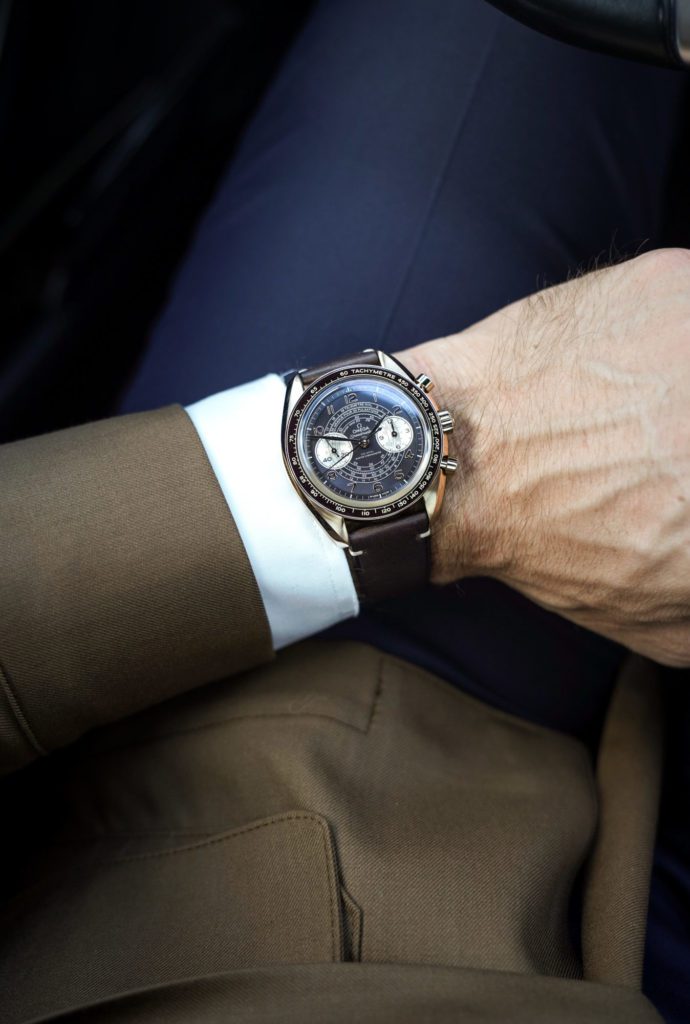
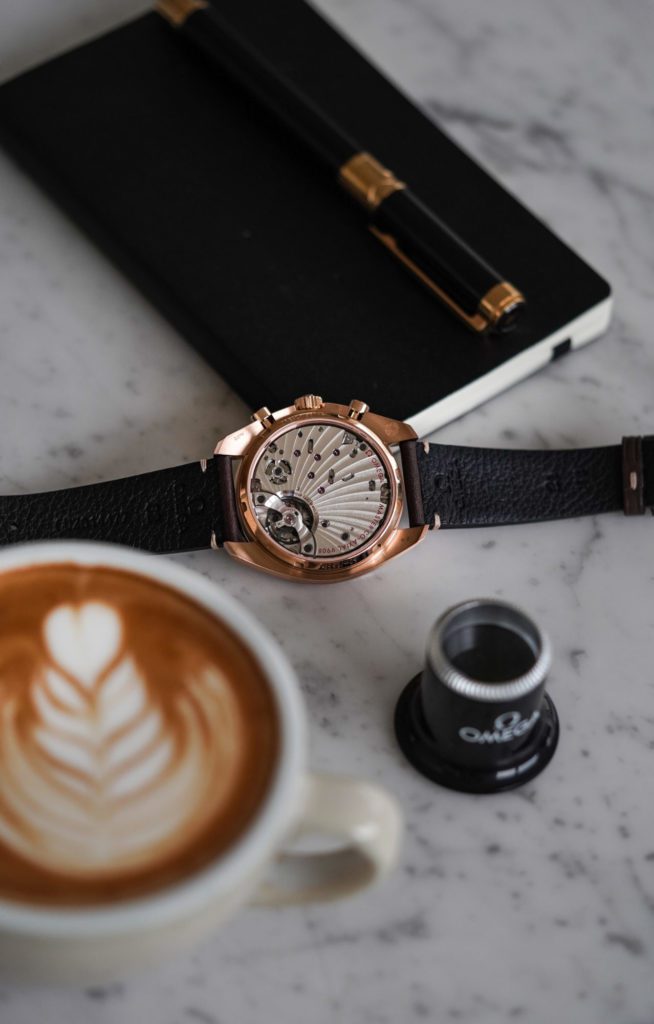
Blue Dial on Steel
The other one is crafted in stainless steel with a blue dial with silvery subdials. Along with a blue anodized aluminum bezel ring with its tachymeter scale, the leaf-shaped hands and Arabic numerals are rhodium-plated. Finally, the new Speedmaster bracelet rounds off this Reference 329.30.43.51.03.001 wonderfully!
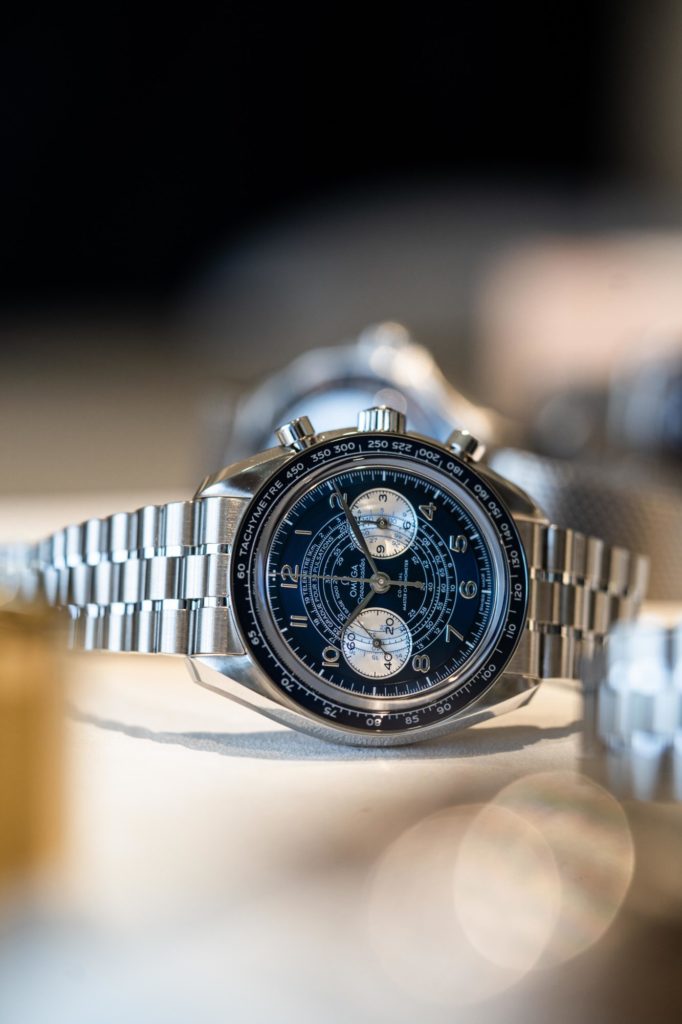
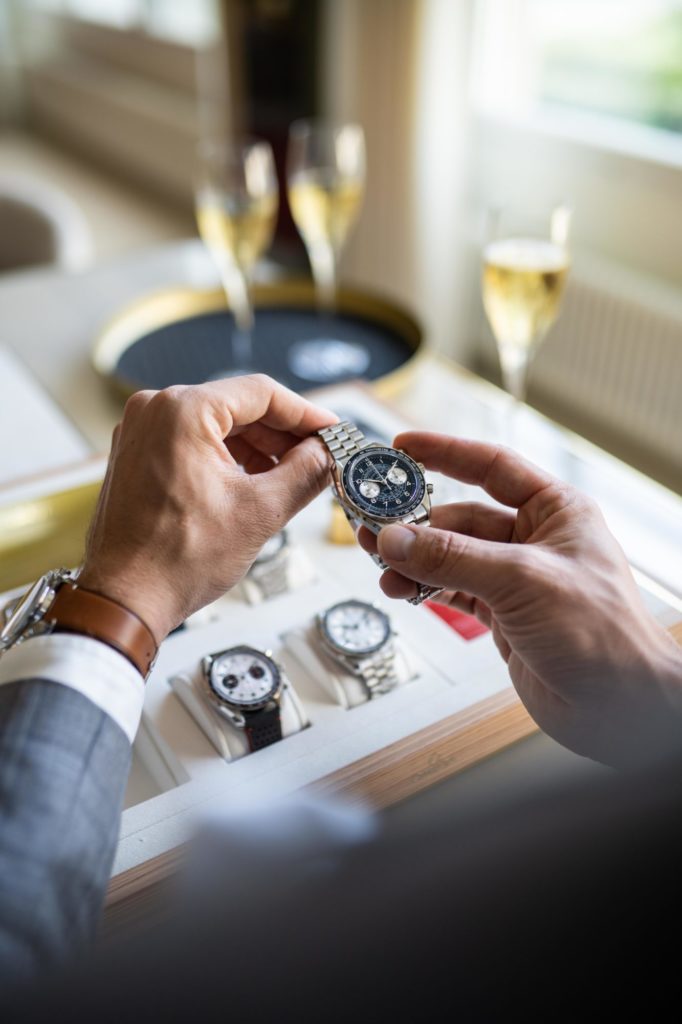
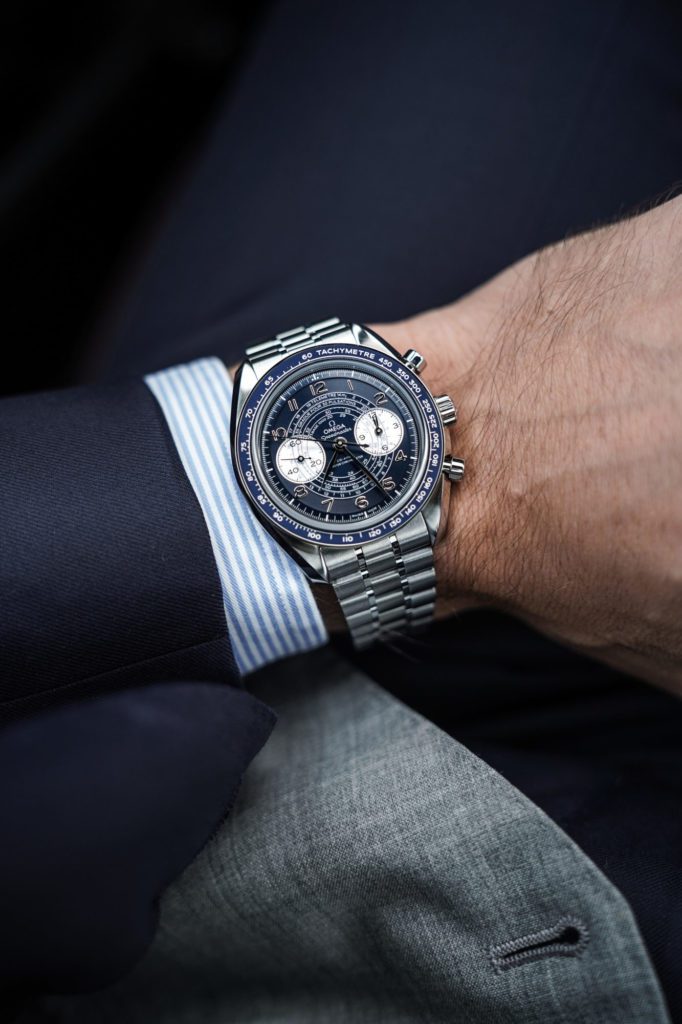
Do you want to learn more about OMEGA? Then read this article about their museum in Biel/Bienne, Switzerland.
Great watches have stories that never end, they just get better with time. The same is true for high-quality whisky and vintage champagne. That's why decided to host an evening at Bucherer CPO in Zurich for like-minded ladies and gentlemen to discover the fascinating world of certified pre-owned (CPO) watches. Read on if you want to get a glimpse too!

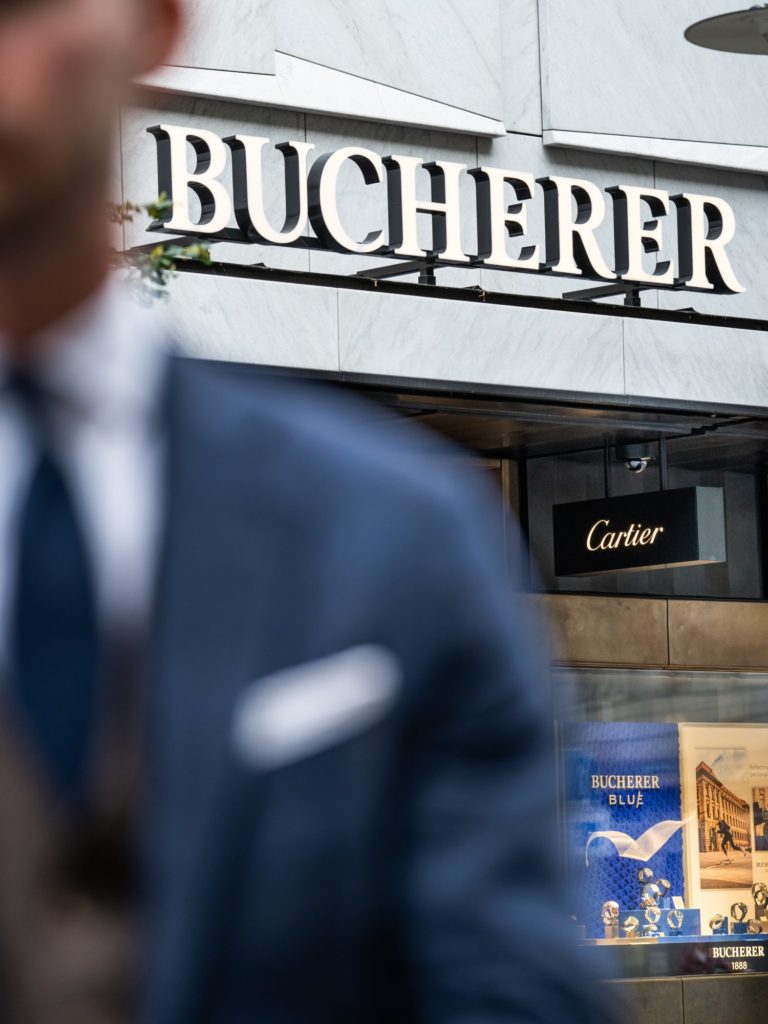

Artworth at Bucherer CPO Zurich
As soon as we announced our event at the wonderful CPO boutique on the 5th floor of Bucherer in Zurich on InstagramMany like-minded people reached out to us and asked to participate. The guest list filled up quickly and preparations began for the first-ever Artworth event open to the public.
Finally the much awaited day is here and people start to arrive at the newly renovated building of Bucherer on the well-known Bahnhofstrasse in downtown Zurich. They get welcomed with a glass of Veuve Clicquot and quickly get captivated by the many iconic timepieces that are on display. A watch that fascinates many is the Rolex GMT-Master from 1996.
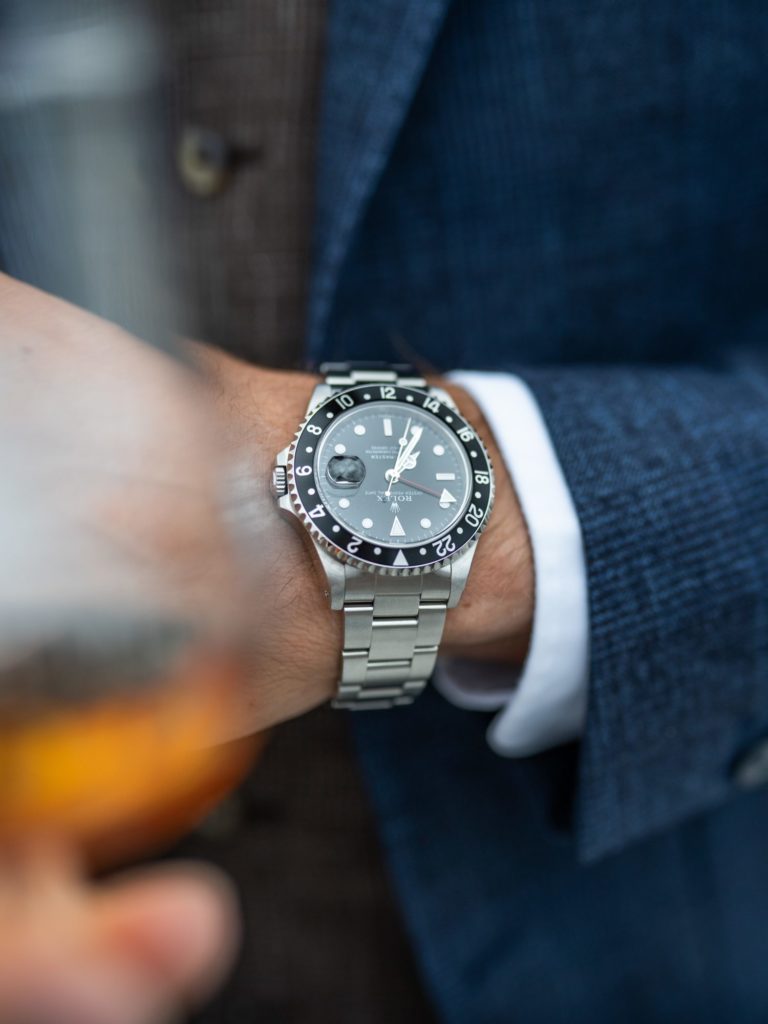
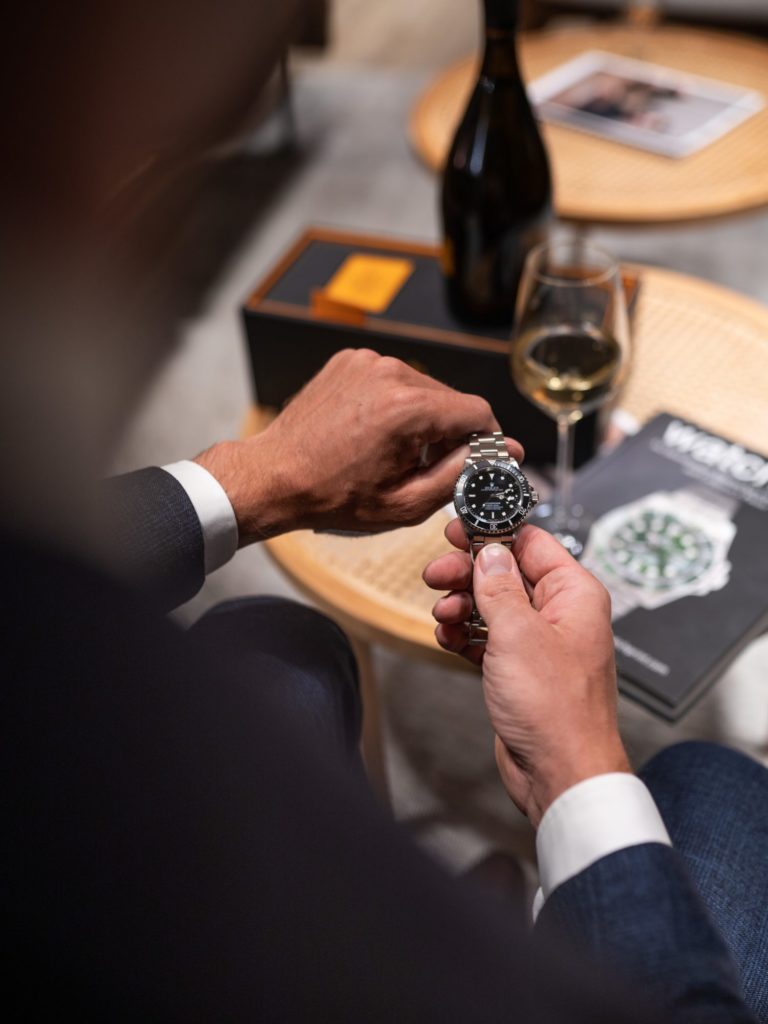

While the watches get great attention, we also have Tim from Glen Fahrn with us who invites the guests to taste some rare whiskies from Scotland, Ireland and beyond. We love the connection between pre-owed watches and a good bottle of whisky. Both get more interesting, more unique over time. A whisky we particularly enjoy is Balblair. Crafted in a small distillery in Scotland, it matured in double-fired American oak casks and offers a deep concentration of fruit notes with a hint of dark chocolate. A delight!
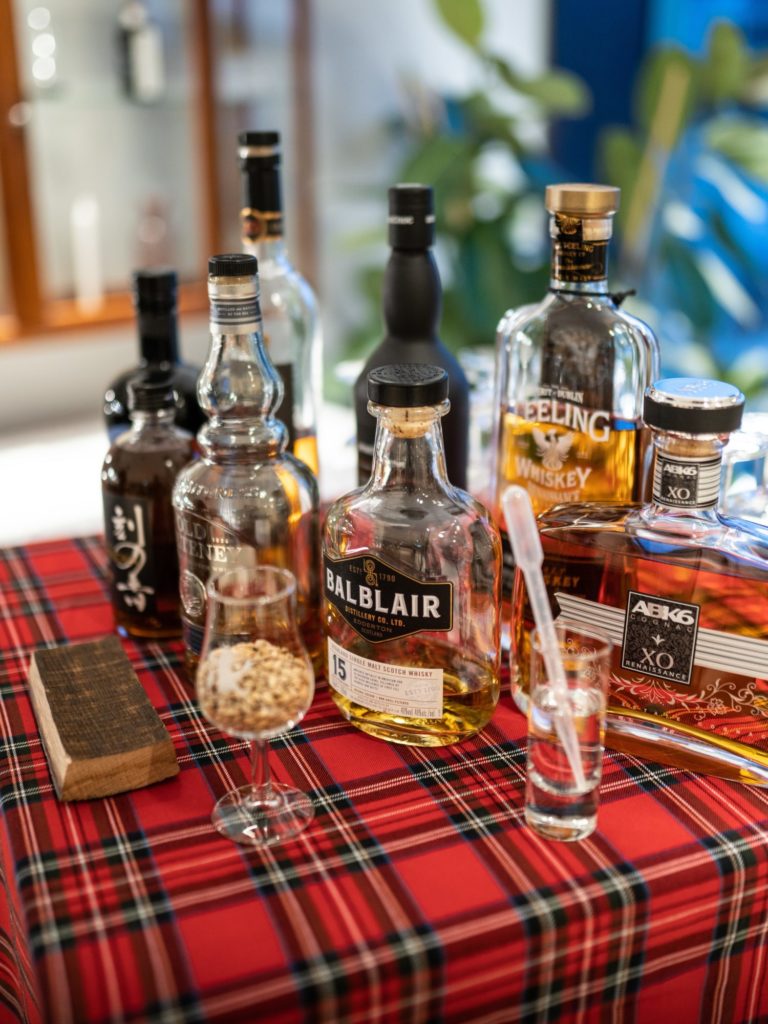
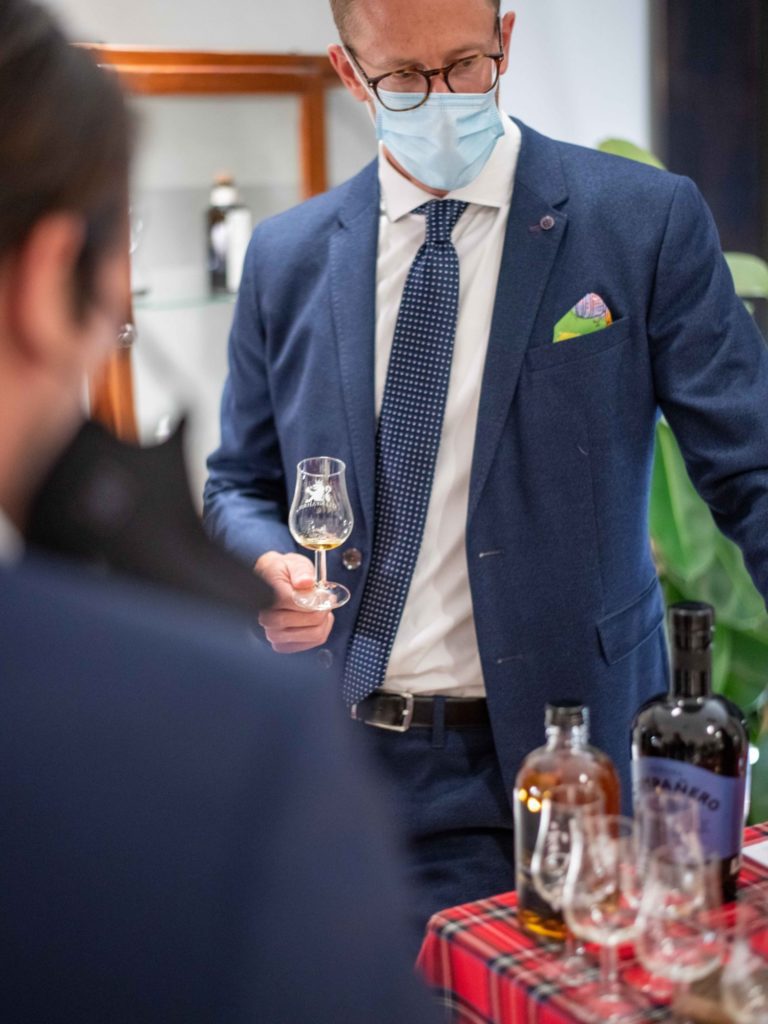
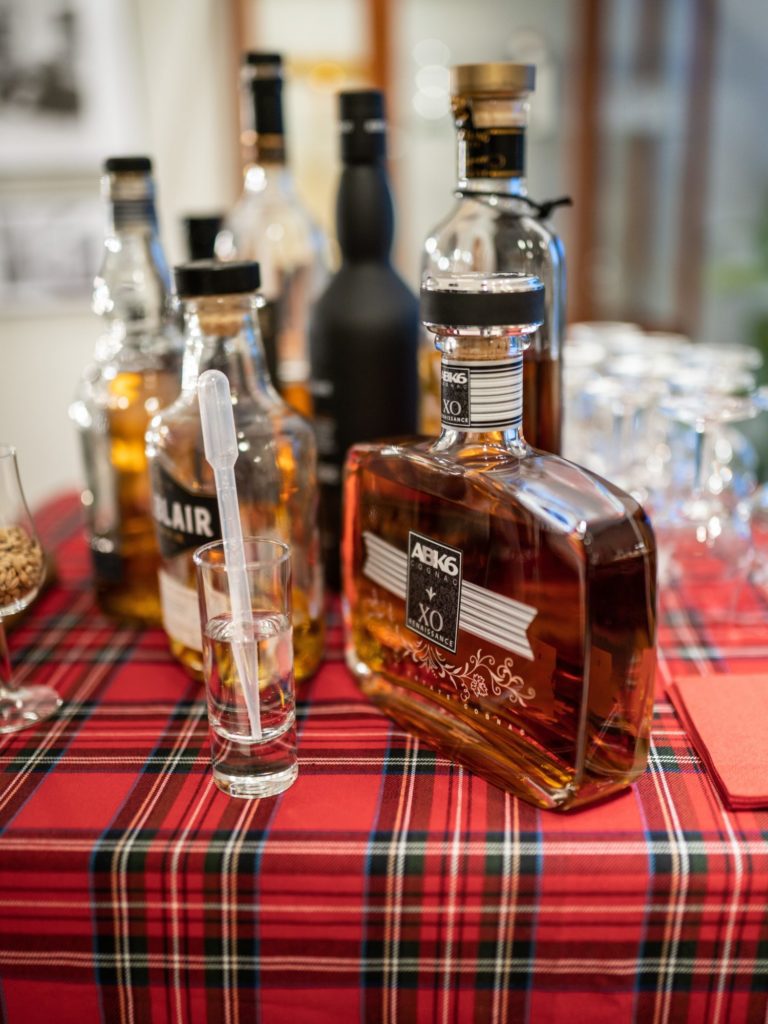
A bubbly surprise
As a first highlight of the evening, we surprise our guests with the reveal of five La Grande Dame 2008 bottles. This winemaking prowess with 92% Pinot Noir and 8% Chardonnay, really brings the Veuve Clicquot style to its quintessence, balancing strength, and elegance. Known in her lifetime as "the Grande Dame of Champagne", Madame Clicquot was a woman ahead of her time. When her husband died in 1805, she took over the reins at just 27 years of age, at a time when women had no place in the world of business. A free and ambitious woman, her signature is recognized the world over as the seal of Veuve Clicquot. This is the story of a Grande Dame, the story of a Grand Champagne.
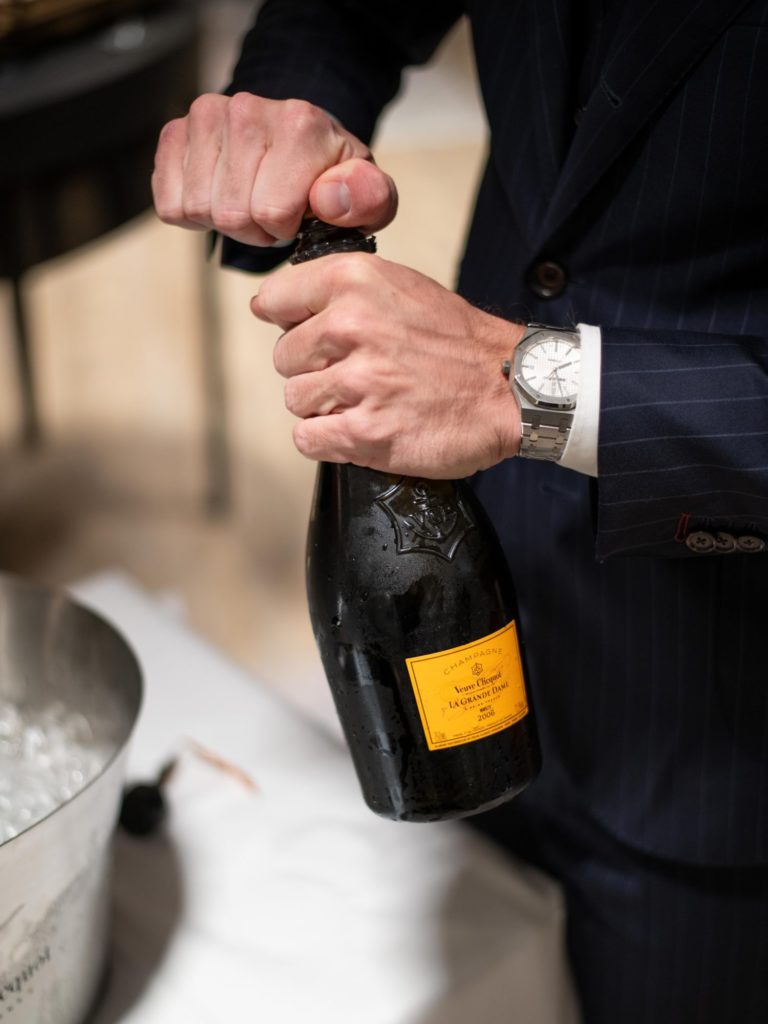


Created in 1962 and launched in 1972 to celebrate the 200th anniversary of the House, La Grande Dame is a tribute to the inspiring Madame Clicquot. To the eye, it presents a color with bright, golden glints. The initial nose reveals a strong, aerial and delicate attack. Once opened, the wine has notes of dried fruits, ripe white fruits and finishes on subtle toasted notes of hazelnut and praline. These notes create a perfect balance with the freshness and clarity of the blend. La Grande Dame 2008 has a silky texture on young fruits, supported by citrus. These characteristics make it the perfect champagne to spoil our guests with. Santé!
Ending the night overlooking Zurich
Another exciting part of the event is to talk with Keren from Amarcord. She runs a small boutique, offering made-to-measure tailor services and brought the latest winter fabrics for suits that will both keep one warm and look incredibly sharp. Keren has been tailoring some suits for us lately and we are impressed with the rare fabrics she offers. Moreover, she has set up her own supply chain, working with artisans based in Sicily.
As the sun sets, we head up to the rooftop of the Bucherer building to take in the magnificent views over the wonderful city of Zurich. It has been the perfect location for the first-ever Artworth at Bucherer event. In the heart of Zurich and surrounded by iconic timepieces, we talked about watches and suits while enjoying a glass of champagne or whisky. Who knows which city in Europe will be next!



Do you want to learn more about the Bucherer CPO offering? Read this blogpost about their Gallery in Geneva.
Did you know that one of the oldest watch brand's roots go back to 1718? In this blog we will tell exciting story of the Swiss watch brand Favre-Leuba and go hands-on with some of their novelties. Are you ready?

Taking time for Favre-Leuba
We follow an invitation of the brand's new CEO Philippe Roten to Zurich. Here, we dive into Favre-Leuba's brand universe. A carefully prepared space that awakes our adventurous spirit awaits us. Here, we soon discover that Favre-Leuba is all about conquering frontiers - both as a brand but also as a supplier of exceptional tool watches for people who dare to attempt the impossible.
Over a delicious dinner we get to know more about the latest Sky Chief Chronograph watches added to the collection of Favre-Leuba. But more about that later. We listen carefully to Philippe Roten's vision for the brand. They will continue to focus on the brand's strengths: heritage, savoir-faire, service excellence and global distribution. Talking about heritage, the brand's history goes back centuries and is truly interesting.
A unique history
In 1718, a gentleman called Abraham Favre began his watchmaker apprenticeship and was mentioned in an official document as an independent watchmaker in Le Locle as early as 1737. Later, he was even appointed Maître horloger du Locle, a high honor at that time. In 1815, the fourth generation of the watchmaker family joined forces with Auguste Leuba from Buttes in Val-de-Travers. Henry-August traveled around the world - from Germany to Russia, through Cuba to New York, from Brazil to Chile - to establish their own workshop's finely-made pocket watches in remote markets. Fritz Favre was the successor to his father and successfully pursued his expansion strategy in Europe, America, and Asia. In 1865, he traveled to India and launched his brand on the subcontinent, which was to quickly develop into an important market for Favre-Leuba.
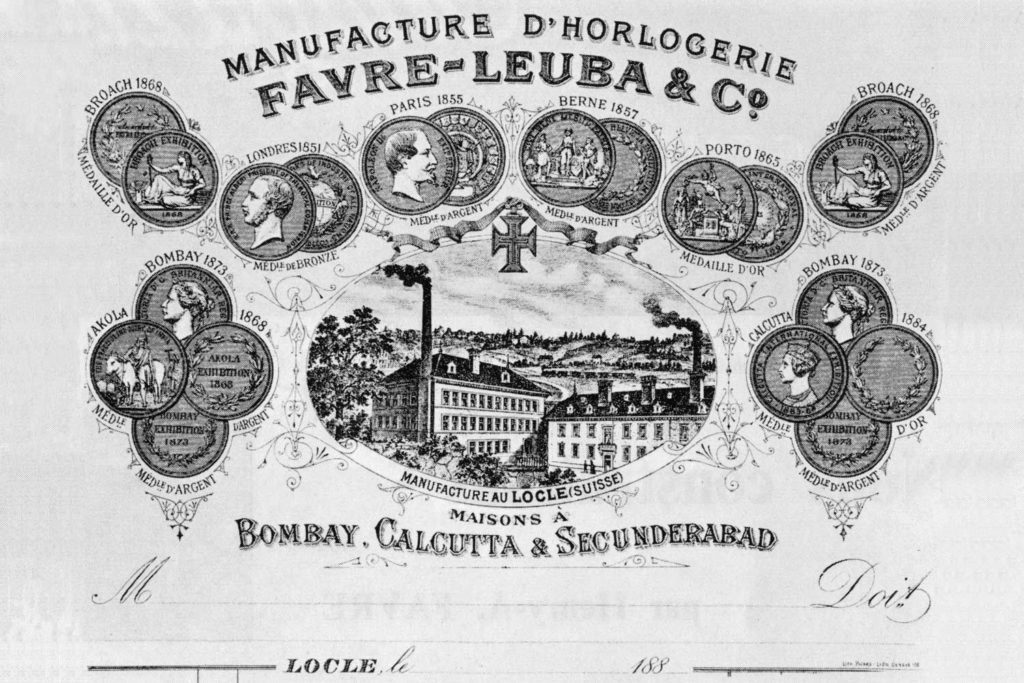
After the company headquarters were relocated from Le Locle to Geneva, Henri Favre-Leuba (1865-1961) assumed leadership of the family business and continued to steadily grow the brand. He remained president of the board of directors until his death. During his era, Favre-Leuba launched the first mono-pusher chronographs, just when wristwatches started to supersede pocket watches. After WWII, Favre-Leuba was able to count on a stable position in India thanks to their own office in Bombay. Step by step, the family company won back its position and relevance in other watch markets around the globe with branches in Hamburg, London, Rangoon, Karachi, Singapore, New York and others. They secured a well-functioning distribution with first-class customer service.
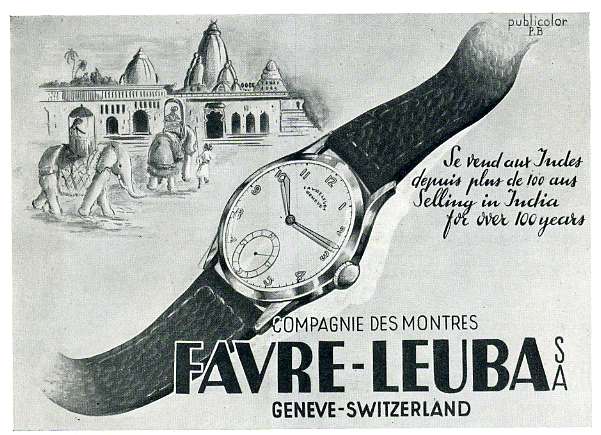
In the 1950s, Favre-Leuba introduced the manufacture caliber FL101, which was used in the Sea Chief, Sea Kingand Sea Raider watch models. It was followed by the FL102 caliber with calendar used in its Datic models. The automatic movements FL103 and FL104 soon followed, both available without or with a calendar display.
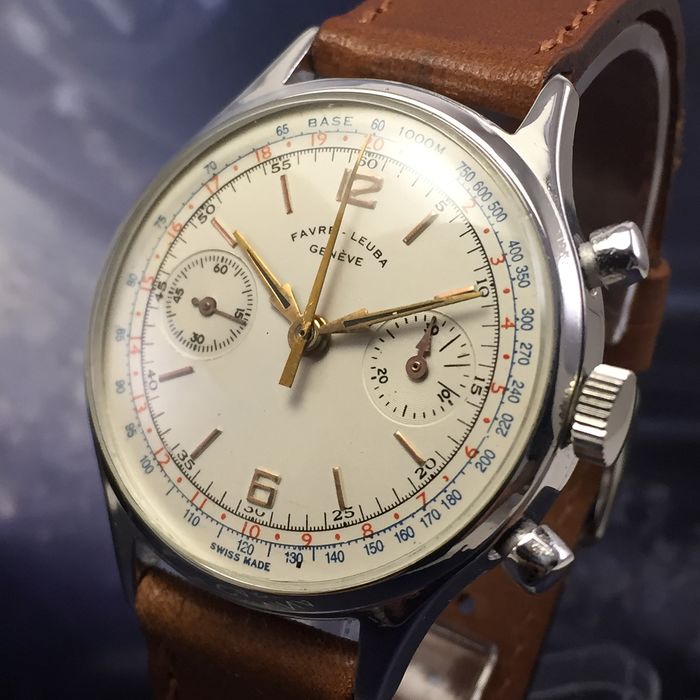
© via Catawiki 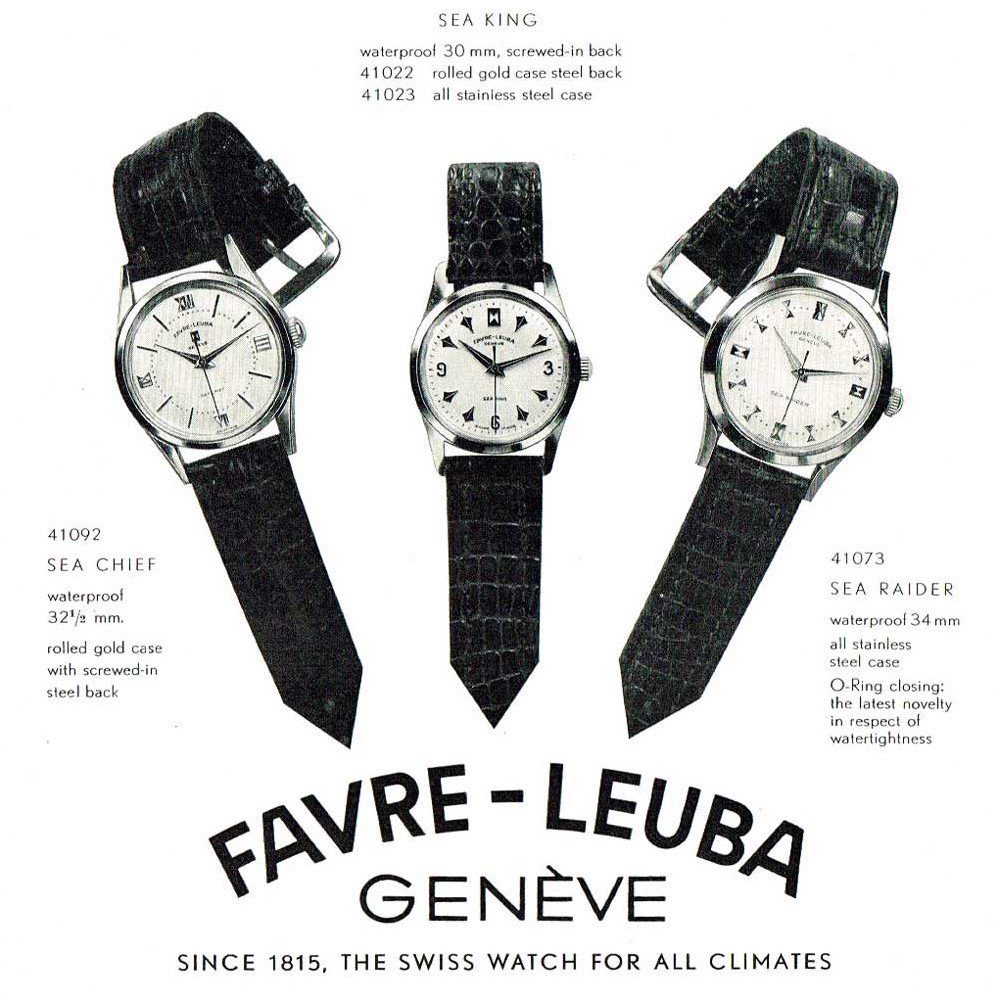
© Monochrome Watches
The biggest breakthrough came in 1960, when the very first divers watch, Water Deep, was introduced by the brand. It was the stepping stone for the success it garnered in this category. This achievement was followed by the Bivouac which was released two years later. It was the world's first mechanical wristwatch with aneroid barometer, for altimetry and air pressure measurement. It soon ranked among the indispensable equipment of those who overcame seemingly defined limits. Among others, it was the legendary Italian mountaineer Walter Bonatti who wore a Bivouac when he successfully conquered the north face of the Matterhorn on the most direct route.
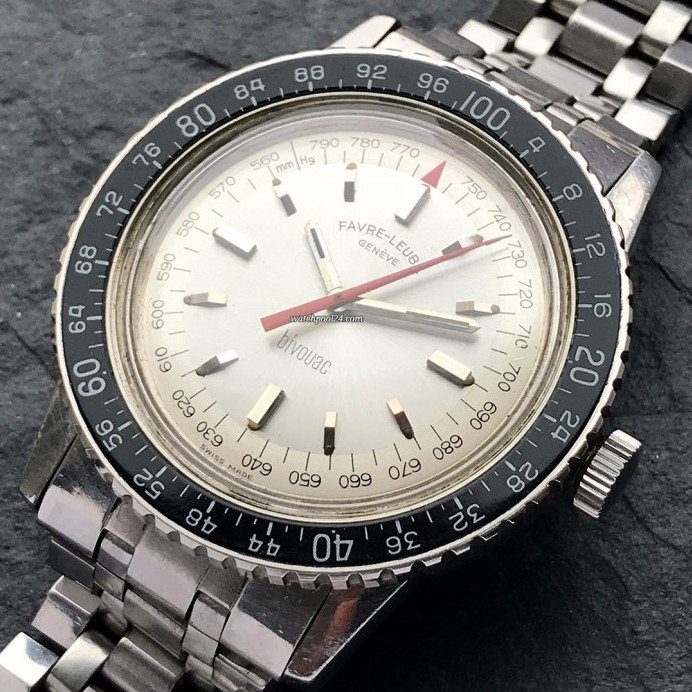
© via WatchPool24 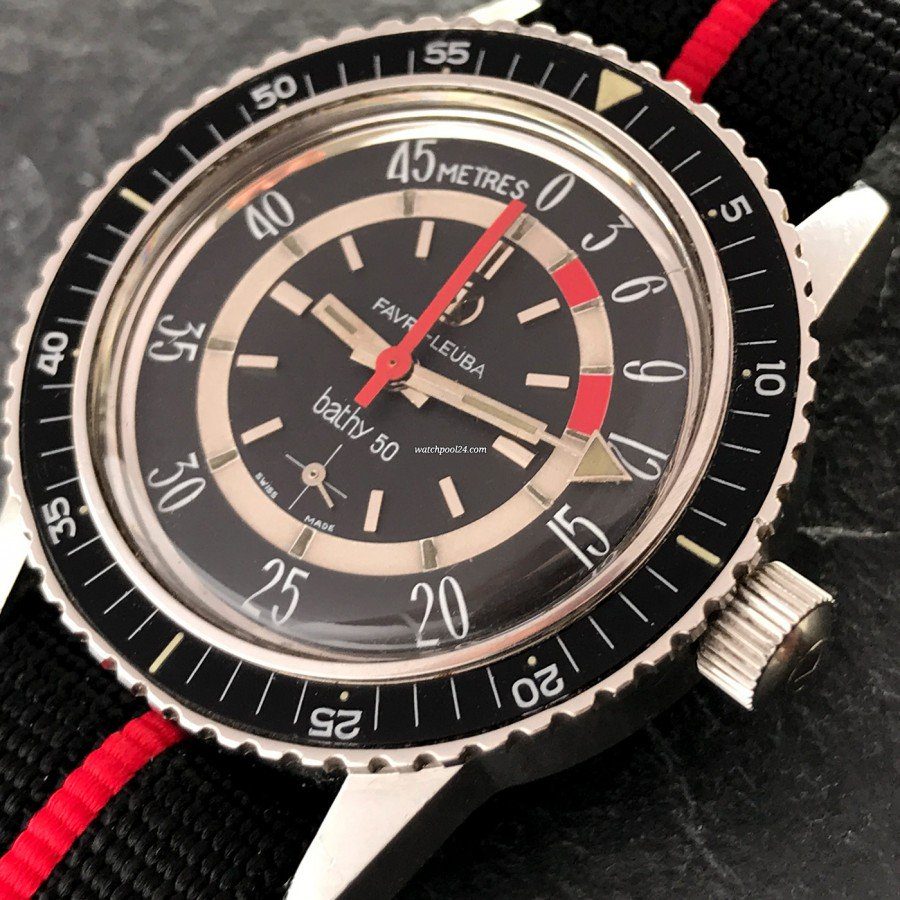
© via WatchPool24
To honor Favre-Leuba's achievements of the 1960s, the Fédération Horlogère Suisse awarded first place to them in the Chronographs and Sport Watches category at the World's Fair in Montréal. This great decade for Favre-Leuba was rounded off by the introduction of the Bathythe world's first mechanical wristwatch that not only displayed dive time, but also current diving depth.
Hands-on with the Favre-Leuba Sky Chief Chronograph
Today, Favre-Leuba follows a long-term strategy built on the historic strength and values of the brand. The result is a collection of highly functional watches based on Favre-Leuba's technical and aesthetic achievements, brought up to date with proprietary technologies and a strong, confident design, as well as a contemporary, innovative market presence. The first watches released under the new CEO of the company, are the Sky Chief Chronographs.
The watches are powered by the iconic automatic ETA Valjoux 7753 movement. It features several complications such as hours, minutes, small seconds, chronograph with 30-minute counter and date display. Housed in a 43mm stainless steel case, it is protected by a curved sapphire crystal and equipped with a screw-in crown. In total, they issued six different dial variations and offer different vintage-style suede straps and a metal bracelet.
Our personal favorite is the version with a 'panda dial'. Its porcelain white dial is contrasted by black counters and sporty red cherry indexes. The dial is finished off with Favre-Leuba's signature appliquéd index marks. At around USD 2'800, this is a wonderful timepiece with a reliable movement, embodying the world's second oldest watch brand's heritage and signature style perfectly.
Did you enjoy this article? Then click here to discover more content by the Artworth team.
What city in Switzerland is best known for watchmaking? You might want to say Geneva. While many famous watch brands are headquartered in this international city, most inventions, know-how and talents come from smaller towns in the so-called Watch Valley. One town has become particularly famous for fine watchmaking. Want to find out why it is La-Chaux-de-Fonds?
Get to know the home of fine watchmaking
What do Patek Philippe, Girard-Perregaux, TAG Heuer and Ulysse Nardin have in common? They all manufacture their calibres in La Chaux-de-Fonds (CdF)! The watchmaking city was founded as early as 1656. Since it has become the most important center of the watchmaking industry, its growth and prosperity is mainly bound up with it.

Today, the town's grid street plan reminds one of New York City because in 1794, La Chaux-de-Fonds was rebuilt after a devastating fire. Besides watches, the city is known for being the home of famous architect Le Corbusier. Also, the car maker Louis Chevrolet was born there.
The climate in the Jura is harsh. Some refer to the area around La Chaux-de-Fonds as Siberia of Switzerland. With -41°, it holds the record for the lowest temperature ever recorded in Switzerland. The trees along its main street are trimmed at a height of 1,000 meters above sea level and make CdF the highest city in Europe.
In order to withstand the harsh winters, people in La Chaux-de-Fonds had to find an additional source of income. Hence, they specialized in the craft of precision mechanics because they could complete many tasks from home. For example, families completed several parts of mechanical pocket watches at their homes, before supplying them to local workshops. There, watchmakers assembled them to functioning timepieces, which then got sold to retailers in cities like London, Paris or New York.
Jaquet Droz - The philosophy of the unique
One of the pioneers in CdF's watchmaking history was Pierre Jaquet-Droz. He was born in 1721 on a small farm but took a serious interest in clockmaking and precision mechanics. He produced a series of "grandfather" clocks featuring increasingly sophisticated movements. They soon outclassed anything that had yet been produced! He even enhanced his watchmaking movements with music and marvelous automata. It didn't take long for the wealthy and demanding clientèle to discover his extraordinary creations.
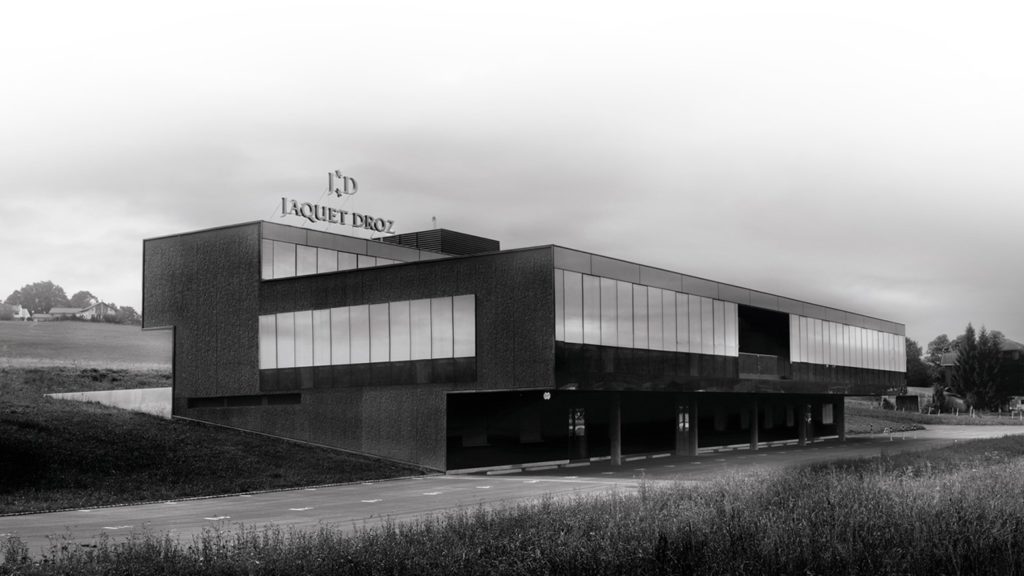
Today, Jaquet Droz is best knows for their automations and in-house Ateliers d'Art. The latter has the aim to preserve the centuries of special expertise that define the brand's identity. The meticulous work involved in miniature painting, carving, engraving and paillonnée enameling is highlighted in some exceptional pieces in their collection. For example the Magic Lotus Automaton. This masterpiece features a hand-engraved and hand-painted white mother-of-pearl dial and black onyx subdial. Its marvelous decoration in 18-karat red and yellow gold requires a lot of manual work of highly skilled professionals. Featuring a mechanical automaton movement with push-button, this masterpiece offers a magnificent mechanism animating pond, carp and lotus flower. It is the result of age-old craftsmanship!
Another classic of the brand is the Grande Secondea piece inspired by a pocket watch created in the 18th century. The hour and minute display at 12 o'clock overlapping the seconds counter at 6 o'clock. It has become the distinct look for Jaquet Droz' timepieces.
One of our favorite watches by Jaquet Droz is the sporty yet elegant looking Grande Seconde Skelet-one Ceramic. It is simplistic, clean and comes with the distinct Jaquet Droz look. Yet, the skeletonization and rather prominent crown add a sophisticated touch!
Black Etienne - Manufacture since 1902
In 1902, another watch manufacturer enters the picture. The industrialization is disrupting Europe's economy and Paul Arthur Schwarz and his wife Olga Etienne decide to go ahead and found the company Black Etienne. This La Chaux-de-Fonds based family business specializes in manufacturing mechanical movements for other watch brands or sophisticated clients such as the Vatican and Leonid Brezhnev, former President of the Soviet Union.
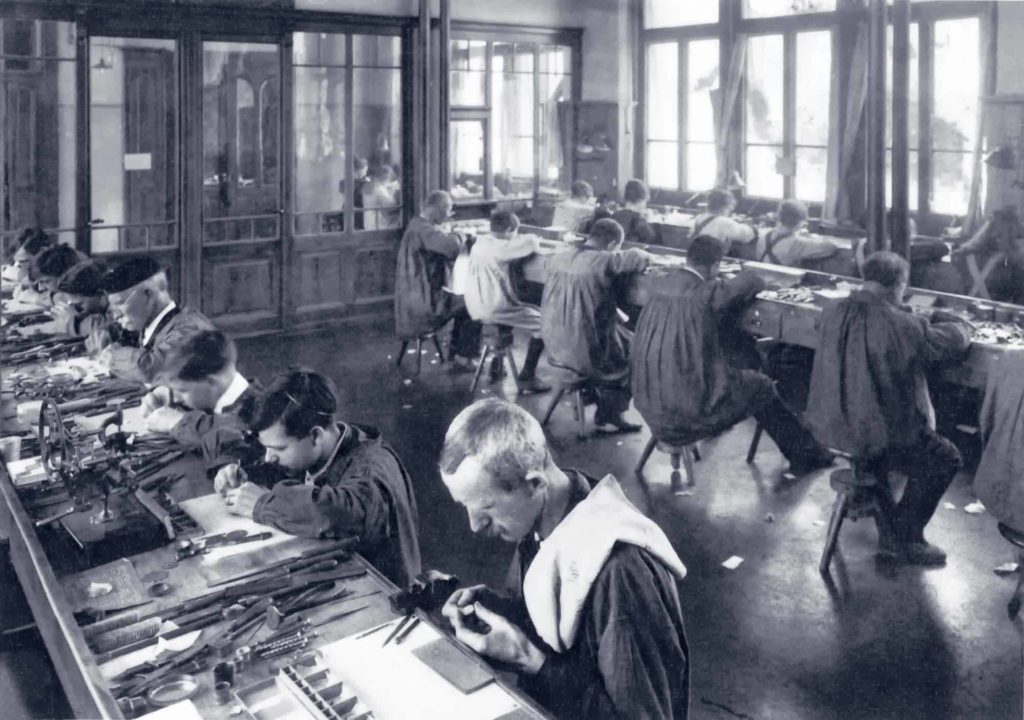
© Black Etienne 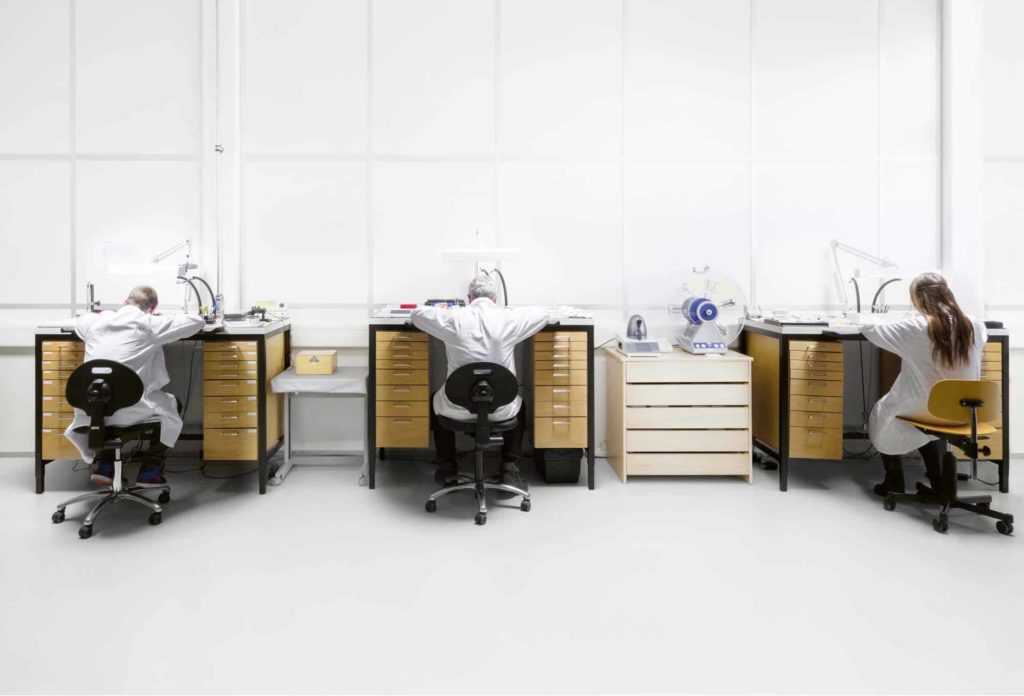
© Black Etienne
Today, Schwarz Etienne develops and sells watches under their own brand name, gradually becoming recognized as a fully-fledged manufacturer with distinct qualities: creativity, innovation and expertise!
Our favorite watch from their current collection is the Tourbillon PSR. The movement of this breathtaking timepiece is manufactured entirely in-house, even including the hairspring! Two of the main features are the small second retrograde complication at 11 o'clock and the tourbillon at 1 o'clock. In addition, it is powered by a visible micro rotor.
While the two steel versions come with either green Aventurine fine stone or blue Opal fine stone, the rose gold features Hematite Specularite fine stone. These fine details really do the trick for us!
Greubel Forsey - Art of invention
One of the latest actors to enter the stage of fine watchmaking is Greubel Forsey. They impersonate the new age of manufacturing high-end timepieces. Without a rich history to bank on, Robert Greubel and Stephan Forsey decided to dedicate themselves entirely to improving the performance of existing complications but also to invent innovative mechanisms since 2004.

In 2009, Greubel Forsey moved into their new manufacture in La Chaux-de-Fonds. It is an architectonic masterpiece! Combining a painstakingly restored farmhouse from the 17th century and the actual atelier. The latter houses the development and production workshops. Its sloping roof gives the impression that it could have risen from the ground!
Only few know that Greubel and Forsey have invented a series of new complications. With the Invention Piece 1 they open up whole new vistas for their first major invention: the Double Tourbillon 30°! Four years of meticulous research were devoted to developing this revolutionary mechanism.

While the Invention Piece 1 symbolizes a milestone for Greubel Forsey, the GMT collection has won our hearts. It displays a spinning globe as a real-time reproduction of the Earth's rotation, offering an intuitive view of time all over the world as well as a day/night indication.
The latest addition to this iconic collection is the GMT Sport. A newly developed titanium case positions this GMT in a "sports" league of its own. The limits of ergonomics and wrist comfort have definitely been pushed back with the launch of this timepiece. A totally new case form, perfectly round from above, while revealing the accentuated arched and ovoid shape from other angles, was invented for this watch. Additionally, lugs and strap were integrated in order to achieve a functional form that perfectly fits any wrist. It is definitely one of our favorite watches ever manufactured in La Chaux-de-Fonds!

We hope to have given you a comprehensive overview of the watchmaking industry in La Chaux-de-Fonds including some notable manufacturers. Get in touch with us if you are interested in knowing more about watchmaking in Switzerland!

Interested in reading more about fine watchmaking in the Watch Valley? Read this blogpost about Jaeger-LeCoultre's manufacture in the Vallée de Joux!



































